

"THIS TRAIL IS A REAL TREASURE TO OUR STATE, COUNTY, AND PEOPLE. WE WANT TO MAKE SURE THAT THIS STORY IS TOLD AND MAINTAINED OVER THE YEARS.”
~ AMBROSE MILLS, POLK COUNTY ECONOMIC & TOURISM DEVELOPMENT COMMISSION
RUTHERFORDTON >> CHESNEE
PRODUCED FOR
US National Park Service
Overmountain Victory Trail Association

Rutherford County, NC
Polk County, NC
Spartanburg County, SC
Town of Rutherfordton, NC
Tryon International Equestrian Center
RHI Legacy Foundation
PRODUCED BY
Destination by Design Planning, LLC | 136 Furman Road, Suite 6 | Boone, North Carolina 28607 | 828.386.1866 | www.DbDplanning.com
@dbdplanning @destination_by_design @dbdplanning FACEBOOK YOUTUBE
INSTAGRAM
ACKNOWLEDGMENTS
NATIONAL PARK SERVICE
John Slaughter, Group Superintendent, Southern Campaign of the American Revolution Parks Group
PROJECT OVERSIGHT COMMITTEE
Cole Alverson, County Administrator, Spartanburg County
Doug Barrick, Town Manager, Town of Rutherfordton
Chivous Bradley, Historian, Rutherford County
Don Cason, Executive Director, Rutherford County Tourism Development Authority
Aubrey Clay, Project Manager, Rutherford County Planning
Sherry Dull, Senior Transportation Planner, Spartanburg Area Transportation Study
Ben Farmer, Project Manager, Isothermal Planning and Development Commission
Steve Garrison, County Manager, Rutherford County
Terry Hines, Executive Director, RHI Legacy Foundation
Becki Hood, City Administrator, City of Chesnee
Bryant Lindsey, Board Member, Overmountain Victory Trail Association
Ben Richardson, Chief of Planning and Partnerships, Southern Campaign of the American Revolution Parks Group
OVERMOUNTAIN VICTORY TRAIL ASSOCIATION
David Down, President
RG Absher, Vice President
Tom Vaughan, Treasurer
Leigh Anne Hunter Surber, Secretary
Mark Anthony, Board Member
Donna Atkins, Board Member
Joe Epley, Board Member
John Garrou, Board Member
Don Hopping, Board Member
Garrett Jackson, Board Member
Brad Knight, Board Member
Ronnie Lail, Board Member
Steve Lockett, Director of Economic, Community, and Workforce Development, Isothermal Planning and Development Commission
Kathryn McMahon, Director of Community Engagement, Tryon International Equestrian Center
Jill Miracle, Community Impact Director, RHI Legacy Foundation
Caroline Parris, Transportation Planner, Spartanburg Area Transportation Study
D. Marche Pittman, County Manager, Polk County
Clark Poole, Director, Rutherford County Chamber of Commerce
Stephanie Rzonca, Community Development Director, Town of Rutherfordton
Danny Searcy, Planning Director, Rutherford County
Jerry Stensland, President, Rutherford Outdoor Coalition & Director, Polk County Parks and Recreation
Tom Vaughan, Treasurer, Overmountain Victory Trail Association
Joella Johnson Barbour, Board Member
Chivous Bradley, Board Member
Camille Chidiac, Board Member
Tony DeVault, Board Member
RUTHERFORD COUNTY, NC
Leon Humphrey, Mayor
Steve Garrison, County Manager
Bryan King, Commissioner
Greg Lovelace, Commissioner
POLK COUNTY, NC
D. Marche Pittman, County Manager
Tommy Melton, Commissioner, Chairman
Myron Yoder, Commissioner
SPARTANBURG COUNTY, SC
Cole Alverson, Spartanburg County Administrator
A. Manning Lynch, Council Chairman
Michael Brown, Councilman
Jack A. Mabry, Councilman
Bryant Lindsey, Board Member
Carson Sailor, Board Member
Mel McKay, Board Member
TOWN OF RUTHERFORDTON
Jimmy Dancy, Mayor
Henry C. Giles, Jr., Council Member
Christy Bare, Council Member
CITY OF CHESNEE
Max Cash, Mayor
Bruce Mahaffey, Mayor Pro-tem
Becki Hood, City Manager
Terry D. Cobb, Council Member
Stanley L. Clements, Council Member
Eddie Holland, Commissioner
Michael Benfield, Commissioner Alan Toney, Commissioner
Ray Gasperson, Commissioner
Paul Beiler, Commissioner
Jake Johnson, Commissioner
David Britt, Councilman
Whitney Farr, Councilman
Bob Walker, Councilman
Roger Allen Nutt, Councilman
Doug Pye, Council Member
Verhonda Crawford, Council Member
Robert Johnson, Council Member
ISOTHERMAL PLANNING AND DEVELOPMENT COMMISSION
Scott Dadson, Executive Director
RHI LEGACY FOUNDATION
Terry Hines, Executive Director Jill Miracle, Community Impact Director
TRYON INTERNATIONAL EQUESTRIAN CENTER
Katherine McMahon, Director of Community Engagement
LANDOWNER OUTREACH VIDEO INTERVIEWEES
Senator Jim Broyhill
Superintendent John Slaughter, National Park Service
Ambrose Mills, Chair, Polk County Economic & Tourism Development Commission
Jerry Stensland, Director, Polk County Parks and Recreation & President, Rutherford Outdoor Coalition
Albert Mossburg, MD, Community Member
Chivous Bradley, Historian, Rutherford County, NC & Boardmember, OVTA Jack Mabry, Council Member, Spartanburg County, SC
Terry Cash, Landowner
TABLE OF CONTENTS
INTRODUCTION 1
Background 2 Plan Goals 3 Planning Process 4 Plan Organization 5
CHAPTER
1: EXISTING CONDITIONS, ANALYSIS, AND PRELIMINARY ALIGNMENTS
Study Area Description 8 The Natural Environment 10 The Built Environment 14
Map And Photo Series: Preliminary Trail Route Alternatives 19
CHAPTER 2:
LANDOWNER ENGAGEMENT
27
Identifying the Landowners 28 Landowner Communications 29 Landowner Workshop 30 Trail Route Re-Evaluation 32
CHAPTER 3: TRAIL CHARACTER & DESIGN GUIDELINES
7
CHAPTER 4:
RECOMMENDATIONS
39
Planning Sections Overview 40 Trail Section Recommendations 42
CHAPTER 5:
IMPLEMENTATION
63
Implementation Details by Planning Section 64 Implementation Focus Areas 65 Trail Type Profile 66 Trail Support Spectrum 68 Economic Impact Analysis 69
APPENDIX 71

(A1) Budget 72 (A2) Landowner Invitation 74 (A3) Landowner Interest Survey 74 (A4) Funding Sources 75 (A5) NC S.L. 2019-20 HB 532 76 (A6) The National Trails System Act 79
33
Trail Types 34
Signage and Wayfinding 36
Social Media: The New Word of Mouth 38
vii

viii
LIST OF MAPS LIST OF EXHIBITS
Map 1: OVNHT Planning Areas 2
Map 2: General Study Area 8
Map 3: Study Area 1 Site Analysis 20
Map 4: Study Area 2 Site Analysis 22
Map 5: Study Area 3 Site Analysis 24
Map 6: Landowner Map Sample 28
Map 7: Landowner Sentiment 32
Map 8: Planning Sections Overview 40
Map 9: Planning Section 1 43
Map 10: Purple Martin Connection 46
Map 11: Planning Section 2 49
Map 12: Planning Section 3 53
Map 13: Tryon Equestrian Center 54
Map 14: Planning Section 4 57
Map 15: Planning Section 5 59
Map 16: Implementation Focus Areas 65
Map 17: Economic Impact Market 69
Exhibit 1: Bradley Nature Preserve 13
Exhibit 2: Social Media: The New Word of Mouth 38
Exhibit 3: Kiwanis Park Master Plan 44
Exhibit 4: Trail to Victory Council Ring @ Kiwanis Park 45
Exhibit 5: Monfredo One-Way Conversion 47
Exhibit 6: Grays Road River Access and Trailhead 50
Exhibit 7: Trailhead @ Bradley Nature Preserve 51
Exhibit 8: Overmountain Vineyards 55
Exhibit 9: SC-11 Sidepath 60

Exhibit 10: CADA Park 61
Exhibit 11: Planning Section Implementation Matrix 64
Exhibit 12: Focus Area Implementation Matrix 65
Exhibit 13: Trail Type Profile 66
Exhibit 14: Trail Support Spectrum 68
Exhibit 15: Economic Impact Analysis 69
ix
INTRODUCTION
The Overmountain Victory National Historic Trail is APPROXIMATELY 270 miles in length and is located in portions of Virginia, Tennessee, North Carolina, and South Carolina. The Trail commemorates the significance of the patriot militia that marched from the Appalachian Mountains and their foothills to defeat the British-led loyalist army at the Battle of Kings Mountain on October 7, 1780.
This Trail Master Plan serves as a road map for establishing a section of the Overmountain Victory National Historic Trail (OVNHT) From Rutherfordton, NC to Chesnee, SC.

BACKGROUND


This project is part of ongoing efforts by the National Park Service (NPS) to develop regional trail master plans in order to strengthen multi-jurisdictional partnerships and engage landowners to expand and connect the growing network of certified OVNHT segments throughout Virginia, Tennessee, and North and South Carolina.
In 2019, the National Park Service, Town of Rutherfordton, Tryon International Equestrian Center, RHI Legacy Foundation, and Rutherford, Polk, and Spartanburg Counties partnered to fund a comprehensive master plan for the OVNHT from Rutherfordton, NC to Chesnee, SC.

























It is expected that trails developed along recommended routes within the plan study area will be eligible for certification by the NPS as part of the official Overmountain Victory National Historic Trail non-motorized route.
STATE TRAIL DESIGNATION
In June of 2019, NC Governor Roy Cooper signed S.L. 2019-20 into law, authorizing the Overmountain Victory Trail as a designated State Trail within the NC State Parks system. The North Carolina Trails System Act (GS 143B- 135.90) defines a State Trail as a linear corridor on land or water, separated from vehicular traffic, providing public access for non-motorized recreation or transportation.
As units of the NC State Parks system, State Trails are distinguished from other regional and local trails, by offering opportunities for regional connectivity and public access.
While a State Park is operated and managed by the NC Division of Parks and Recreation (NCDPR), a State Trail is comprised of multiple trail sections that are sponsored by state or federal agencies, local governments, non-profit organizations, and landowners. NCDPR provides guidance, coordination, and assistance for the section sponsors. The sponsors build, maintain, and manage their section of the trail deciding on location, design, surface, permitted uses, and amenities.
MAP 1: OVNHT PLANNING AREAS
THIS PLAN'S STUDY AREA
This plan's study area examines Section 9 of the OVNHT and incorporates
THE SISTER PLAN
THE SISTER PLAN
This trail plan was developed in conjunction with another Overmountain Victory National Historic Trail master plan that extends from Spruce Pine, NC to Lake James.
COMPLETED MASTER PLANS
This trail plan was developed in the same spirit as five other OVNHT Master Plans completed from 2015 - 2018: Abingdon to Elizabethton (Section 1); Lake James to Morganton (Section 4); Elkin to W. Kerr Scott Reservoir (Section 5); Lenoir to Morganton (Section 7); and Chesnee to Kings Mountain (Section 10). The NPS is working to develop similar plans for all areas included within the congressionally-designated OVNHT corridor.
2
SC NC VA TN N RUTHERFORDTON TO CHESNEE MORGANTON TO RUTHERFORDTON ELIZABETHTON TO SPRUCE PINE ABINGDON TO ELIZABETHTON W KERR SCOTT RESERVOIR TO LENOIR LENOIR TO MORGANTON SPRUCE PINE TO LAKE JAMES CHESNEE TO KINGS MOUNTAIN ELKIN TO W KERR SCOTT RESERVOIR LAKE JAMES TO MORGANTON 40 Spruce Pine Morganton Lenoir Chesnee Elizabethton Abingdon Elkin 77 85 26 Rutherfordton 40 77 26 W Kerr Scott Reservoir Lake James Kings Mountain National Military Park 1 2 3 4 7 8 9 10 6 5
Chesnee, SC.
This trail study area spans from Ruth erfordton, NC to
29 miles
Chesnee,
of trail corridor from Rutherfordton, NC to
SC.
PLAN GOALS LANDOWNER OUTREACH IS
Specific Trail Routes. Identify a specific and feasible trail route within or near the known historic corridor of the Overmountain Victory Trail as determined by NPS.

Landowner Outreach. Make a direct appeal to landowners identified during the analysis phase and record their sentiments for providing a trail easement.
Visual Plan. Create a visual plan that provides renderings and schematics to demonstrate trail character.
Support Other Community Goals. To the extent possible, identify opportunities to leverage the trail to further other community goals, including economic development, historic preservation, public health, and environmental stewardship.
Social Media. Incorporate modern social media marketing tools within the trail and signage infrastructure to promote the development of “user generated” marketing content.

INTRODUCTION 3
1 3 5 2 4
A
OF THE OVNHT PLANNING PROCESS.
CRITICAL COMPONENT
Direction Setting and Project Launch | May 2019
The consultant team met with local trail and government leaders to generally discuss environmental constraints and opportunities for trail connectivity.
Research

| May-August 2019
The consultant team conducted a thorough site analysis of the study area and determined feasible trail route options. With the trail routes identified, a landowner contact list was developed.

PROCESS
Landowner Outreach | August-September 2019
Landowners with property along an identified feasible trail route were invited to a special meeting to learn more about the trail project. After receiving comments from landowners, the preferred trail route was revised accordingly.



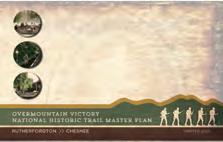




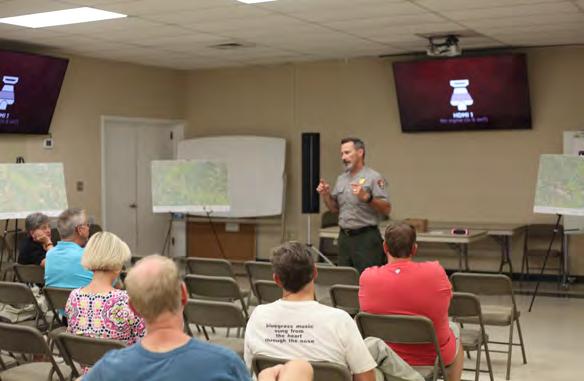

Plan Development | October-December 2019

The consultant team worked in tandem with local leaders to develop a preferred trail alignment. Renderings and schematics were provided to visually support the trail recommendations.
Final Plan Preparation | December-March 2020
The final plan is published for review by stakeholders, elected officials, and the public.
4 MAY ‘19MAY - AUG. ‘19AUG. - SEPT. ‘19OCT. - DEC. ’19 • Kick Off • Facilitating Planning Oversight Committee DIRECTION SETTING & PROJECT LAUNCH • Physical Inventory • Physiographic Analysis • Natural Inventory • Points of Interest & Structures • Environmental • Infrastructure & Utilities • Video Development • Public Meeting & Engagement • Landowner Outreach Workshops • Design Alternatives • Wayfinding & Structural Elements • Branding • Opinion of Probable Cost • Route Feasibility • Landowner Follow-up RESEARCH AND PRELIMINARY ANALYSIS PUBLIC ENGAGEMENT & LANDOWNER OUTREACH DRAFT PLAN, DESIGN CONCEPTS, COSTS DEC. ‘19 - MARCH ’20 • Funding • Implementation FINAL DRAFT DEVELOPMENT project timeline BROADRIVER HENSONS CREEK CHARLESCREEK LONGBRANCH RIVER GREENRIVER 221 1302 Island 1145 1141 Baber KenMiller 1150 1126 John Watson 1101 Shiloh Stacey 1118 1128 1139 Cleghorn 1143 2196 1360 1130 Lee Cudd Creek DarkCorner 1133 2171 1363 Belt Weeks 1153 1147 Hopper 1127 River Crest Martin Moonlight 1134 SolenWilliams Creek Church Lyles Pond Camp LongBranch 1131 HiddenKnoll 2195 Crowe Dairy Gum Meadowbrook 1361 1358 HesterMill McMurray County Line Bess Dobbins RiverRidge Owens Wagon Boyd Hooper Capps Bishop Arrow Chatham Biddy Sycamore Rosey Sunset StoneHedge KingPlantation Butcher Hollar Brady Hampton Blackwood Heliport Bluebell Holly Forest Honeysuckle Wilderness Bluesky Alden Fireside WildCherry Tool Ridge WindyKnoll Honey Wagon Horseshoe Plantation Baber POLK RUTHERFORD
PLANNING
1. 2. 3. 4. 5.
Chapter I.
Existing Conditions, Analysis, and Preliminary Alignments

PLAN ORGANIZATION
Chapter II.

Landowner Engagement
Chapter III.
Trail character & Design guidelines



This chapter provides a comprehensive overview and analysis of the opportunities and constraints found throughout the study area. The analysis begins with a brief description of the study area followed by a comprehensive discussion of the natural and built environments and their implications for trail suitability, permitting, and costs. This chapter concludes with a map and photographic series that highlights a host of preliminary trail route alternatives.


Significant efforts were made to reach out to landowners where the preliminary analysis (results from Chapter I) indicate that the trail is most suitable. This chapter outlines the process and results of landowner outreach, including a map illustrating landowner sentiment.


















This chapter is dedicated to visually defining the various trail types to be used throughout the corridor. Also, design concepts are provided for all types of trail user orientation signage, mile markers, historic markers, and other trail support facilities.

Chapter IV.
Recommendations
The fourth chapter breaks the study area into five (5) planning sections. Each planning section includes a map that displays a preferred alignment. Each planning section further incorporates the analysis and design elements from the previous chapters along with a host of supporting renderings and design schematics.
Implementation Chapter V.
This chapter provides a summary of implementation priorities organized by planning section and focus area. Chapter 5 concludes with an economic impact analysis.
INTRODUCTION 5
VICINITY MAP VICINITY MAP
30’ PREFERRED BUFFER TO RIVER TO PROTECT WATER QUALITY 10’ PAVED ASPHALT
MILE MARKER
FENCING TO MARK PRIVATE PROPERTY BOUNDARY
186 835 55 Jonas Lail Rutherfordton Folk Studebaker Cooley Springs School Parris Dillon FishCamp Peach Shed Jess Lamb BigIsland Kirk LambsGrill Airport WoodsFarm SwoffordRidge 104 Overhead Bridge Pleasant McKinney Wall Sanders Bradley Adams Circle Julie Scruggs State Line Tuscany HorseCreek Turner Pond View Mossburg Cartee Ravencrest HudsonCooley DeerRun Perez Blue Dawn Strawberry Lowe Ledford Grove BUCK CREEK CUDDS CREEK EZELL BRANCH ARROWOOD BRANCH ROCKY FORD BRANCH LITTLE HORSE CREEK GREENES LAKE N.C. S.C. POLK COUNTY SPARTANBURG COUNTY CHEROKEE COUNTY PROPOSED ROUTE FROM CHESNEE TO KINGS MTN. PLANNING SECTION CHESNEE N SECTION
STATE LINE CHESNEE 0.5 1 2 3 4 5 6 7 8 9 10 11 12 13 CADA PARK TRAILHEAD
5

6
CHAPTER 1
EXISTING CONDITIONS, ANALYSIS, AND PRELIMINARY ALIGNMENTS

this chapter features An OVERVIEW AND ANALYSIS OF THE OPPORTUNITIES AND CONSTRAINTS FOUND throughout THE STUDY AREA.
The analysis begins with a brief description of the study area followed by a comprehensive discussion of the natural and built environments and their implications for trail suitability, trail design features, permitting, and costs. This chapter concludes with a map and photographic series that highlights a host of preliminary trail route alternatives.
IN THIS CHAPTER
A. Study Area Description
B. Natural Environment Analysis
C. Human/Built Environment Analysis
D. Map and Photo Series: Preliminary Trail Route Alternatives
STUDY AREA
GENERAL STUDY AREA DESCRIPTION:

























in accordance with the ovnht comprehensive management plan , the rutherfordton , nc to chesnee sc study area is anchored by the one - mile wide historic corridor . the corridor spans a half mile on either side of what is known to be the historic route of the overmountain men . this planning corridor was determined to allow for changes in the historic route based on prevailing research , as well as to allow for a continuous adjusted route in response to constraints of the modern built environment . the study area extends approximately 29 miles from the thermal belt rail trail at u . s . hwy 64 in rutherfordton , nc to cada park in chesnee , sc . the corridor extends southwest from the thermal belt rail trail and downtown rutherfordton along nc hwy 108, turning south toward bradley nature preserve and tryon international equestrian center . the corridor turns southeast at chesnee highway to continue to downtown c hesnee . t he corridor traverses large undeveloped tracts of land in southwest r utherford c ounty and northeast polk county . small developed parcels line the corridor near rutherfordton , along chesnee highway and in chesnee . the study area ’ s topography consists largely of rolling foothills throughout . the study area includes approximately 3.1 miles of existing ovnht located in downtown rutherfordton , at the bradley nature preserve , and within overmountain vineyards .
The 29-mile study area begins at the Thermal belt rail trail, north of downtown rutherfordton, NC and ends at cada park in downtown chesnee, SC.
CHESNEE RUTHERFORDTON CHEROKEE COUNTY SPARTANBURG COUNTY POLK COUNTY RUTHERFORD COUNTY COXE MAPLE ISLANDFORD GRILLLAMBS ARROWOOD BRANCH ISLAND FORD CHASE HIGH CHESNEE HARRIS HENRIETTA BIG ISLAND 108 9 74 64 74 ALT 74 ALT 221 ALT 221 221 221 11 110 221 ALT AP R RIS BRID G E BROAD RIVER CLEGHORN CREEK BUCKCREEK COVE CREEK CEDARCREEK ROBERSON CREEK MOUNTAIN CREEK WALNUT CREEK CANE CREEK SECONDBROAD R I V E R OLF Y D S CREEK CATHEYSCREEK GREENRIVER HOLLANDSCREEK WHITE OAK CREEK N.C. S.C. OVNHT HISTORIC CORRIDOR COWPENS NATIONAL BATTLEFIELD CADA PARK BRADLEY NATURE PRESERVE OVERMOUNTAIN VINEYARDS THERMAL BELT RAIL TRAIL LEGEND EXISTING CERTIFIED OVNHT PROPOSED GREENWAY EXISTING GREENWAY TRAILS FEDERAL LAND STATE LAND OVNHT HISTORIC CORRIDOR 0 1 2
2: GENERAL STUDY AREA
MAP
ANALYSIS WORKFLOW

ANALYSIS

CHAPTER 1 9
ALTERNATE TRAIL ROUTES WERE DETERMINED BASED ON AN ANALYSIS OF THE NATURAL AND BUILT ENVIRONMENTS.
THE NATURAL ENVIRONMENT
The opportunities and constraints found within the natural environment are critical for determining suitable trail locations and feasibility, ideal user experiences, construction costs, and necessary permits.

This section explores the implications of the study area’s natural environment for establishing the Overmountain Victory National Historic Trail from Rutherfordton, NC to Chesnee, SC and includes five (5) parts: 1) Floodplains; 2) Wetlands and Hydric Soils; 3) Rivers, Streams, and Lakes; 4) Steep Slopes; and 5) Rare Flora and Fauna.

10
S
FLOODPLAINS
Floodplain areas provide both an opportunity and constraint for trail development. Since traditional development is not suitable within floodplain areas, private landowners are often more willing to provide access for public trails within these locations. Also, these scenic areas often attract wildlife, which creates an engaging trail experience. Within the study area, much of the floodplain areas along the Green and Broad River corridors are ideal for trail development.
Although development is regulated within the floodplain, greenways and trails are allowed and can be permitted. Sound trail engineering techniques are necessary to ensure trails can sustain flooding. To the extent possible, greenway alignments should be avoided within the floodway
Avoid
WETLANDS AND HYDRIC SOILS

The study area includes several wetland areas as identified on the National Wetland Inventory (NWI). According to NWI, there are likely smaller wetland areas within the study corridor that are not indicated within their inventory that could impact final trail alignments2. Hydric soils in combination with wetland plant species and wetland hydrology are considered indicators of a wetland, which require costly permitting if impacted.
2 If wetlands are unavoidable, utilize elevated boardwalk systems. Boardwalks allow for travel over flat, poorly draining soils, standing water, and wetland features and have significantly less impact than other options. A section 404 (Clean Water Act) Permit may be required if the wetland is considered jurisdictional by the USACE. This means that the wetland is not isolated and part of a broader lake or water system. A small boardwalk for a non-isolated wetland with limited fill or dredging may qualify for a programmatic Nationwide Permit. Nationwide Permits are designed to streamline the permitting process for actions with limited disturbances. In addition to permitting, disturbances exceeding a tenth (0.1) of an acre would require mitigation which can increase project costs. Impacts under tenth (0.1) of an acre do not trigger mitigation fees.
STREAMS, LAKES, AND PONDS
The County, State3, and Federal4 governments regulate the many water bodies found throughout the study area. The Broad River, Green River and their tributaries Cleghorn Creek, White Oak Creek, and Mountain Creek are some of the most important waterways found within the study area; there are permitting implications for crossing and bridging these water bodies.

Maintain a 30-45 foot buffer from all waterways, especially those regulated as impaired waterways under the SC Department of Health and Environmental Control’s Buffer Zone Guidance. Streams within the study area are identified by the State of South Carolina as having poor water quality and maintaining or improving an adequate vegetated buffer is crucial to improving the quality. A 45 foot natural buffer must be maintained along the banks of impaired streams, including Peoples Creek and Cherokee Creek. This buffer zone allows for managed vegetation and trails and greenways. Trails are an allowable use out outside of the buffer zone, the SC Department of Health and Environmental Control may require a permit in which the applicant must show that disturbance has been minimized
Plan for permits related to waterway Impacts. Federal 401/404 Certifications will likely be required in cases where any stream or waterway alterations occur. These alterations would be most likely in conjunction with bridge improvements or addition of structures near waterways. Triggers for the permit include disturbance to the stream bed, banks, damming of the waterway, or placement of material within the waterway (i.e. culverts/pipes).
CHAPTER 1 11
disturbance in the floodway. Avoid placement of structures or disturbance within the floodway. Floodways are regulated locally and by the Federal Emergency Management Agency (FEMA). Fill, structures (walls, kiosks, etc), and impervious surfaces are discouraged. Any structures located within the floodway require a no-impact/no-rise certification through FEMA. These studies can vary on cost but can range from $2,500-$15,000 depending on complexity.
“Portions of floodplain areas along THE BROAD AND GREEN RIVERs are ideal for TRAIL development.”
STEEP SLOPES
Topography of the study area is characterized by the rolling hills of the southern Blue Ridge foothills throughout Rutherford, Polk, and Spartanburg Counties. Trail type and design will transition with the varying terrain. Where possible, the trail should provide for grades under 5 percent. Natural surface trails can vary up to a 10 percent slope. Proposed trail alignments may require a wider trail corridor to ensure that a more gradual trail grade can be achieved through switchbacks.
RARE FLORA AND FAUNA
The North Carolina Natural Heritage Program and South Carolina Department of Natural Resources (SCDNR) Office of Environmental Programs provide data identifying each states' most sensitive environmental areas. Rare flora and fauna species can also exist outside of these designated areas, which can alter final trail alignments prior to construction.
As of July 2019, eight (8) rare species were identified within this study area by the North Carolina Natural Heritage Program and SCDNR Office of Environmental Programs:

1. Superb Jewelwing; 2. Sharphead Darter; 3. Olive Darter; 4. Carolina Quillback; 5. Ocellated Darner; 6. Gray's Lily; 7. Roan Sedge; and 8. Drummond Moss.
Coordination with the North Carolina Natural Heritage Program, SCDNR Office of Environmental Programs, and the U.S. Fish and Wildlife Service (USFWS) is an important aspect of the design process. Involving USFWS early on in the process can help avoid potential planning obstacles related to federally protected species. Additionally, permits like Section 401 and 404 (described previously in the Wetland and Streams sections) will initiate the review of the State Natural Heritage Program database. If species are found within the project area, State or Federal requirements may dictate avoidance or mitigation.

12
SUPERB JEWELWING
Photo by Dennis Doucet


CHAPTER 1 13 EXHIBIT 1: BRADLEY NATURE PRESERVE BRADLEY NATURE PRESERVE AT ALEXANDER'S FORD The Bradley Nature Preserve at Alexander’s Ford is a 162.52-acre nature preserve located in northeastern Polk County along the Green River. The preserve features interpretive signage, picnic areas, a parking area, and a 1.1-mile designated section of the OVNHT. The Preserve is located at Alexander’s Ford, which is registered on the National Register of HIstoric Places. The Ford was utilized by the Overmountain Men to cross the Green River on their march to the Battle of Kings Mountain. QUICK FACTS: Size: 162.52 acres Miles of Certified OVNHT: 1.1
THE BUILT ENVIRONMENT

The opportunities and constraints found within the built and human environment are critical for determining suitable and feasible trail locations, ideal user experiences, construction costs, and necessary permits.
This section highlights five (5) built environmental features and their implications for developing the OVNHT from Rutherfordton to Chesnee, including: 1) Land Use; 2) Existing Trails and Parks; 3) Utilities; 4) Transportation; and 5) Historic Resources.

14
LAND USE SNAPSHOT
Town of Rutherfordton
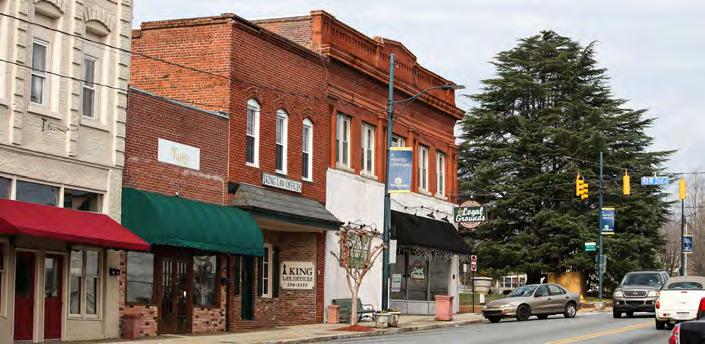
The Town of Rutherfordton (pop. 4,213) serves as the county seat of Rutherford County and the northern terminus of this plan’s study area. Founded in 1787, the town served as a major commercial and political hub for western North Carolina and the Blue Ridge Foothills from the late 1700’s to the mid-1800’s. Rutherfordton is home to ten sites listed on the National Register of Historic Places, including the Bechtler Mint Site. The Town features a walkable downtown core, a one-mile segment of OVNHT-designated trail, and is located just south of the Overmountain Men’s Gilbert Town encampment site.
Tryon International Equestrian Center

The Tryon International Equestrian Center (TIEC) is a premier Equestrian Lifestyle Destination facility located in Polk County. The 1,400-acre site features thirteen arenas for horse shows, four restaurants, and a variety of shopping and lodging opportunities. A significant portion of TIEC property lies within the study area corridor.
Overmountain Vineyards

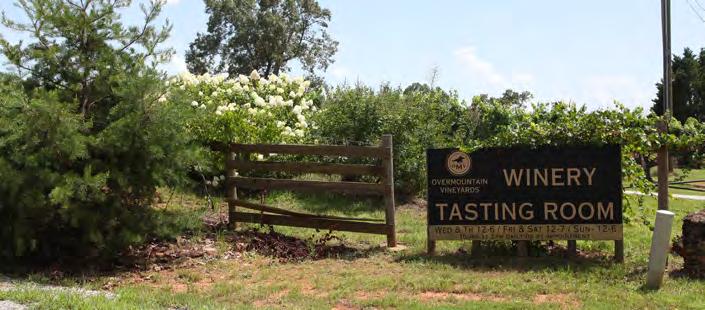
Overmountain Vineyards is a 70-acre vineyard with a tasting room, two luxury villas, outdoor pavilions, and one mile of designated OVNHT. The vineyard offers daily tours, and the vineyard tasting room is open year-round.

City of Chesnee
The City of Chesnee (pop. 868) serves as the southern terminus of the study area. Chesnee is a rural town situated just south of the NC/SC state line at the crossroads of US Highway 221 and the Cherokee Foothills Scenic Byway (SC Highway 11). The walkable downtown is comprised of three blocks of historic one and two-story commercial buildings. Single family neighborhoods abut downtown to the north, east, and west. South of downtown, the US Hwy 221 commercial corridor is characterized by national chain stores and fast food restaurants.
CHAPTER 1 15
“The Town of Rutherfordton and City of Chesnee, as well as the Bradley Nature Preserve and Tryon international Equestrian Center serve as critical anchor points for trail development.”
Photo by others
EXISTING PARKS AND TRAILS
SOME OF THESE MAJOR ASSETS INCLUDE:

Kiwanis Park
Kiwanis Park is a 5.3-acre passive park located in downtown Rutherfordton, NC. Though Kiwanis Park currently has few facilities, redevelopment per the park's 2018 master plan will include several new facilities, including a dog park, entryway plaza, and connectivity with the Purple Martin Greenway and OVNHT. As a green space anchoring Rutherfordton’s downtown core, Kiwanis Park is a significant destination within this study area.
Crestview Park
Crestview Park is a 26-acre park featuring three little league baseball fields, one tee ball field, one senior league field, one multi-purpose field, four tennis courts, two basketball courts, two playgrounds, a 1/3-mile walking trail, picnic shelter, and parking area. The park connects to the Purple Martin Greenway via a sidewalk path.
Thermal Belt Rail Trail
The Thermal Belt Rail Trail (TBRT) is a 13.5-mile rail trail that extends from Gilkey, NC to Forest City, NC. The TBRT connects the communities of Ruth, Rutherfordton, Spindale, and Forest City and serves as a significant recreation and tourism asset in Rutherford County. The rail trail's intersection with the OVNHT at U.S. Hwy 64 serves as the northern study area terminus for this plan.
Purple Martin Greenway
The Purple Martin Greenway is a 1.4-mile asphalt greenway trail in Rutherfordton. The trail connects to Crestview Park via sidewalk and will eventually connect to Kiwanis Park and the Thermal Belt Rail Trail. The majority of the trail lies within the historic OVNHT corridor.



Rutherfordton Golf Course
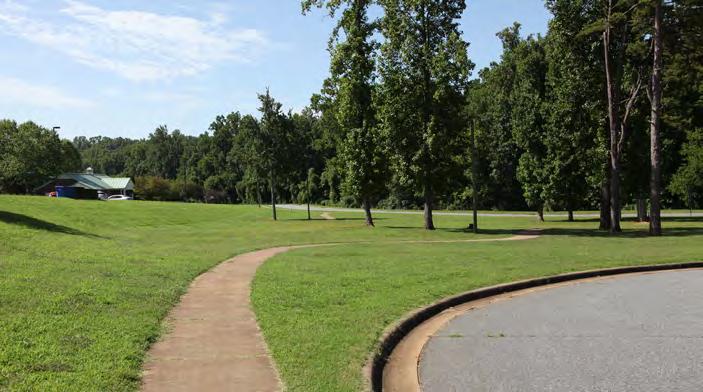
The Rutherfordton Golf Course is located southwest of downtown Rutherfordton and abuts the Rutherford Regional Hospital. Existing paths, as well as redevelopment of the property could provide an opportunity for OVNHT facilities.
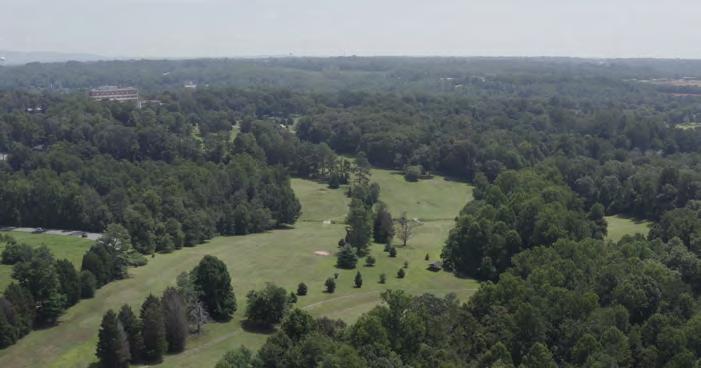
16
THE STUDY AREA boasts a collection of parks, trails, and recreation destinations that are ideal connections for the ovnht.
PHOTO BY OTHERS
Grays Road River Access
Grays Road River Access is located at the intersection of the Broad River and Grays Road in southwestern Rutherford County. The river access is managed by the North Carolina Department of Wildlife Resources and includes a small parking area and stepped access to the river. The access will serve as a trailhead along the proposed Broad River Greenway and is a key connection node along the OVNHT.

CADA Park
CADA Park is located in downtown Chesnee, SC and serves as the southern terminus for the plan study area. The park features a small pavilion, 0.2-mile walking loop, OVNHT kiosk, and parking area.

TRANSPORTATION
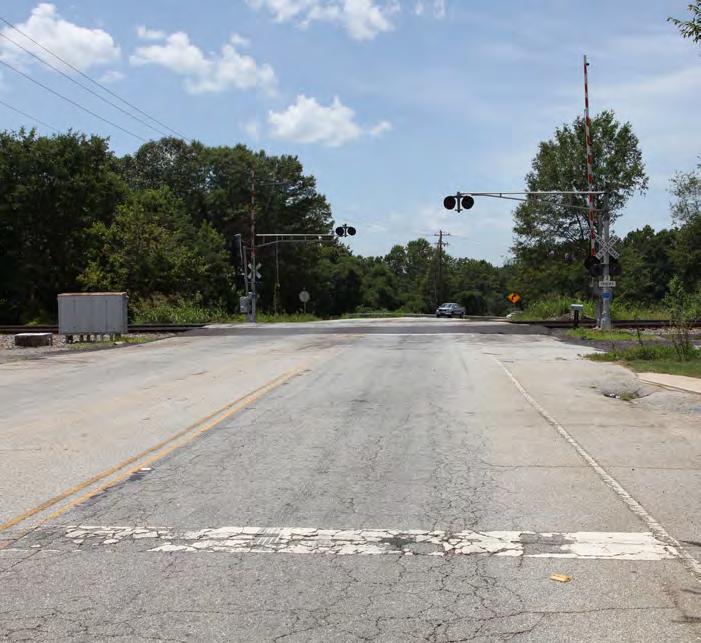
The analysis of the study area includes a review of the North Carolina, South Carolina, and County Departments of Transportation (DOT) right-of-way (ROW), DOT plans, local bicycle and pedestrian infrastructure and plans, and railways.
DOT right-of-way was analyzed to determine where there could be opportunities for developing OVNHT side paths. These areas are shown on the Site Analysis Maps with corresponding opportunities and constraints notes.
Significant sections of the study area are typified by rural roads with limited opportunities for DOT side-path development. This, combined with the lack of a consistent waterway and riparian area within the corridor present significant barriers to trail development.
UTILITIES
The incorporated towns located within the study area maintain a complex matrix of water and sewer infrastructure which, in many instances, are held in fee simple ownership by a public agency or have easements that can be modified to provide for trail development.



The analysis of the study area includes a review of public infrastructure and associated easements.
Bradley Nature Preserve at Alexander's Ford
The Bradley Nature Preserve at Alexander's Ford is a 162-acre nature preserve located in northeastern Polk County. The Preserve contains approximately 1.1 miles of designated OVNHT as well as a parking area, picnic area, and interpretive signage.

CHAPTER 1 17
“Rural Road networks and the lack of a consistent waterway within the study area present significant barriers to trail development.”
The Overmountain Victory National Historic Trail Route and Corridor
The Overmountain Victory National Historic Trail route was identified by a National Park Service research team. The team relied on the 1881 account of the march, which has been amended by local historians, descendants of battle participants, and other sources. As part of this congressionally-designated trail, officially designated portions of the OVNHT must lie within or very near the one-mile corridor (half-mile on either side) of the historic route.
THE BRADLEY NATURE PRESERVE AT ALEXANDER'S FORD IS MANAGED BY POLK COUNTY. THE SITE FEATURES 1.1 MILES OF CERTIFIED TRAIL. AT THE PRESERVE, VISITORS CAN VIEW ALEXANDER'S FORD, WHICH IS REGISTERED ON THE NATIONAL REGISTER OF HISTORIC PLACES.

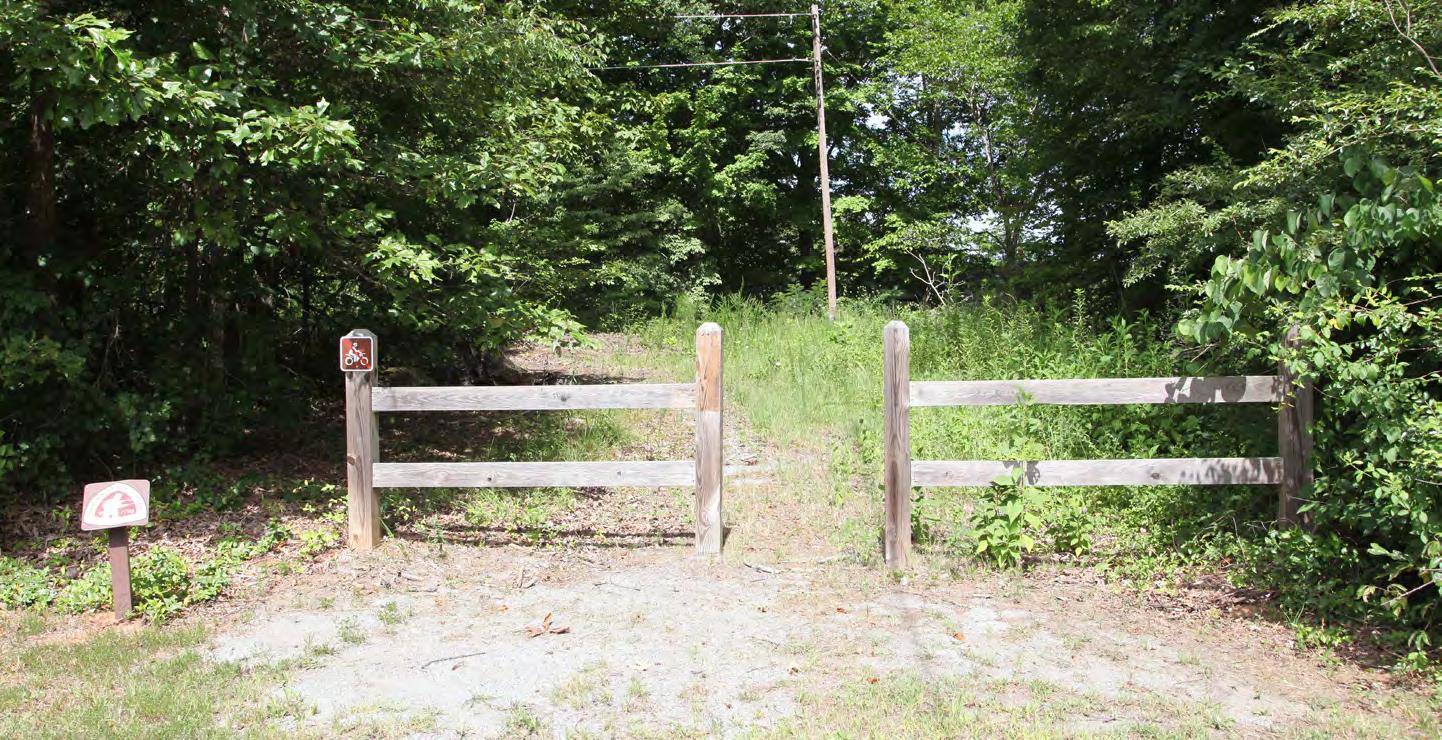
Historic Sites and Landscape

The North Carolina and South Carolina State Historic Preservation Offices (SHPO) oversee a large database of historic sites and resources. Many resources, including those related to the OVNHT, are included within the subsequent analysis map series. These resources include information from SHPO as well as sites related to the National Register of Historic Places (which the National Park Service oversees, but is managed by individual States). The most critical sites include those listed on the National Register (NR) or determined eligible (DOE) as they have further protection under Section 106 of the National Historic Preservation Act. The National Park Service has emphasized that historic/cultural resources should be linked, preserved, and interpreted as part of this study and subsequent trail development. Specific resources that directly relate to the
history of the OVNHT are noted on the subsequent maps and include: A. Downtown Rutherfordton Historic District B. Trinity Lutheran Church C. Rutherford County Courthouse D. Carrier Houses E. St. Luke’s Chapel F. Alexander’s Ford
18
Sensitive Cultural Resources and Permitting: Any construction funded or permitted by the federal government will trigger project review by SHPO of any resources covered under Section 106 (National Historic Preservation Act). These resources could include human remains, burial sites, archeology sites, and historic sites. If it is found that the action of trail construction could potentially adversely affect cultural resources, the SHPO will work with the related Federal Agency to eliminate or minimize the effect. Historic Sites and Permitting: In general, a greenway would have no effect or a complimentary relationship to preservation of these sites, but may require SHPO coordination in circumstances like alterations to historic bridges or whole properties. If federal funds or permitting is required, the SHPO will review this database and analyze for any adverse impacts.
HISTORIC RESOURCES
AND CULTURAL
“THE OVNHT SHOULD LINK, PRESERVE, AND
INTERPRET HISTORIC
SITES ALONG ITS ROUTE.”










































20 MOUNTAIN CREEK CLEGHORN CREEK BROADRIVER HOLLANDS CREEK STONECUTTER CREEK MAPLE CREEK FLOYDS CREEK BROADRIVER TRINITY LUTHERAN CHURCH THERMAL BELT RAIL TRAIL RUTHERFORD-SPINDALE CENTRAL MIDDLE SCHOOL KIWANIS PARK CARRIER HOUSE RUTHERFORD COUNTY COURTHOUSE ST. LUKE’S CHAPEL 108 1178 221 64 Main 2169 1547 Union 1005 1172 2201 1153 Coxe O 1194 2193 1548 1591 1155 Maple Creek 1161 Oakland 2159 Miller 2nd 2203 2194 2185 Gray's 1546 R 1149 Oak 1174 1175 Spindale Ross 1205 Pate 2200 3rd 2184 Thunder 1154 2231 1160 1544 Green 1164 Ivy Ledbetter 2271 Court Hill 2196 1170 1151 Poors Ford Coopers Gap Stonecutter Whitesides 1173 Edwards Pleasant Hill 1171 2179 Withrow 2190 1149 1004 Flynn Daniel 1193 1169 1177 Laurel Hill Washington Taylor Piney Ridge 2188 Tom Camp Moss Charlotte Collett 1156 2187 2192 BallPark Pinkwood JJGuffy 2272 1201 2249 Mountain 1197 Pleasant Hill Church West Davenport 2199 1152 1145 Hidden Knoll 2195 2250 Southern Cleghorn 2254 1176 C C Lovelace Ohio Cox Meridian 1369 Church Elm Pleasant Martin Anne Tryon Reece Maple 1593 Baber 4th Tanner 1168 2246 1162 Dave Sims Oxford Hillside Westwood Debby Deviney E 2189 Missouri Guffey Pine 1536 Cowan 2243 Mill 2191 Mitchell Fir 1520 1589 Nebraska Crowe Dairy Willow Lakes Ecology Clayfield Spring Arrow Airlie Wasena Haven 1191 Southers Conner Hamilton Duncard Church Galax Yelton I C C Trail Ridge Hunters Elmore Ellington SimsSandpit 1204 Sherry Biddy Crestview Honeysuckle Walter Horn SunsetMemorial Power Fairground Young 2278 Duke Grandview Windy Gap Lynch Monfredo Huntley Ridgeview Forest Youngs Byrd Poplar Rosey Jonas Sims 2186 2197 Florida Wisteria Dove Cardinal 2241 Davis Mapp Carver Fairway Heliport J Miller Creek Cove Bent Creek Allen Rice Woodridge Grayson Wyoming LazyCreek Helens J Hutchins Joshua JohnSmith Courtland Weathers Kelsey Edisto Skyline Colonial ICC Loop Council Franklin Goode Dallas Kentucky Gardenbrook Whispering High Peak Hugh Bonaire Deter Jersey Spruce Butler Lace Marsha Pinelog Freeman Stewart QuailHill Forest Trail Pinoak Marys Southwinds Chisholm Ethan Fairforest Levi SquirrelDen FlatGap Covington Cobra Dogwood Thistle Redbud Grace Redwood California Eastwood Nevada Firethorn Little Farm Hyder Laurel Rutherford Justice Farmside Kmart Briarwood Stoneway Brookwood Waddell Reservation Line CarsonFarm Daffodil Woodlane Somerset Five Oaks BirchCreek Executive Heritage Arizona Rapid Riceville ParkLane Blanton Carolina Paradise Pebblestone Riding Chestnut Autumn Gray Violet Aallied Jordan Godfrey 221 Ball Park Dogwood Flynn Hillside 74 221 Main Pine 1149 1546 Miller Park 1153 Park Ohio OakGreen Ball Park Miller Baber Edwards RUTHERFORD COUNTY RUTHERFORDTON SPINDALE RUTH 221 221 74 3 4 5 7 1 2 7 8 6 5 4 3 9 10 11 12 MAP 3: STUDY AREA 1 SITE ANALYSIS OVNHT and other Recreation Federal; State; Local Government Historic Landmark Site Managed Lands Hydrography Floodzone OVNHT 1 Mile Historic Corridor Existing Trail Constraint Opportunity Proposed Trail Existing Trail LEGEND STUDY AREA 1 SITE ANALYSIS
STUDY AREA 1 OPPORTUNITIES & CONSTRAINTS
OPPORTUNITIES
Existing sidewalk along Maple St.
Hospital connectivity opportunity
Existing Purple Martin Greenway
Existing sidewalk
Existing park trail


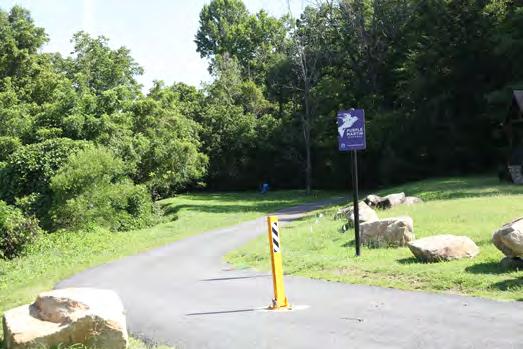
Riparian corridor through neighborhood

Possible golf course redevelopment
Wide roadside - side path possible
Large undeveloped parcels
Large mostly undeveloped parcels at Riverbend Farms
Connection to existing river access at Gray’s Rd.
Large parcels and riparian corridor along Broad River
CONSTRAINTS
Narrow road corridor along Monfredo Street
Tight private parcelization between Crestview Park and golf course
High speed/heavy traffic along Tryon Rd.
Tight private parcelization

Tight private parcelization
Narrow bridge crossing of Broad River on Gray’s Rd.

Narrow bridge crossing of Broad River on Tryon Rd.
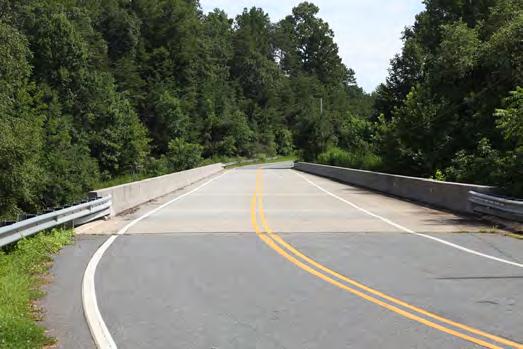
CHAPTER 1 21
1 1 2 2 3 3 4 4 5 5 6 6 7 7 8 9 10 11 12
Narrow road corridor and numerous private property driveway cuts make trail alignment along Monfredo St. difficult
Narrow bridge on Grays Rd. makes crossing the Broad River challenging
Narrow bridge on Tryon Rd. makes crossing the Broad River challenging
Wide roadside along portions of Tryon Rd. make sidepath feasible
Existing path through Crestview Park could connect to Purple Martin, allowing OVNHT to re-enter historic corridor
1 6 7 8 5 3
Existing Purple Martin Greenway provides easy alignment option that would lead the OVNHT out of downtown Rutherfordton





























22 BROADRIVER GREEN RIVER WHITE OAK CREEK MILL CREEK WHEAT CREEK JARRETTS CREEK HENSONS CREEK GREEN CREEK MACHINE CREEK CLEGHORN CREEK CHARLESCREEK GRAYS CREEK HUGHES CREEK MOUNTAIN CREEK LONGBRANCH DILLS CREEK BROAD RIVER GREENRIVER LAKE SANDY PLAINS LYLES LAKE 9 1005 1004 Coxe 1106 108 221 1148 Poors Ford 1340 1302 1352 1520 1330 Big Island PeaRidge 1149 1327 1324 1145 1525 1332 1141 1526 1522 Baber 1195 Moore 1336 1341 Landrum KenMiller 1356 1362 Peniel 1342 Union 1323 1155 1521 Sandy Plains 1536 1334 1150 1338 1126 1359 John Watson Whiteside 1329 2190 1101 JohnShehan 1144 Shiloh 1538 Turner 1339 Horne Stacey 1118 1128 1370 1335 1139 Cleghorn Mill Gray's McEntire R 1149 1143 Day ManusChapel 1303 Zion 2196 1360 1146 1130 Lee Cudd 1528 Green Creek J Ponder DarkCorner 1156 1317 1524 1133 Abrams and Moore 2171 1343 2194 1363 Belt Weeks 1153 1147 Floyd Blackwell Hopper Collinsville ARThompson 1322 1127 Watkins Hugh Champion 1132 River Crest 1213 Moonlight 1535 Little Mountain 1134 John Weaver SolenWilliams Grays Creek Church Lyles Pond Camp Long Branch 1131 White Oak 2197 John Smith Hidden Knoll Ivie 2195 Crowe Dairy Greenway Will Green Big Gum Meadowbrook 1361 1358 HesterMill Plantation McMurray County Line Bess 1333 Jim Dobbins RiverRidge Moss 1371 Dewitt Owens Wagon Aster Overhill Boyd Overmountain Chesnee Burgandy Airlie 1369 1142 Gail 1367 1135 J J BillCollins Hooper SmithWaldrop Fair Winds Larsen Capps Bishop Webber Roy Price Arrow Chatham 1325 Buck Branch Artesian Wildberry Bambi Lake Sandy Plains Pinefield Opening Pittman Biddy Redtail Troy Elliott 1304 Lazy Sycamore White Oak Farm Rosey Misery Ridge Sunset StoneHedge King Plantation Butcher Hollar Brady Hampton Riverside Blackwood Heliport Arledge Skipper Tricycle Hill Hoot Owl Valley Bluebell Holly Forest Honeysuckle McAbee HollowWood RedRock White Tail Monroe Brookstone Wilderness Sunny View Skylark Ambrose Indian Creek Bluesky Doe Branch Timberbrook Stewart Rabun Run Alden Front Ridge Simpson Fireside Polk Central Matthew Catawba 1112 1192 Deerview McFalls Field Crest Wild Cherry Tool Coxe Ridge WindyKnoll Wren Honey Wagon Libby Horseshoe Adkins 1332 Plantation 74 Baber 1149 Green Creek 1356 Union 74 1326 POLK COUNTY RUTHERFORD COUNTY BRADLEY NATURE PRESERVE/ ALEXANDERS FORD TRYON EQUESTRIAN CENTER PROPERTIES OVERMOUNTAIN VINEYARDS 74 74 221 1 2 5 4 6 7 8 9 10 12 1 3 4 7 6 5 2 MAP 4: STUDY AREA 2 SITE ANALYSIS STUDY AREA 2 SITE ANALYSIS OVNHT and other Recreation Federal; State; Local Government Historic Landmark Site Managed Lands Hydrography Floodzone OVNHT 1 Mile Historic Corridor Existing Trail Constraint Opportunity Proposed Trail LEGEND
STUDY AREA 2 OPPORTUNITIES & CONSTRAINTS
OPPORTUNITIES
Connection to Bradley Nature Preserve at Alexander’s Ford and existing OVNHT

Highway 74 underpass potential
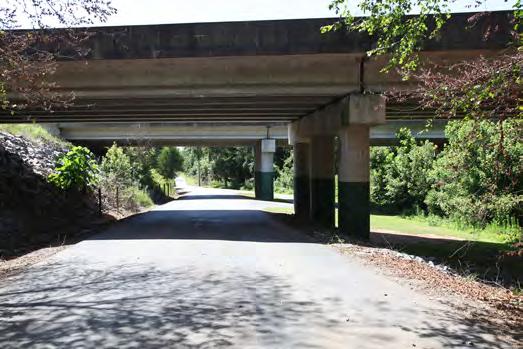
Stream culvert may provide underpass

Tryon International Equestrian Center facilites and cross country trail area connection
Overmountain Vineyards connection and existing OVNHT
Wide road/possible sidepath along S Greenway Rd.
Large mostly undeveloped parcels
CONSTRAINTS
Road crossing and private parcels
Gated private development
Underpass is a private road to gated community
HWY 74 bridge crossing narrow with mulitple ramps and high traffic
HWY 74 crossing options limited (4 lanes)
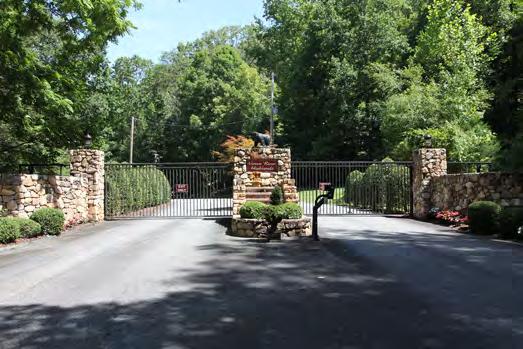
Gated private community development

Tight private parcelization
Tight private parcelization
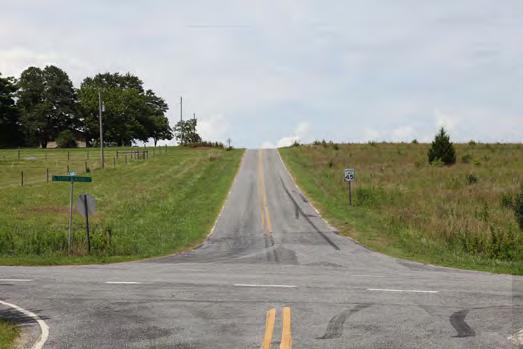
Tight parcelization and numerous driveway cuts along Sandy Plains Road

Long Incline/steep topography
Road corridor alternative is outside corridor
Tight parcelization and numerous driveway cuts along South NC HWY 9
CHAPTER 1 23
1 1 2 2 3 3 4 4 5 5 6 6 7 7 8 9 10 11
The HWY 74 underpass opportunity on River Crest Parkway is private road leading to a gated private development
Trail
trail
connect
HWY
HWY 74 bridge crossing near Tryon Equestrian Center is outside historic corridor, has multiple high traffic ramps, and a narrow bridge width
alignment along Mcdade Rd. must climb long steep grade A
alignment south of Tryon Equestrian Center could
to Overmountain Vineyards and OVNHT loop trail
74
underpass potential on River Crest Parkway
3 4 10 5 2 1 12
The Bradley Nature Preserve provides over a mile of existing OVNHT and a connection to a historic site






















24 BUCK CREEK BROAD RIVER OBEDCREEK BEAR CREEK MCKINNEY CREEK NORTHPACOLETRIVER HENSONSCREEK CUDDS CREEK RICHARDSON CREEK DILLS CREEK FLOYDS CREEK ARROWOOD BRANCH GREENCREEK ROCKY FORD BRANCH LITTLE HORSE CREEK Greenes Lk Hayes Lk 9 11 55 1111 1112 1106 43 978 187 186 1004 835 251 42 Chesnee Peachtree 100 385 CherokeeFoothillsScenic 1101 1340 1356 1116 1104 McSwain 962 1348 1108 Big Island 1353 Parris Bridge 1122 658 1346 RainbowLake 1355 969 VThompson Mill 1342 1345 Radar Anderson Hogan 221 Jack McKinney 1357 Prince 1126 1109 692 Island Ford 103 1305 1359 1350 Oconee Duncan Jolley Lee Cudd 1103 1113 Stacey Wilkie Bridge Jonas Stage Rabbit Moffitt Martin Camp 102 1354 Robbins 1326 Lewis Tanner Turkey Farm Ted Smith Harris Henderson Ledford 1123 Coxe MelvinHill 1360 Montgomery County Line Jess Lamb Airport Fall Lail 1361 Little Africa Fairfield 72 Mahaffey Cooley Poors Ford 1125 136 1542 Union McDowell LambsGrill 1124 Holly Green Lake 1110 1366 Cannon Ford 206 Johnson 1344 Clement Folk Burnetts Green Creek 1351 Townsel 1349 1121 215 Sandy Springs 168 Jolly 1303 Hood Wilkins Ford 1117 Saluda Jenkins Grassland Scoggins FishCamp Main Ridings Parris Fox 1115 1105 McAbee 239 Ray Blackley 1358 Ivey Cale 1114 Fraley 131 S-42-986 Joyces Mason Bill Lattimore Barnett HicksGrove Petite Alabama Harrill Pickens Burke Hampton Milliken Blackwood Bear Creek Lake Foster Bishop Thompson Barnwell A Wilson Ridge Melba Hawkins Texas Lowe Hensley Overhead Bridge Cantrell Riverside Joyce Zsigmond Riverbluff Gray Timer Puddin Sunset Ridge Bluesky Pruitt MyPride Tillerson Knolls Skipper Adams Court Arledge Shields Burrs Blackberry Farm Misty Painter Caro Roan CedarHill Walker Tulip Lawter Lilac Red Line Front Margate Lockland Parks Wyatt Miller Mills Hawk Nest Avita Cedar Sassy Pacolet Cartee Lost Creek Copeland OakCrest PondView Hidden Springs Melissa Brooks School WalkerRun Sweetgrass Cooley Ridge Bent River Pruitt Farm Fairfox G T Wells Falcon Fairfield Ridings 692 42 Lowe Clement 103 Henderson Jolley 11 55 Ledford 187 464 Jolley Milliken 221 POLK COUNTY RUTHERFORD COUNTY SPARTANBURG COUNTY N.C. S.C. CHESNEE 1 2 3 4 5 6 9 7 2 1 3 4 5 6 MAP 5: STUDY AREA 3 SITE ANALYSIS STUDY AREA 3 SITE ANALYSIS OVNHT and other Recreation Federal; State; Local Government Historic Landmark Site Managed Lands Hydrography Floodzone OVNHT 1 Mile Historic Corridor Existing Trail Constraint Opportunity Proposed Trail LEGEND
STUDY AREA 3 OPPORTUNITIES & CONSTRAINTS
OPPORTUNITIES
Large mostly undeveloped parcels
Large mostly undeveloped parcels
Large mostly undeveloped parcels

Existing sidewalk and very wide road/road diet potential
Existing sidewalk
CADA park connection
CONSTRAINTS
Tight parcelization and numerous driveway cuts along Chesnee Hwy
Tight parcelization and numerous driveway cuts along Chesnee Hwy


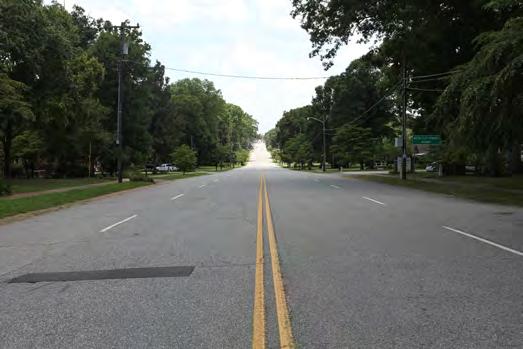

Tight parcelization and numerous driveway cuts along Lambs Grill Rd.
Tight parcelization and numerous driveway cuts along Arrowood Branch Rd.
Narrow road and private properties
Narrow road and private properties
Tight parcelization on both sides of W. Cherokee St.
Existing sidewalk ends
Tight parcelization and numerous driveway cuts on W. Oconee St.
Railroad crossing
CHAPTER 1 25
1 2 2 3 3 4 4 5 5 6
7 8 9 10
1
6
Arrowood Branch Rd. narrows further near NC/SC border and has private property and numerous driveway cuts on both sides
The railroad near CADA park must be crossed
CADA Park serves as the terminus for this planning section; it also connects this section of trail to the Chesnee/King’s Mtn. planning section
Existing sidewalk and very wide road on Alabama Ave provides an opportunity for a road diet 4
10 6 4
CHAPTER 2

LANDOWNER ENGAGEMENT

LANDOWNER

The environmental analysis (Chapter 1) was critical for determining physically feasible areas for trail development. However, significant portions of these routes impact private property and require landowner outreach to fully assess trail feasibility. This chapter highlights a good-faith effort to engage landowners throughout the planning process.

THE

ENGAGEMENT
OUTREACH AND
are KEY Components OF THE OVNHT PLANNING PROCESS.
the Landowners Landowner Communications
Workshop Trail Route Re-evaluation
ENGAGEMENT PROCESS Identifying
Landowner




28 1 6 8 7 2 2 3 4 18 33 23 13 37 26 30 10 24 17 11 21 22 22 19 16 28 28 28 28 28 28 12 25 25 34 34 34 27 38 29 29 29 14 14 20 32 221 108 74 1178 Union 1153 1163 Coxe 1005 1194 O 1161 Main 1155 Maple Creek Miller 1174 1175 R1149 Gray's 2nd 1166 1154 1205 Piedmont 1151 1164 Green 1173 Ivy Edwards Pleasant Hill 1160 1149 3rd 1193 Flynn Taylor 1156 Tom Camp 1201 Pinkwood 1152 JJGuffy 1145 Pleasant Hill Church Court Washington Hidden Knoll C C Lovelace Cox 1210 NewHope Anne 1162 Martin Tryon Maple Toms Baber Tanner Alex BobHardin Meridian Pine 1191 Willow Lakes 1st Cleghorn Clayfield Wasena Arrow 4th Yelton Hunters Trail Ridge Hillside SimsSandpit Honeysuckle Crestview Biddy 1204 Lynch Haven Callahan Grandview Monfredo Ridgeview 1165 Jonas Sims Hodge Byrd Harris Hardin Wisteria 7th Fairway Miller Creek Cove 6th Bent Creek Grayson Woodridge J Hutchins Mitchell LazyCreek Kelsey JohnSmith Skyline Council Joe 5th Hugh Bonaire Ridgecrest Bayberry Lace Butler Pinelog Cottage Hutchings Freeman QuailHill Marys Gabriel Forest Trail Southwinds Ethan Fairforest Azalea Conner SquirrelDen Russell Augusta Brass Forest Hills Dogwood Thistle Wellington Central Redbud Redwood Burris Woods End Cemetary Dutchess Briarwood Country Woods Hall Deerview Patton Sourwood Knoll TwittyFord Anders Garrett Daffodil Woodbriar Five Oaks Somerset BirchCreek Bunker Broad Heritage Carnegie Beech Tree Park Lane CarolinaParadise Pebblestone Henry Norris Magnolia Riley Gray Kindlewood Ranchway Saint John 1199 Violet Brightmore Aallied Verbinia Garden Gate Hospital Jordan ClearRun Cameron Miller Knoll Club House Meadow Court Grace Washington Wilson 6th Main 7th Ridgecrest Pleasant 1153 Woodland Fernwood 1164 4th 1160 Blanton Park Miller 2nd New Hope Edwards 3rd Hillside Baber Mitchell Ridgecrest M ountain Creek Cleghorn Creek BroadRiver Maple Creek BroadRiver RUTHERFORDTON RUTHERFORD COUNTY OVNHT: Chesnee to Rutherfordton Legend: Priority Landowner Outreach Existing OVT Existing Isothermal Rail Trail Purple Martin Greenway OVT Historic Corridor-Mile Wide Railroads Water Bodies Rivers and Streams 100 Year Flood Town Boundaries NC/SC State Line County Lines Tryon Equestrian Properties Federal Ownership State Ownership Local Government Ownership Private Priority Landowner Outreach: Map 1 MILE-WIDE HISTORIC CORRIDOR IDENTIFY THE L ANDOWNERS MAP 6: LANDOWNER MAP SAMPLE Feasibility Analysis. Trail alternatives were developed based upon an environmental feasibility analysis. Landowner Database. A mailing database was created that included all property owners within the preliminary trail alignment(s). STEP 1: DETERMINE WHERE THE TRAIL IS FEASIBLE (CHAPTER 1) STEP 2: START A CONVERSATION WITH LANDOWNERS.
LANDOWNER COMMUNICATIONS



Video Production. A custom video, specifically produced for landowners, highlighted the story of the Overmountain Victory National Historic Trail and made an appeal for landowner participation.






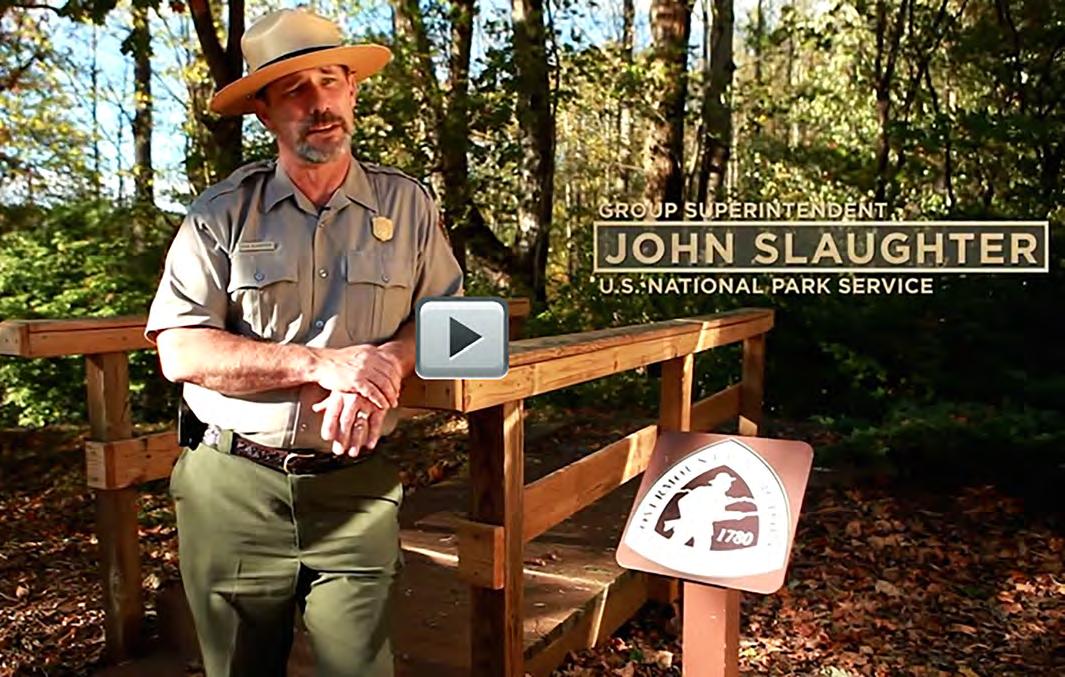



Web Portal. The project website, www.OVTplan.com, provides information about the planning process and features the landowner outreach video.
Landowner Invitation. Formal invitations were sent to all landowners included in the landowner database directing them to the website and requesting their attendance at a special meeting.
LANDOWNER INVITATON
WEB PORTAL
VIDEO PRODUCTION
CHAPTER 2 29
County Commissioners Bryan A. King, Chairman Eddie Holland Steve Garrison, County Manager Alan Toney, Vice Chairman Greg Lovelace Hazel S. Haynes Clerk the Board Michael Benfield Richard Williams, County Attorney Dear Landowner The Overmountain Victory Trail Association has partnered with the National Park Service and local government leaders to explore the opportunity to create public walking and biking trail that will connect Rutherfordton, North Carolina to Chesnee, South Carolina. This trail will celebrate the march of the Overmountain Men who won major Revolutionary War battle in 1780 at Kings Mountain, South Carolina. The patriot victory is considered turning point in the war that resulted in American independence. The trail will help preserve this history. The project planning team has been working to identify areas where the trail would be feasible. broad study area, as shown on the enclosed map, was evaluated for potential routes. After months of analysis, your property has been identified as being located within or near the historic Overmountain corridor where the trail could potentially be constructed. Without the voluntary willingness of landowners, the trail route will either be relocated or not constructed. Please visit the project website, www.OVTplan.com to learn more and view the project video. You are invited to discuss this project with representatives from the National Park Service and trail planners during one of two special landowner meetings: Wednesday, October 2, 2019 at 6:00 pm Thursday, October 3, 2019 at 6:00 pm Cowpens National Battlefield Rutherford County Office Building 4001 Chesnee Hwy 289 North Main Street Gaffney, SC
Rutherfordton, NC 28139 If you plan to attend the meeting, or you cannot attend but would like to discuss the project and your potential interest in providing for the trail on your property, please let us know by using the contact information below. Thank you. On
Overmountain Victory Trail Planning Committee
29341
behalf of,
RSVP Email: info@OVTplan.com Phone: 828.386.1866
LANDOWNER WORKSHOP



Video Screening. After signing in, the landowner workshop began with a viewing of the custom video.
Focus Groups. Various focus groups were set up around the room in which landowners could ask questions about their specific property and the associated trail alignment.
Sentiment Card.
Before landowners left, they were encouraged to fill out a landowner sentiment card describing their level of interest for providing for the trail.


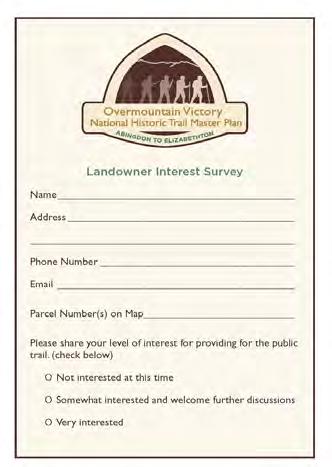
Follow up Contact. DbD staff continued to follow-up with landowners throughout development of the plan document, and adjusted plan recommendations accordingly.
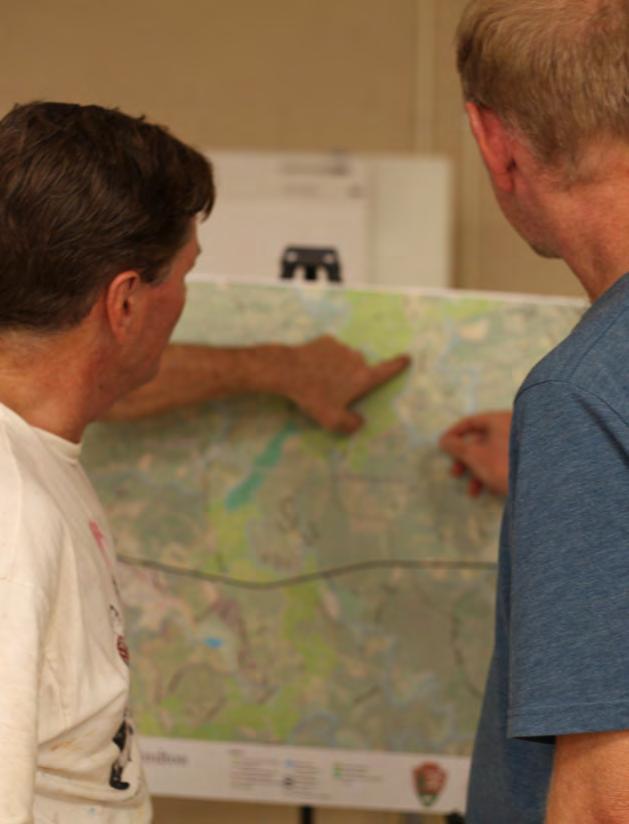
30
Outreach efforts included engaging approximately 12 landowners by phone, email, or in person at the October 2nd AND 3rd LANDOWNER WORKSHOPS HELD AT Cowpens National Battlefield and the Rutherford County Administrative Building.




CHAPTER 2 31














32 GREEN RIVER BROADRIVER BROADRIVER RUTHERFORDTON CHESNEE 74 74 74 74 74 221 221 N.C. S.C. POLK COUNTY RUTHERFORD COUNTY SPARTANBURG COUNTY TRAIL ROUTE RE-EV ALUATION Revise
was helpful
determining the
alignment and
a
the
MAP 7: LANDOWNER SENTIMENT
Trail Alignments. “Landowner Sentiment”
in
preferred
is included as
component of
final map series (Chapter 4).
A COMBINATION OF FACTORS INCLUDING THE NATURAL ENVIRONMENT, THE BUILT ENVIRONMENT, AND LANDOWNER SENTIMENT WERE USED TO DETERMINE THE PREFERRED TRAIL ALIGNMENT (CHAPTER 4).
CHAPTER 3
TRAIL CHARACTER & DESIGN GUIDELINES
PROVIDES DESIGN DETAILS FOR VARIOUS TRAIL TYPES and SIGNAGE, AND ALSO OFFERS INSIGHTS FOR INCORPORATING SOCIAL MEDIA.
THIS CHAPTER
Between Rutherfordton and Chesnee exist a diverse natural and built environment. Specific trail types must be applied throughout the corridor to ensure minimal maintenance and the best user experience.
This Chapter defines five trail types and describes their tread features and general specifications for construction.
A specific theme is presented for signage, wayfinding, and trail support facilities. Previous OVNHT Master Plans recommend identical trail branding to provide uniformity and recognition throughout the trail corridor.
IN THIS CHAPTER
A. Trail Types
B. Signage and Wayfinding
C. Social Media Marketing

TRAIL TYPES
Five primary trail types are proposed along the preferred alignment. A specific trail type is proposed according to its surrounding environment, location in a rural or urban area, and the opportunity to create a meaningful and unique user experience.

DOT SIDE PATH

8’ PAVED ASPHALT
User Group: Multi-use
Material: Paved Asphalt
Preferred Width: 8’
Average Construction Cost: $120/ln. ft.
Preferred Easement Width: 25’
Minimum Easement Width: 25’
*Note: Trail to be approved in accordance with NCDOT, SCDOT, or County DOT encroachment agreement.
TOWN SIDEPATH
10' CONCRETE
User Group: Multi-use
Material: Concrete
Preferred Width: 10'
Average Construction Cost: $90-$100/ln. ft.
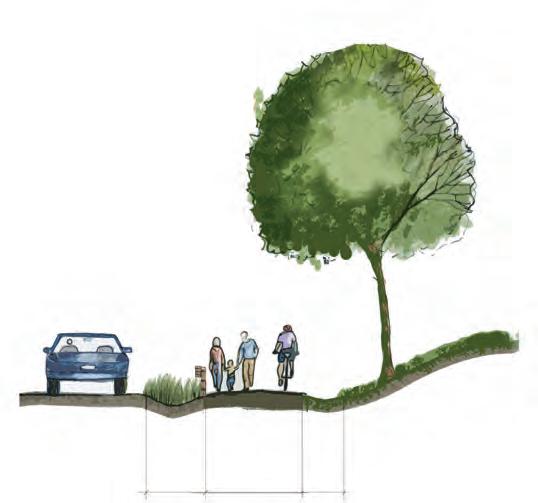
Preferred Easement Width: 25' or within public right-of-way
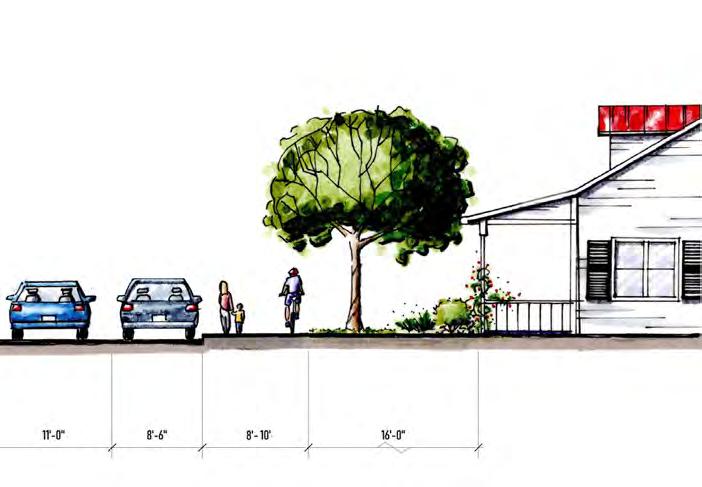
Minimum Easement Width: 25' or within public right-of-way

TYPICAL GREENWAY
10’ PAVED ASPHALT
User Group: Multi-use
Material: Paved Asphalt
Preferred Width: 10’
Average Construction Cost: $90/ln. ft.
Preferred Easement Width: 50’
Minimum Easement Width: 20’
34
30’ PREFERRED BUFFER TO RIVER TO PROTECT WATER QUALITY 10’ PAVED ASPHALT MILE MARKER FENCING TO MARK PRIVATE PROPERTY BOUNDARY
TRAIL CHARACTER
The OVNHT will provide a linear trail system of different walking, biking, and equestrian trail types that link key community and historical assets along the trail's historic corridor. Two short sections of trail within Rutherfordton are proposed to utilize existing transportation infrastructure with some modifications.
Sharrows along a short section of trail in Rutherfordton will provide for shared vehicular and cyclist use on low traffic roads.

DUAL-USE PATH
8’ CRUSHED GRAVEL FINES
User Group: Hikers and Equestrians/Cyclists
Material: Crushed Gravel Fines
Preferred Width: 8’
Average Construction Cost: $60/ln. ft.
Preferred Easement Width: 50’
Minimum Easement Width: 10’
NATURAL SURFACE
3-6’ NATURAL TREAD
User Group: Hikers and Mountain Bikers

Material: Native Soil
Preferred Width: 3’ - 6'
Average Construction Cost: $10/ln. ft.
Preferred Easement Width: 25’





Minimum Easement Width: 10’

A one-way and pedestrian/cyclist lane conversion is proposed along a brief section of Monfredo St. to provide for the trail along a narrow road corridor.

CHAPTER 3 35 SURFACE
CRUSHED GRAVEL FINES
6
3
SIGNAGE AND WAYFINDING
The OVNHT signage family provides for a modern-rustic theme and incorporates materials consisting of metal, rock, and concrete. The signage family serves as a template and can be altered and refined depending on local preferences and specific site needs. Signage marking the physical trail is required to include the official OVNHT logo of the NPS.


36
for use
Monument Sign Trailhead IDBreak-away sign
along DOT roads

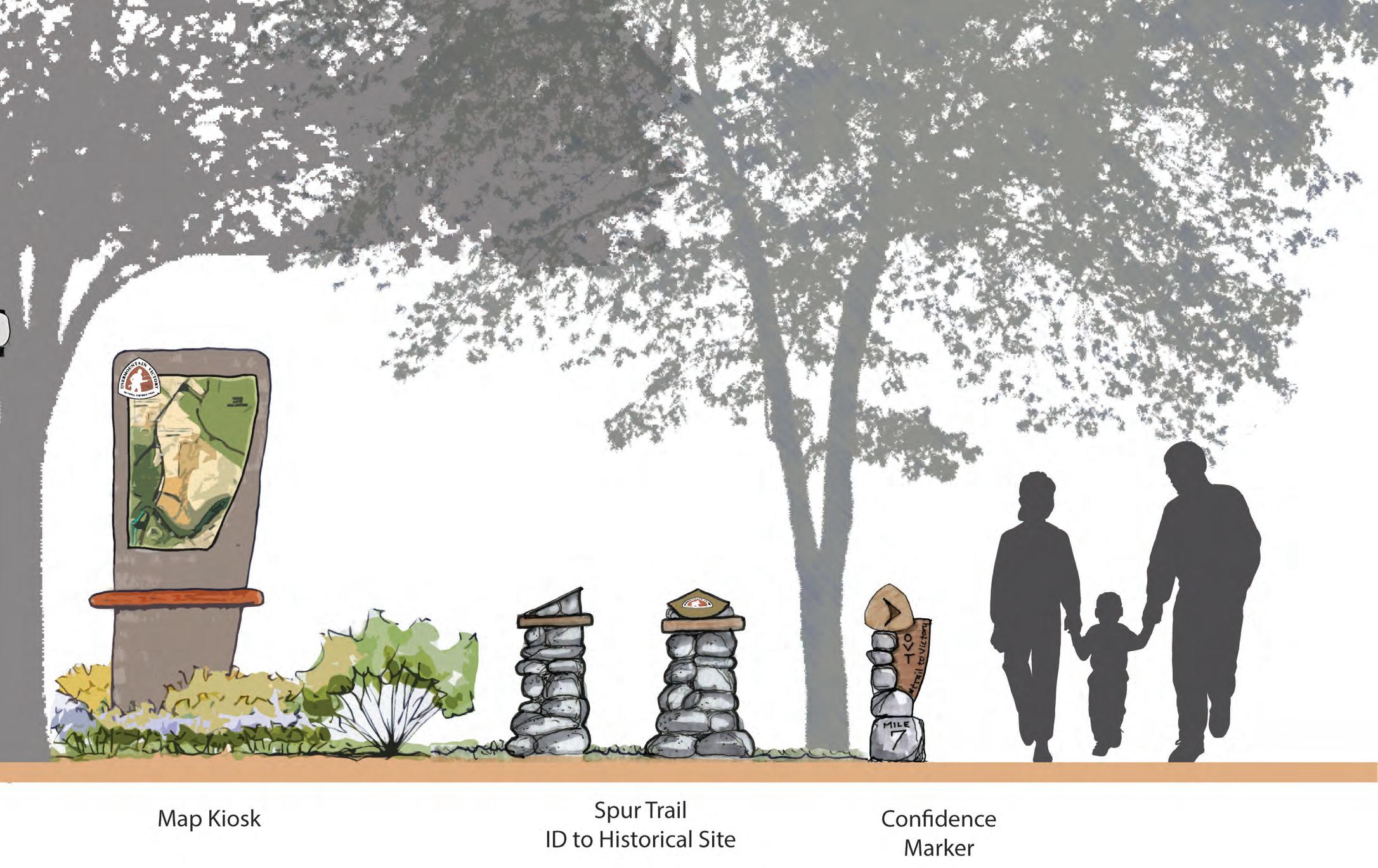
CHAPTER 3 37
SOCIAL MEDIA: THE NEW WORD OF MOUTH






Trail users should be encouraged to utilize social media to share their experiences with their friends and “followers”. Special signage along the trail will signal users to consider posting pictures of themselves or their friend groups as they walk or ride bikes along the trail. In addition, special photo opportunities and features should be developed during the final design phase. After all, who better to market this destination-quality trail than the users themselves? Take advantage of social media – the new word of mouth.
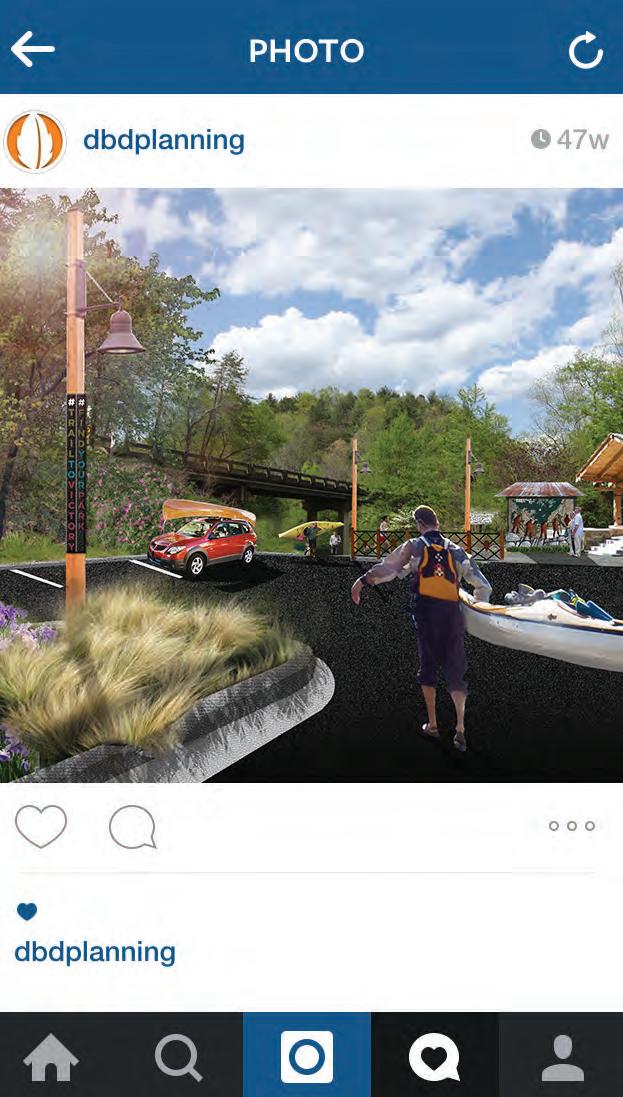
#TRAIL2VICTORY
The proposed official hashtag for the OVNHT is #trail2victory. The use of this hashtag will allow local tourism leaders to curate local photography and content that can be shared on websites and re-posted through other social media platforms.
#FINDYOURPARK
“Find your park” is the official centennial campaign of the National Park Service. The NPS is encouraging national park enthusiasts to use the hashtag #findyourpark when posting to social media. The OVNHT can help continue this campaign for years to come by encouraging the use of this hashtag at unique locations along the trail.
“FIND YOUR PARK” IS THE OFFICIAL CENTENNIAL CAMPAIGN OF THE NATIONAL PARK SERVICE. THE NPS IS ENCOURAGING NATIONAL PARK ENTHUSIASTS TO USE THE HASHTAG #FINDYOURPARK WHEN POSTING TO SOCIAL MEDIA.

38
TRAIL USERS SHOULD BE ENCOURAGED TO UTILIZE SOCIAL MEDIA TO SHARE THEIR EXPERIENCES WITH THEIR FRIENDS AND “FOLLOWERS”.
101 likes dbdplanning great day on the #trail2victory at the Bradley Nature Preserve! # ndyourpark #polkcounty #wnc
Polk County, NC
EXHIBIT 2: SOCIAL MEDIA: THE NEW WORD OF MOUTH
CHAPTER 4

RECOMMENDATIONS THIS CHAPTER SERVES AS THE HEART OF THE Rutherfordton TO Chesnee OVNHT MASTER PLAN. IN THIS CHAPTER A. Overview of Planning Section Maps B. Planning Section Descriptions












40 RUTHERFORDTON CHESNEE 74 74 74 74 74 221 221 1 2 3 4 5 N.C. S.C. POLK COUNTY RUTHERFORD COUNTY SPARTANBURG COUNTY mile-wide historic corridor PLANNING SECTIONS T h E 29- m ILE ST udy A r EA fr O m r u T h E rf O rd TON TO C h ESNEE IS d I v d E d INTO f I v E (5) PLANNING SECTIONS . T h E GEOG r AP h IC E x TENT O f EAC h SECTION INCL ud ES A b EGINNING AN d EN d ING TE rm IN u S T h AT f EAT ur ES A k E y ASSET O r SIGNI f ICANT CONNECTI v IT y POINT f O r T h E T r AIL . E AC h PLANNING SECTION INCL ud ES P r O j ECT A r EAS T h AT CAN b E d E v ELOPE d IN d EPEN d ENTL y O v E r TI m E , P r O v I d ING A LOGICAL m ET h O d f O r m PLE m ENTATION AS LAN d O w NE r w ILLINGNESS , fu N d ING , AN d OT h E r OPPO r T u NITIES A r ISE . PLANNING SECTIONS MAP 8: PLANNING SECTIONS OVERVIEW The study area from Rutherfordton to Chesnee is divided into Five (5) planning sections; this chapter is organized accordingly.
ABOUT THE PLANNING SECTION MAPS







Each planning section is anchored by a map that highlights proposed trail routes, trail features, and landowner sentiment. The proposed routes are identified as either preferred-historic, alternate, or existing local. These trail alignments are the result of extensive analysis, including environmental feasibility, landowner willingness, and insights provided by the National Park Service, local government and local trail-development leaders.



The National Trails System Act states that “a designated trail should generally accurately follow the historic route, but may deviate somewhat on occasion of necessity to avoid difficult routing through subsequent development, or to provide route variations offering a more pleasurable recreational experience.”














In accordance with this directive, the trail is planned as close as possible and practicable within the one-mile Historic Corridor. Where trail construction is not feasible within the Historic Corridor, the NPS may recognize routes outside the corridor as preferred alignments. Such routes are planned for the greatest public benefit and enjoyment, as well as to promote tourism, economic development and rural prosperity.
The NPS refers to routes outside the Historic Corridor as alternate routes to the historic route. In some locations, the preferred routes identified in this chapter are located outside of the Historic Corridor. Such routes can be marked and signed the same as routes within the Historic Corridor, but must provide on-site interpretation that indicates the known historic trail location and provides justification for construction of the trail outside of the Historic Corridor.
Noted trail features include the physical infrastructure and facilities that support the proposed trail. These features are highlighted along the preferred routes and provide critical information for developing an estimate of probable cost for each section. These features include trailheads and crossings associated with either a road or water feature. Trailheads will provide for parking and trail user orientation. Road crossings indicate the need to provide for traffic calming measures and appropriate signage for both trail users and motorists. Major bridges indicate a significant stream or river crossing that requires a bridge greater than 20 feet in length. A minor bridge/ culvert demonstrates the need to cross a relatively small stream; at this broad level of planning, it remains uncertain whether a small bridge or culvert is necessary.
QUICK FACTS
Each planning section begins with a “quick facts” exhibit. This information includes the trail distance, trail type, and key features and assets associated with each section. Also, an estimate of probable cost is noted; see the appendix for further details. Reported numbers for length and cost include all preferred routes in the planning section.
CHAPTER 4 41
Maple Creek 2nd Piedmont 3rd Laurel Hill Washington Ridgecrest Taylor Pinkwood Charlotte Collet Collett 1st Southern Cleghorn NewHope Elm Reece Toms Alex 7th 4th Industrial Park Thunder Byrd Ellington Grayson Allen 6th Joe 5th Pinelog Cedar Levi Taylors Paxton Grace Central Wilson Burris Cemetary Laurel Smith Cowan Branch Five Oaks Executive Fairmont Bunker Nicholas Broad North Recreation Ravenwood Woodland Park Lane Carolina Oak Pebblestone Covington Griswold Branch Scherer Reeves Wallace Ranchway Arnett Cherry Mtn Garden Gate Shehan Browning Sparks Meadow Sugarhill Shotwell Brookstone Maplewood Miller Charlotte Oak Cowan 5th Green 221 74 221 ALT CLEGHORN CREEK MOUNTAIN CREEK MOUNTAIN CREEK RUTHERFORDTON KIWANIS PARK TRAILHEAD RUTHERFORD REGIONAL TRAILHEAD 1 2 4 13 5 6 7 8 9 11 10 14 12 15 16 17 18 19 20 21 3 N 0 0.5
EACH PLANNING SECTION IS ANCHORED BY A MAP THAT HIGHLIGHTS PROPOSED TRAIL ROUTES, TRAIL FEATURES, AND LANDOWNER SENTIMENT. i BY THE NUMBERS RUTHERFORDTON >> CHESNEE 5National Trails System Act, Section 5(b), Part 11(a). The NTSA provides regulations for the management of National Historic Trails. RUTHERFORDTON CHESNEE 1 2 3 4 5 N.C. S.C. POLK COUNTY SPARTANBURG COUNTY VICINITY MAP EXISTING TRAIL: 1.0 MILES PROPOSED TRAIL: 5.4 MILES TRAIL TYPE: DOT SIDEPATH TYPICAL GREENWAY NATURAL SURFACE ESTIMATED COST: $ 2,4 92,600 POINTS OF INTEREST: KIWANIS PARK DOWNTOWN RUTHERFORDTON PURPLE MARTIN GREENWAY CRESTVIEW PARK RUTHERFORDTON GOLF COURSE THERMAL BELT RAIL TRAIL MOUNTAIN CREEK 3.1 >> EXISTING TRAIL MILES 36.2 >> PROPOSED TRAIL MILES 7 >> TRAILHEADS 54 >> ROAD CROSSINGS 3 >> MAJOR BRIDGES 5 >> MINOR BRIDGES/CULVERTS $8.1 M >> APPROXIMA TE COST
SECTION 1 PROPOSED TRAILS













The preferred historic route in Section 1 extends for approximately 7.3 miles from the Thermal Belt Rail Trail to Mountain Creek. From the Thermal Belt Rail Trail, the route extends westward along the NCDOT proposed US Hwy 64 realignment to Deter Street. The trail turns south on Deter Street and follows unopened road right-of-way as a typical greenway to the crossing of Southern Street. The route continues southward along Cleghorn Creek to connect to Kiwanis Park. From Kiwanis Park, the route follows the Purple Martin Greenway to Court Street.
There are two preferred routes that connect the Purple Martin Greenway to the Rutherford Regional Medical Center. The northern preferred route travels west along Court Street as a town sidepath. The trail follows South Mitchell Avenue for a short distance before turning west on Pine Street. The route continues with Ridgecrest Street south and crosses Maple and Ridgecrest Streets to access Rutherford Regional Medical Center.
The southern preferred route continues south on the Purple Martin Greenway from the Court Street intersection. The trail turns west onto an unopened road right of way and extends to US Hwy 221. The route follows US Hwy 221 as a town sidepath and continues northwest on Harris Street as on-street sharrows. At the intersection of Monfredo and Harris Streets the trail will continue west on Monfredo as a one-way road and pedestrian/cyclist lane conversion to Rutherford Regional Medical Center. An alternate connection to Monfredo Street is provided by extending west from the Purple Martin Greenway along Charlotte Street to Maple Street.
The trail continues as a typical greenway across Rutherford Regional Medical Center and the Rutherfordton Golf Course properties. An alternate connection to the Rutherfordton Golf Course extends along the Purple Martin Greenway to Skyline Drive. The alternate route follows existing sidewalks and paths at Crestview Park to connect to Edwards Road, then traverses overland to connect to the golf course property.
From the Rutherfordton Golf Course, the route continues along Tryon Road to Union Road as a DOT Sidepath for 0.72 miles. The route traverses overland as a natural surface trail between Union and J.J. Gully Roads and continues south to connect to Mountain Creek.
TRAIL FEATURES

This planning section includes three (3) trailheads, one (1) major bridge, one (1) minor bridge, and twenty-one (21) road crossings.
TRAILHEADS
The northern terminus of this planning section is located at the Thermal Belt Rail Trail. The existing Railroad Avenue Trailhead can provide access to both the TBRT and OVNHT.
Another trailhead is proposed at Kiwanis Park. The 2018 Kiwanis Park Master Plan provides for enhanced facilities, improved parking, and a OVNHT council ring.
A proposed trailhead at the Rutherford Regional Medical Center or Rutherfordton Golf Course could provide access to the trail for hospital employees and guests.
CROSSINGS
This planning section includes one (1) major bridge and one (1) minor bridge. The major bridge crosses a tributary within the Rutherfordton Golf Course property. A minor bridge is required to cross a small tributary near JJ Guffy Road.
This planning section includes twenty-one (21) road crossings. Crossing #1 will be included in the NCDOT US-221 Bypass project. Crossing #2 is at Southern Road within Rutherfordton. Crossings #3, #4, and #12 occur along a section of the Purple Martin Greenway that is currently under construction or completed. Crossings #5-11 are located throughout downtown and neighboring residential areas. Crossing #14 is at US-221. Crossings #15-16 are access roads to Rutherford Regional Medical Center. Crossings #17-21 are located on or just south of Tryon Road. These crossings serve to accommodate landowner sentiment and avoid tight parcelization.
42
EXISTING TRAIL: 1.0 MILES PROPOSED TRAIL: 6.3 MILES TRAIL TYPE: TYPICAL GREENWAY TOWN SIDEPATH DO T SIDEPATH NATURAL SURFACE ESTIMATED COST: $3,043,460 POINTS OF INTEREST: THERMAL BELT RAIL TRAIL KIWANIS PARK DOWNTOWN RUTHERFORDTON PURPLE MARTIN GREENWAY RUTHERFORDTON GOLF COURSE RUTHERFORDTON CHESNEE 74 74 74 74 221 221 1 2 3 4 5 N.C. S.C. POLK COUNTY RUTHERFORD COUNTY SPARTANBURG COUNTY mile-wide historic corridor VICINITY MAP THERMAL BELT RAIL TRAIL MOUNTAIN CREEK























CHAPTER 4 43 2nd Piedmont 3rd Green Laurel Hill Hill Washington Ridgecrest Flynn Pinkwood Charlotte Collet Mountain Collett 1st Southern Cleghorn NewHope Church Elm Reece Railroad Toms Alex 7th 4th Industrial Park Wasena Thunder Fernwood Ellington Grayson Allen 6th Frady Joe 5th Deter Pinelog Cedar Levi Taylors Paxton Grace Central Wilson Burris SilverplateGrill Cemetary Laurel Smith Justice Hickory Rock Cowan Branch Five Oaks Shady Woods Executive Fairmont Bunker Nicholas Broad North Recreation Carnegie Ravenwood Woodland Park Lane CarolinaParadise Oak Pebblestone Chisholm Covington Griswold Branch Long Scherer Reeves Wallace Ranchway Arnett Cherry Mtn Garden Gate Shehan Browning Sparks Meadow Sugarhill Shotwell Brookstone Maplewood Fernwood Miller Fernwood Charlotte Oak Cowan 5th Green 221 74 221 ALT 74 ALT CLEGHORN CREEK MOUNTAIN CREEK MOUNTAIN CREEK NORTHERN TERMINUS OF PLANNING SECTION AT TBRT RUTHERFORDTON RAILROAD AVENUE TRAILHEAD (TBRT) KIWANIS PARK TRAILHEAD RUTHERFORD REGIONAL TRAILHEAD SECTION 1 THERMAL BELT RAIL TRAIL MOUNTAIN CREEK 1 1 2 1 4 13 5 6 7 8 9 11 10 14 12 15 16 17 18 19 20 21 3 N 0 0.5 1 MAP 9: PLANNING SECTION 1
The 2019 Kiwanis Park Master Plan serves as a guide for the redevelopment of Kiwanis Park in downtown Rutherfordton, NC. The park is located along downtown Rutherfordton’s northern gateway as well as the planned Purple Martin Greenway. The plan outlines park improvements including an adventure playground, dog park, pavilion, improved entrance plaza, and the Trail to Victory Council Ring.



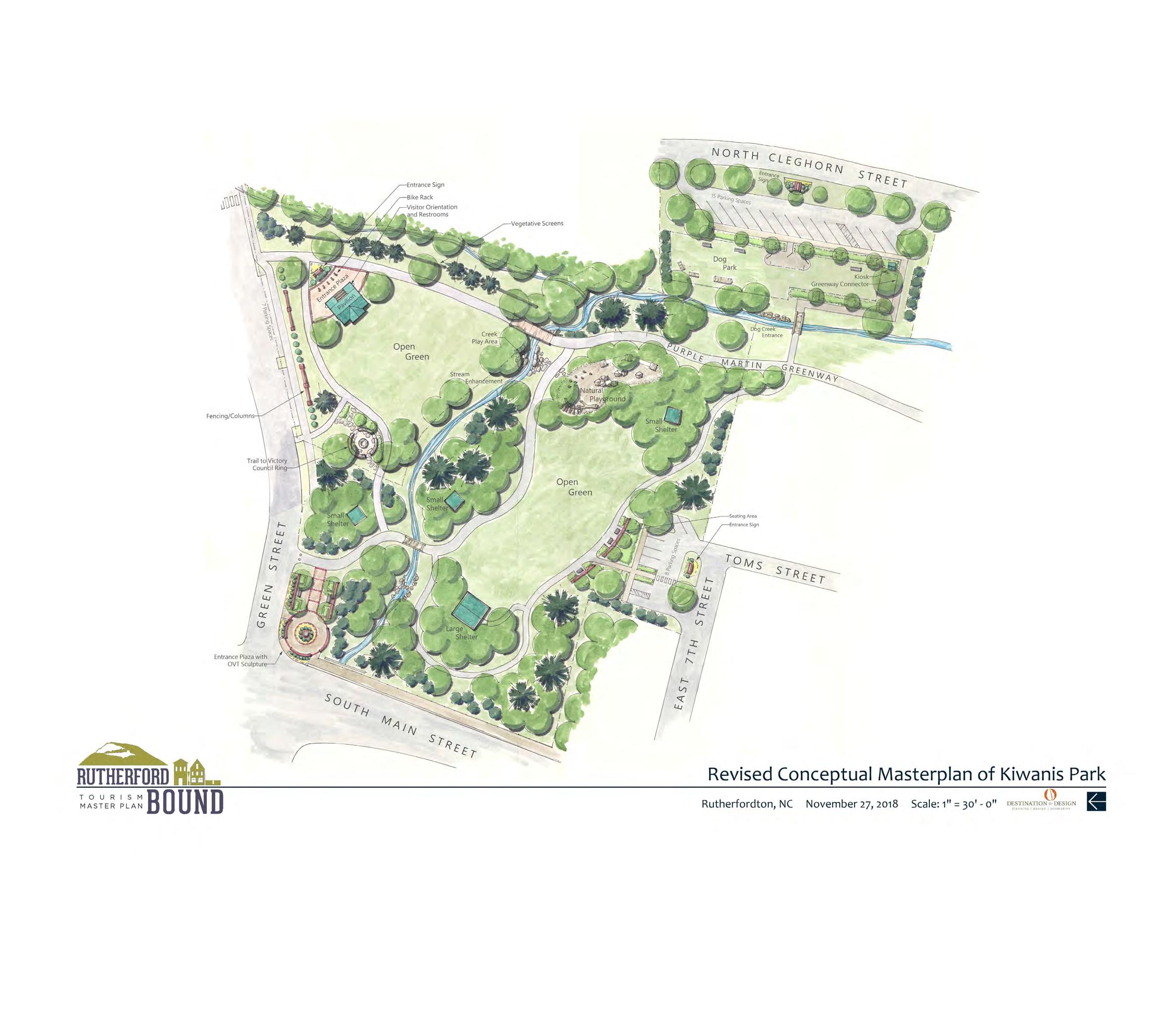
KIWANIS PARK MASTER PLAN
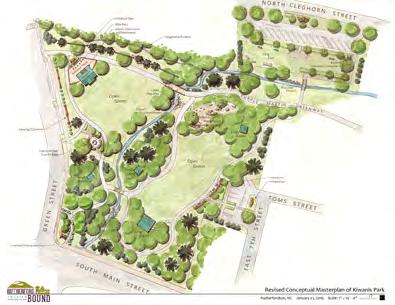
44 Revised Conceptual Masterplan of Kiwanis Park
EXHIBIT 3: KIWANIS PARK MASTER PLAN
Rutherfordton, NC November 27, 2018 Scale: 1" = 90' - 0" KIWANIS PARK MASTER PLAN
RUTHERFORDTON, NC DEVELOPED IN ACCORDANCE WITH NORTH CAROLINA PARKS AND RECREATION TRUST FUND STANDARDS
TRAIL TO VICTORY COUNCIL RING @ KIWANIS PARK
The existing Kiwanis Park Master Plan provides for the OVNHT Trail to Victory Council Ring. The council ring will be constructed of stone benches encircling a large OVNHT plaque and is designed to provide an opportunity for storytelling and educational gatherings. The park’s close proximity to downtown Rutherfordton, as well as planned enhancements, position it as a key destination along this section of the OVNHT.


45 EXHIBIT 4: TRAIL TO VICTORY COUNCIL RING
onnecting the existing Purple Martin Greenway to the Rutherfordton Golf Course Property will serve to link two significant town-owned recreation assets and expand trail opportunities within the downtown Rutherfordton area. Two alignments are proposed. The northern alignment extends west from the Purple Martin along Court St., Mitchell Ave., Pine St., and S Ridgecrest St. to connect to the Rutherford Hospital property. The southern alignment exits the Purple Martin south of Harris Street and utilizes Harris St. and a proposed one-way along Monfredo St. to connect to the golf course. An alternate route is provided along Charlotte and Monfredo Streets, as well as the Purple Martin Greenway and Crestview Park walking path.


















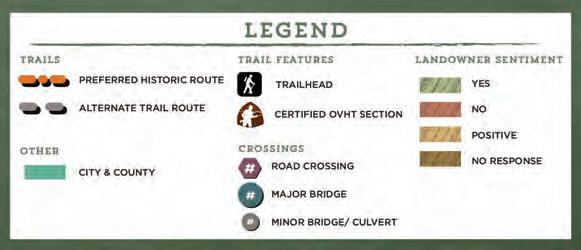
46 Main Court 2nd Edwards Anne Tryon Maple Tanner Laurel Hill 1st Pine Industrial Park Ridgecrest Park New Hope Cleghorn Hillside Piedmont Crestview Callahan Lynch Monfredo Hodge Harris Hardin Westview Fairway Mitchell Honeysuckle Bonaire Butler Cottage Freeman Fairforest Levi Azalea ForestHills Paxton Dogwood Hall Patton TwittyFord Cowan Toms Trade Skyline Executive Washington Recreation South Central Park Lane Meridian Henry Norris Grace QuailHill Simpson Taylors Woodbriar Woodland Aallied Hospital Della Partridge Ravenwood Thomas Blanton Shehan Club House Harper Frosty Sugarhill Rhododendron CherryKnoll Gardenia HCMcGinnis Longleaf Sourwood Hardin Charlotte Club House 108 1153 2271 2203 1163 1210 1166 CLEGHORN CREEK 221 221 74 0 500 1000 RUTHERFORDTON RUTHERFORD REGIONAL TRAILHEAD CRESTVIEW PARK HOSPITAL 12 2 1 11 3 4 5 6 7 8 10 13 14 15 1 PURPLE MARTIN GREENWAY TOWN BOUNDARIES RUTHERFORDTON GOLF COURSE PROPERTY 9 N MAP 10: PURPLE MARTIN CONNECTION C
PURPLE
MARTIN CONNECTION
MONFREDO STREET ONE-WAY CONVERSION

As the trail departs from its co-alignment with the Purple Martin Greenway and approaches the Rutherfordton Golf Course Property, a proposed one-way conversion along Monfredo Street would allow trail users safe passage from downtown Rutherfordton. Half of the existing two-way street would be converted into a pedestrian and cyclist-only lane, delineated by road bump dividers and an OVNHT painted path.
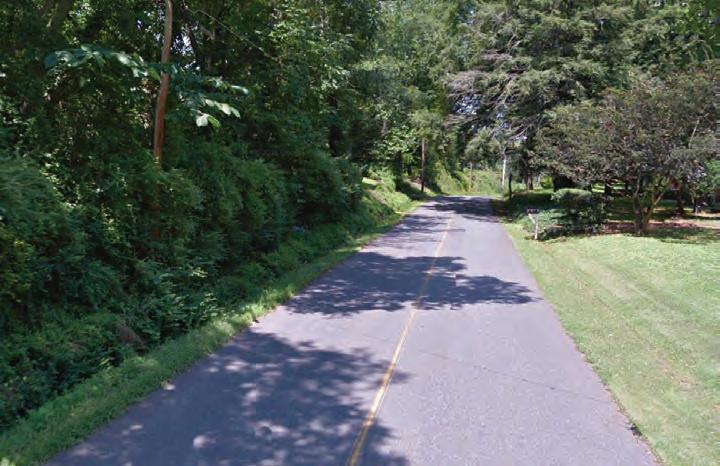

47 EXHIBIT 5: MONFREDO ONE-WAY
EXISTING
PROPOSED TRAILS














The preferred route in Section 2 extends for approximately 7.1 miles from Mountain Creek to US Hwy 74. From Mountain Creek, the preferred route traverses overland as a natural surface trail to Pleasant Hill Road. The trail briefly aligns along side Pleasant Hill Road and continues westward along Gray's Road for XX miles to the Broad River.
From the Broad River, in addition to the preferred route to connect to the Bradley Nature Preserve, two alternative routes are proposed. The preferred route briefly continues southward along the Broad River before reconnecting to Gray's Road. It continues along Gray's Rd. as a natural surface trail, briefly follows Grays Chapel Church Road, and connects with the existing OVNHT at Bradley Nature Preserve. The eastern alternate route diverges from the preferred route at the Grays Road River Access, briefly following the Broad River southeast and downstream as a natural surface trail before traversing overland to connect to Grays Chapel Road and the Bradley Nature Preserve. The western alternative diverges at the Grays Road River Access to continue west and south along the Broad River as a natural surface trail before traversing overland to connect to the Bradley Nature Preserve.
At the Bradley Nature Preserve, the route follows an existing 1.1mile section of designated OVNHT to Alexander’s Ford at the Green River. The dual-use path traverses briefly overland before continuing along the Green River to an existing underpass of Highway 74.

TRAIL FEATURES
This planning section includes two (2) trailheads, two (2) major bridges, and five (5) road crossings.
TRAILHEADS
Improvements to the existing Grays Road River Access are proposed to incorporate OVNHT facilities, including signage, mapping, and parking area enhancements as shown on p. 50.
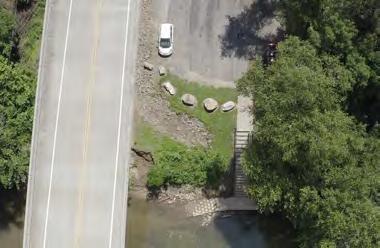
The existing trailhead at Bradley Nature Preserve serves as this planning section’s second trailhead. Improvements are also proposed at this trailhead, including a kiosk and trail markers as shown on p. 51.
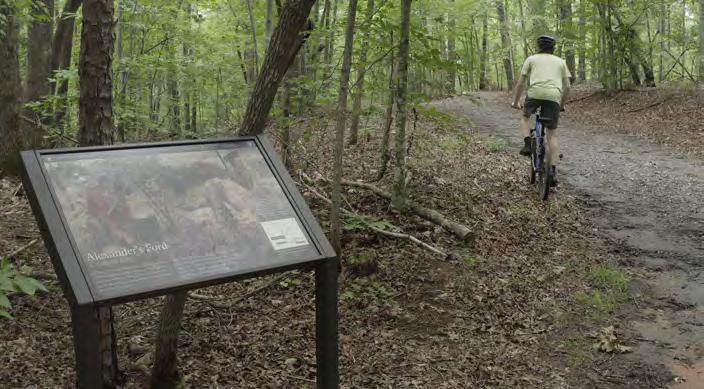
CROSSINGS
The preferred route requires two (2) major bridges in this planning section. The first is located at Mountain Creek. The second is located on the Green River at Alexander’s Ford.
Five (5) road crossings are located within this planning section. Crossings #1-2 are located at Pleasant Hill and Gray's Roads, respectively. Pedestrian enhancements will be required along the existing Gray's Road bridge to cross the Broad River. Crossings #3-4 are located at Gray's Road and Grays Chapel Church Road to allow access to the Bradley Nature Preserve. Crossing #5 is proposed at the existing underpass on private property beneath US Hwy 74 along the west bank of the Green River. Continued landowner engagement will be required to utilize this underpass.
48
01 02 HWY 74 MOUNTAIN CREEK VICINITY MAP SECTION 2 EXISTING TRAIL: 1.1 MILES PROPOSED TRAIL: 6 MILES TRAIL TYPE: NATURAL SURFACE DUAL USE PATH ESTIMATED COST: $1,002,940 POINTS OF INTEREST: BROAD RIVER GRAY'S ROAD RIVER ACCESS BRADLEY NATURE PRESERVE AT ALEXANDER'S FORD PHOTOS: (1) Existing natural surface trail at Bradley Nature Preserve. (2) Improvements are proposed at the existing Gray's Road River Access to establish an OVNHT trailhead. RUTHERFORDTON CHESNEE 74 74 74 74 221 1 2 3 4 5 N.C. S.C. POLK COUNTY RUTHERFORD COUNTY SPARTANBURG COUNTY















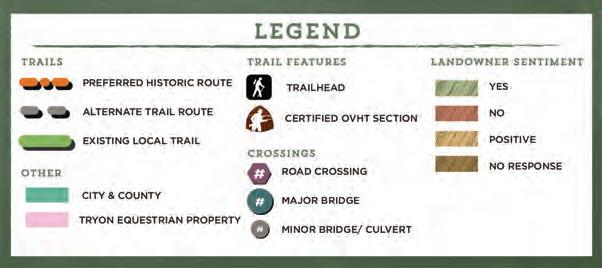





CHAPTER 4 49 River Crest JJGuffy Big Level RachelBell V S Dalton Treasure Buck Branch Moore Trail Ridge Pleasant Hill Church KenMiller Conner Taylor Watkins Hutchings Sasafras Ridge Green River Farm Redbud Countryside WrenDove Becky Victory Pass Ginger CaltonHill Coxe County Line GREEN RIVER BROAD RIVER WHEAT CREEK MOUNTAIN CREEK CLEGHORN CREEK BROAD RIVER BRADLEY NATURE PRESERVE TRAILHEAD ALEXANDERS FORD RUTHERFORD COUNTY P O L K COUNTY 74 74 SECTION 2 MOUNTAIN CREEK HIGHWAY 74 1 1 GRAY’S ROAD TRAILHEAD 3 4 2 5 2 N 0 0.5 1 MAP 11: PLANNING SECTION 2



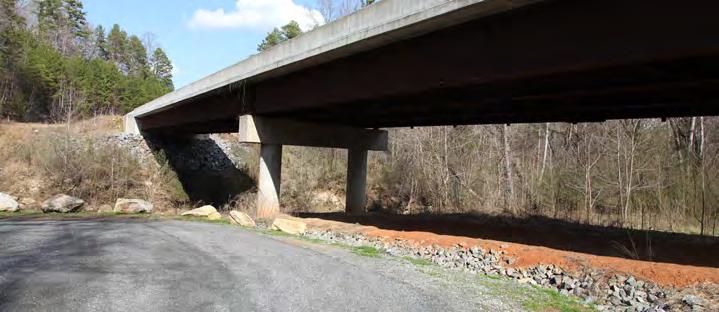
50 EXHIBIT 6: GRAY'S ROAD RIVER ACCESS
TRAILHEAD
GRAYS ROAD RIVER ACCESS AND
EXISTING
The preferred route continues south from Rutherfordton to connect with the existing Grays Road River Access along the Broad River. Willing landowners and existing improvement plans for the river access present significant development opportunities for this connection node. OVNHT trail markers and signage will create a sense of place at this trailhead.
TRAILHEAD @ BRADLEY NATURE PRESERVE



Improvements to the existing trailhead at the Bradley Nature Preserve at Alexander’s Ford will enhance the user experience along this section of trail. Proposed OVNHT trail markers and signage will enhance the trail’s presence and serve to tell the story of this important landmark along the trail.

51 EXHIBIT 7: TRAILHEAD @ BRADLEY NATURE PRESERVE
VICINITY MAP















PROPOSED TRAILS
The preferred route in Section 3 extends for approximately 10.1 miles from US Hwy 74 to Green Creek. A short section of the route leaves the historic corridor in order to utilize the existing underpass of US Hwy 74 on the western bank of the Green River. The dual-use path continues overland to connect to Coxe Road.
The preferred route aligns with Coxe Road and Sandy Plains Road as a dual use trail for XX miles to connect to the existing certified trail at Overmountain Vineyards.
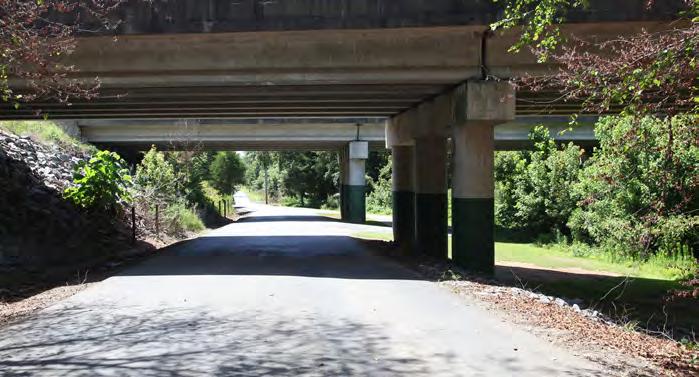
Two alternate routes are also proposed to connect to Overmountain Vineyards. The first diverges from the preferred route north of the intersection of Coxe and Sandy Plains Roads. The alternate trail continues westward and overland as a natural surface trail. Southeast of Meadow Crest Road, the alternate route turns north to reconnect with the preferred route. A spur from the alternate route continues westward, outside of the historic corridor, to connect to the southern boundary of the Overmountain Vineyards.
From Overmountain Vineyards, the trail continues west, briefly aligning with Mill Creek before traversing overland as a natural surface trail to connect to McDade Road. The preferred route continues southwest to connect to Horne Road.
The trail aligns briefly with Horne Road and NC-9. From NC-9, east of Matthew Road, the route continues overland as a natural
surface trail. An alternative route is proposed, continuing along NC-9.
TRAIL FEATURES
This planning section includes one (1) trailhead, two (2) minor bridges, and seven (7) road crossings.
Trailheads

A trailhead is proposed at Tryon International Equestrian Center along Sandy Plains Road across from Overmountain Vineyards.
Crossings
Two (2) minor bridges are required for this planning section. The first crosses Mill Creek, west of Greenway Road. The second is located at Marys Branch, east of John Smith Road.
This planning section includes seven (7) road crossings. Crossing #1 is located at the intersection of Pea Ridge and Coxe Roads. Crossing #2 is located on Sandy Plains Road and is required to access Overmountain Vineyards, across from the Tryon International Equestrian Center. Crossings #3-5 and #7 occur at rural roads. Crossing #6 occurs at NC-9. Pedestrian enhancements will be required to securely cross this 2-lane rural highway.
52
RUTHERFORDTON CHESNEE 74 74 221 221 1 2 3 4 5 N.C. S.C. POLK COUNTY RUTHERFORD COUNTY SPARTANBURG COUNTY mile-wide historic corridor
GREEN CREEK HWY 74
EXISTING TRAIL: 1 MILE PROPOSED TRAIL: 9.1 MILES TRAIL TYPE: DUAL USE PATH NATURAL SURFACE ESTIMATED COST: $1,498,550 POINTS OF INTEREST: TRYON INTERNATIONAL EQUESTRIAN CENTER OVERMOUNTAIN VINEYARDS 01 02 PHOTOS: (1) A crossing is
to connect
to
(2)
presents an opportunity to
SECTION 3
required at Sandy Plains Road
Tryon International Equestrian Center
Overmountain Vineyards.
An underpass
cross Hwy 74.





















CHAPTER 4 53 Horne McEntire Day Poors Ford Hugh Champion Collinsville Gilbert Ivie John Weaver Burgandy John Smith Burgundy Mason GreenFields Webber Artesian Eagle Nest Little Mountain Stirrup Downs Wild Turkey Skipper Monroe Brewery RabunRun Copeland River Ridge Bubbling Springs Matthew Field Crest Libby Steadman Green Meadows GreenCreek Burgundy WHITE OAK CREEK MILL CREEK GREEN CREEK GREEN RIVER HUGHES CREEK BROAD RIVER GREEN RIVER LAKE SANDY PLAINS 74 74 RUTH E R F ORDCOUNTY POLK COUNTY OVERMOUNTAIN VINEYARDS TRYON EQUESTRIAN CENTER 9 TRYON EQUESTRIAN CENTER TRAILHEAD 0 0.5 1 SECTION 3 HWY 74 GREEN CREEK N 1 1 2 3 4 5 7 6 2 MAP 12: PLANNING SECTION 3
he Tryon International Equestrian Center (TIEC) serves as a significant destination along the preferred OVNHT route. TIEC’s proximity to other assets such as the Overmountain Vineyards and the existing trail system within the Center’s property highlight a significant trail development opportunity. A dual-use path trail type to the north of the Equestrian Center will allow for equestrian use of the OVNHT to the Bradley Nature Preserve.














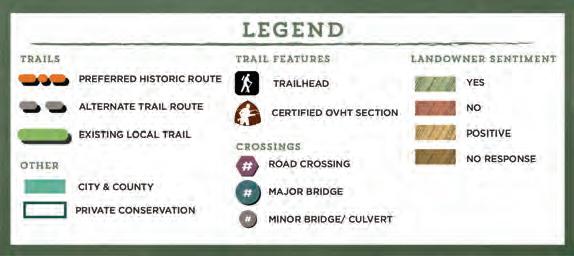
54 Fair Winds Riverside McDade Falcon Plantation BobSearcy 1330 1336 1369 GREEN RIVER WHITE OAK CREEK BROAD RIVER WHEAT CREEK MILLCREEK MACHINE CREEK CLEGHORN CREEK MOUNTAIN CREEK CHARLESCREEK GREEN RIVER RUTHERF O R D COUNTY POLK C O UNTY 1 1 2 3 TRYON EQUESTRIAN CENTER TRAILHEAD OVERMOUNTAIN VINEYARDS TRYON EQUESTRIAN CENTER BRADLEY NATURE PRESERVE N MAP 13: TRYON EQUESTRIAN CENTER T
TRYON INTERNATIONAL EQUESTRIAN
CENTER

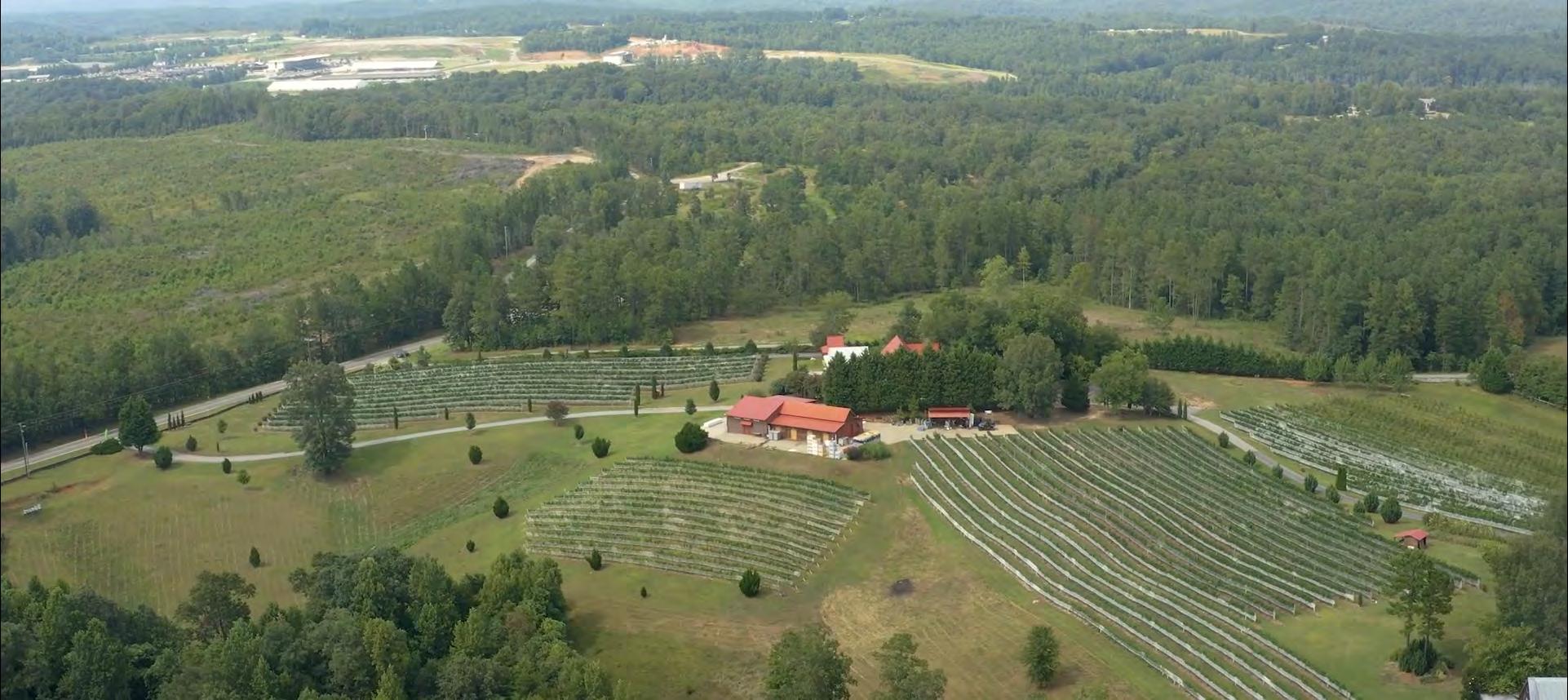
CHAPTER 4 55 OVERMOUNTAIN VINEYARDS
he Overmountain Vineyards is a 70-acre vineyard that contains 1 mile of certified OVNHT. The vineyard features a tasting room as well as two luxury villas and outdoor pavilions. With close proximity to the Tryon International Equestrian Center, daily tours offered in the spring, summer, and fall, and a tasting room open year-round, the vineyards serve as a key destination and connection node along the trail. EXHIBIT 8: OVERMOUNTAIN VINEYARDS QUICK FACTS: Location: Polk County, NC Size: 70 acres Miles of Certified OVNHT: 1 Signature Feature:
T
VICINITY MAP


PROPOSED TRAILS
The preferred route in Section 4 extends for 7.6 miles from Bear Creek to the NC-SC state line. From Bear Creek, the preferred route traverses overland as a natural surface trail before connecting to Airport Road. The route briefly aligns with Airport Road before continuing overland to connect to Chesnee Highway west of Ted Smith Road.
An alternate route follows NC-9 and Chesnee Highway before rejoining the preferred route on Chesnee Highway. Tight parcelization and a narrow road corridor present significant development challenges to this alternate route.



The preferred route continues along Chesnee Highway and Lambs Grill Road as a natural surface trail to the NC-SC State Line.











TRAIL FEATURES
This planning section includes two (2) minor bridges and eight (8) road crossings.
CROSSINGS
Two minor bridge crossings are located within this planning section. The first bridge is located at Bear Creek. The second crosses a tributary of Bear Creek.
After the preferred route crosses NC-9 at crossing #1, the trail crosses seven rural roads (crossings #2-8) as it traverses overland to connect to the NC/SC State Line.
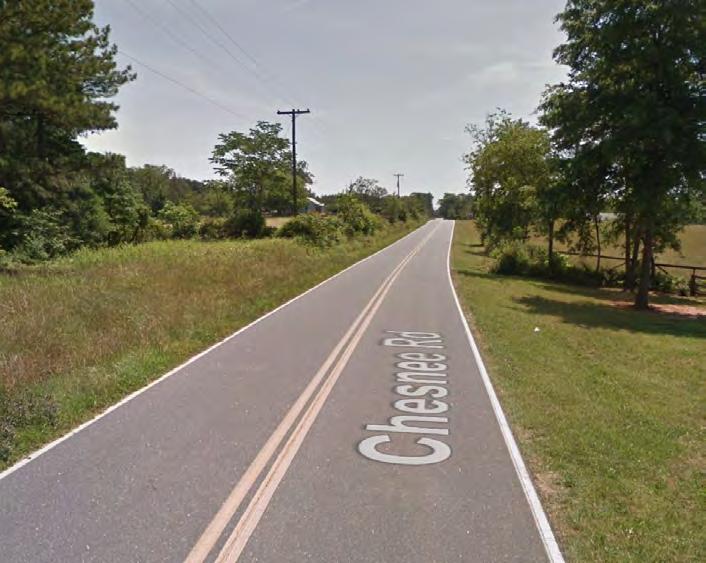
56
NC/SC STATE LINE GREEN CREEK PROPOSED TRAIL: 7.6 MILES TRAIL TYPE: NATURAL SURFACE ESTIMATED COST: $557,600 POINTS OF INTEREST: GREEN CREEK NC/SC STATE LINE RUTHERFORDTON CHESNEE 74 74 74 221 1 2 3 4 5 N.C. S.C. POLK COUNTY RUTHERFORD COUNTY SPARTANBURG COUNTY 01 02 PHOTOS: (1) Rural roads with narrow rights-of-way present significant development challenges in this section. (2) Large agricultural parcels, coupled with a continued landowner engagement strategy, provide an opportunity for trail development outside of the roadway corridor.
SECTION 4




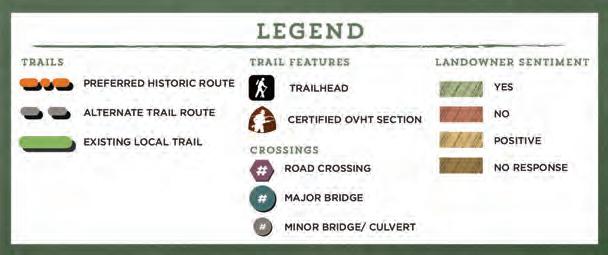









CHAPTER 4 57 55 Coxe 251 186 McSwain LambsGrill Jolley Sandy Springs Peachtree Scoggins 131 BigIsland Meadowbrook Rabbit Moffitt ParrisBridge Lewis A Wilson Vera Mae Miller State Line BearCreek Mahaffey Cooley Tulip JimPage Scruggs Misty Turner Pond View Lyles Pond Rainbow HudsonCooley Poors Ford Strawberry Copeland BEAR CREEK HENSONS CREEK BUCK CREEK GREENCREEK MCKINNEY CREEK BROADRIVER RUTHERFORD COUNTY POLK COUNTY SPARTANBURG COUNTY 9 9 SECTION 4 GREEN CREEK STATE LINE N 0 0.5 1 1 1 2 4 3 5 6 7 8 2 MAP 14: PLANNING SECTION 4
VICINITY MAP
PROPOSED TRAILS


The preferred route in Section 5 extends for 7.2 miles from the NC-SC state line to CADA Park in Chesnee. From the NC-SC state line, the preferred route follows Parris Bridge Road, as a natural surface trail, to its intersection with Scruggs Road. The trail then continues overland to reconnect with Parris Bridge Road.
The trail follows Parris Bridge Road south to Harris Road before continuing overland to connect to Cherokee Foothills Scenic Hwy. An alternate route diverges from the overland trail west of Island Ford Road to connect to Cherokee Foothills Scenic Hwy on the western side of Island Ford Road.
The preferred route aligns with Cherokee Foothills Scenic Hwy as a DOT sidepath to connect to Oconee Road. The preferred route continues as a DOT sidepath along Oconee Road to connect to Alabama Avenue.















The preferred route follows Alabama Avenue south as a town sidepath before turning west to connect to CADA Park.
Two alternate routes also connect Oconee Road to CADA Park.
One continues southeast on Cherokee Street. The other turns south on North Carolina Avenue to connect to CADA Park.
TRAIL FEATURES
This planning section includes one (1) trailhead and thirteen (13) road crossings.
TRAILHEADS
A trailhead is proposed at CADA Park. The park’s proximity to Chesnee’s downtown business district and existing on-street parking provide an opportunity for trailhead development. Enhancements should include OVNHT signage and trail markers to establish a sense of place and awareness of the trail.
CROSSINGS
Crossings #1-5 occur at rural roads as the preferred route connects overland to the Cherokee Foothills Scenic Highway. Crossings #6-8 traverse the Cherokee Foothills Scenic Highway to accommodate landowner interest and avoid small parcelization. Crossings #9-11 traverse Oconee Street. Crossings #12-13 traverse side streets along Alabama Avenue in downtown Chesnee.
58
SECTION 5 CHESNEE NC/SC STATE LINE PROPOSED TRAIL: 7.2 MILES TRAIL TYPE: NATURAL SURFACE DO T SIDEPATH TOWN SIDEPATH ESTIMATED COST: $1,934,410 POINTS OF INTEREST: CADA PARK DOWNTOWN CHESNEE RUTHERFORDTON CHESNEE 74 74 74 221 1 2 3 4 5 N.C. S.C. POLK COUNTY RUTHERFORD COUNTY SPARTANBURG COUNTY 01 02 PHOTOS: (1) CADA Park will provide trailhead access from downtown Chesnee. (2) North of downtown Chesnee, Alabama Ave. has a wide road width.













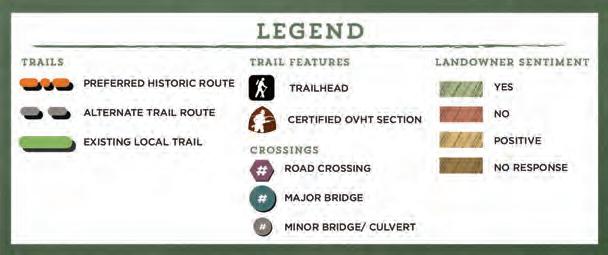






CHAPTER 4 59 186 835 55 Jonas Lail Rutherfordton Folk Studebaker Cooley Springs School Parris Dillon FishCamp Peach Shed Jess Lamb BigIsland Kirk LambsGrill Airport WoodsFarm SwoffordRidge 104 Overhead Bridge Pleasant Jack McKinney Wall Sanders Bradley Adams Circle Julie Scruggs State Line Tuscany HorseCreek Turner Pond View Mossburg Cartee Ravencrest HudsonCooley DeerRun Perez Blue Dawn Strawberry Lowe Ledford Hicks Grove BUCK CREEK CUDDS CREEK EZELL BRANCH ARROWOOD BRANCH ROCKY FORD BRANCH LITTLE HORSE CREEK GREENES LAKE N.C. S.C. POLK COUNTY SPARTANBURG COUNTY CHEROKEE COUNTY PROPOSED ROUTE FROM CHESNEE TO KINGS MTN. PLANNING SECTION CHESNEE N SECTION 5 STATE LINE CHESNEE 0 0.5 1 1 2 3 4 5 6 7 8 9 10 11 12 13 CADA PARK TRAILHEAD MAP 15: PLANNING SECTION 5
ADOT-sidepath is proposed along SC-11 west of Chesnee. Signage and trail markers signify the trail’s presence, while a grass swale will provide a safety buffer from vehicular traffic on the road. Fencing is provided to clearly delineate the extent of the trail easement.


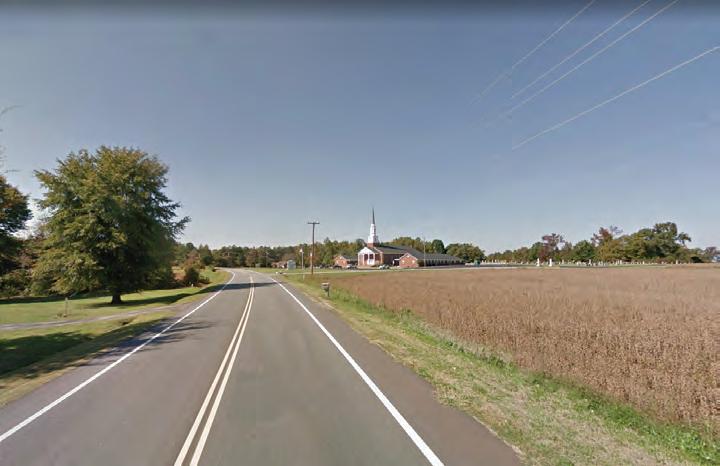
60 EXHIBIT 9: SC-11 SIDEPATH
EXISTING
CADA PARK



CHAPTER 4 61
EXHIBIT 10: CADA PARK QUICK FACTS: Location: Chesnee, SC Size: 1.4 acres
CADA Park is an 1.4-acre park located in downtown Chesnee, SC, and serves as the southern terminus of this study area and the western terminus of the Chesnee to Kings Mountain section of the OVNHT. The park features a picnic shelter, 0.2-mile walking path, and parking area. Located steps from the central Chesnee business district, the park serves as the downtown’s largest greenspace and a key connectivity node.
The OVNHT kiosk at CADA Park, constructed in December of 2019, serves as a trail hub for downtown Chesnee.

62
CHAPTER 5
IMPLEMENTATION
CONSTRUCTION OF THE OVNHT FROM Rutherfordton TO Chesnee WILL BE NO SMALL TASK. BUT WITH TIME, PERSEVERANCE, AND A LITTLE LUCK, THERE IS NO DOUBT THAT A DESTINATIONQUALITY TRAIL IS WITHIN GRASP.
This chapter summarizes details regarding each Planning Section and establishes responsibilities and implementation priorities by focus area. The chapter concludes with an economic impact analysis that evaluates potential benefits of completing the OVNHT from Rutherfordton to Chesnee.
IN THIS CHAPTER
A. Implementation by Section and Responsibilities

B. Implementation Priorities by Focus Area
C. Trail Support Spectrum
D. Economic Impact Analysis


64 IMPLEMENTATION DETAILS BY SECTON AND RESPONSIBILITY
The table below provides an overall summary of key information associated with each planning section. Key opportunities provide valuable insight that may assist in determining priorities within each section. Key challenges include costly trail features or the need to acquire trail easements from private landowners. Most importantly,
key partners that must actively work
concert
plan recommendations. Section Distance Key Opportunities Key Challenges Estimated Budget Implementing Partners SECTION 1 - Thermal Belt Rail Trail to Mountain Creek 6.3 Thermal Belt Rail Trail; Purple Martin Greenway; Kiwanis Park; Rutherfordton Golf Course Connection US Hwy 221 Crossing; Major Bridge over Tributary to Cleghorn Creek; Numerous Road Crossings; Securing Landowner Trail Easements $3,043,460 Town of Rutherfordton; Rutherford County SECTION 2 - Mountain Creek to Hwy 74 7.2 Willing Landowners Along Gray's Road; Existing Certified OVNHT and Trailhead Development in Bradley Nature Preserve Securing Landowner Trail Easements $1,002,940 Rutherford County; Polk County SECTION 3 - Hwy 74 to Green Creek 9.1 Tryon Equestrian Center; Overmountain Vinyards; Existing Underpass on US Hwy 74 Securing Landowner Trail Easements $1,498,550 Polk County SECTION 4 - Green Creek to State Line 7.6 Large Parcels of Undeveloped Land Large Parcels of Agricultural Land; Securing Landowner Trail Easements $557,600 Polk County; Rutherford County SECTION 5 - State Line to Chesnee 7.2 Positive Landowners; CADA Park DOT Sidepath along Busy Road; Numerous Road Crossings; Securing Landowner Trail Easements $1,934,410 Spartanburg County; City of Chesnee ALL SECTIONS TOTAL 37.5 $8,036,960 *Estimated budget shown above does not include existing completed sections of trail or proposed trailheads. EXHIBIT 11: PLANNING SECTION IMPLEMENTATION MATRIX
IMPLEMENTATION DETAILS BY PLANNING SECTION
this table identifies
in
to fully implement
WHERE TO START:
IMPLEMENTATION PRIORITIES BY FOCUS AREA





This plan recommends approximately 36.2 new trail miles, crosses five political jurisdictions, and requires participation from multiple land managers. For this reason, implementation partners must focus their limited capacity, including time and money, to begin advancing plan implementation.
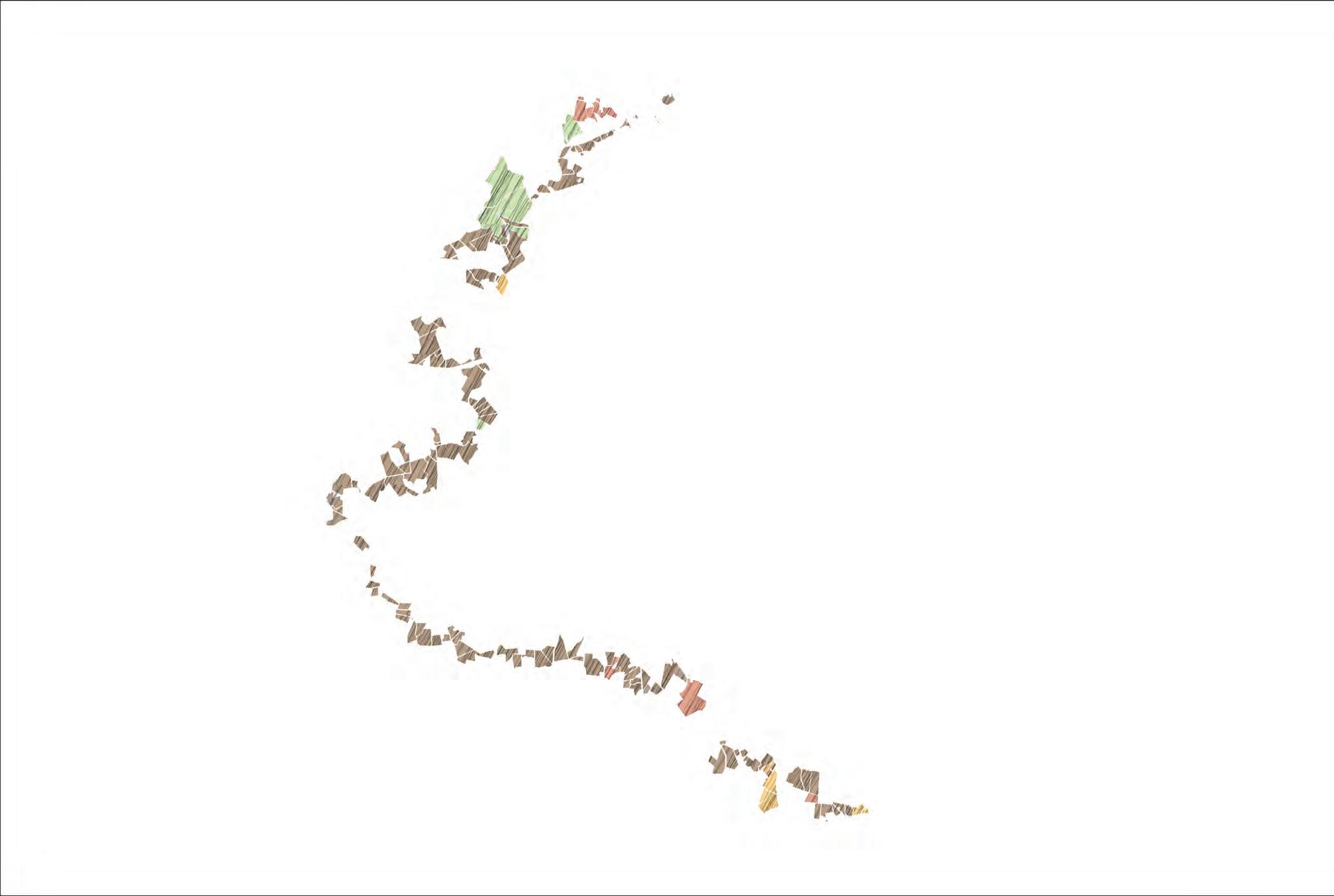
The Implementation Focus Areas Map illustrates recommended trail development focus areas within the broader context of the study corridor. These focus areas prioritize trail development that connects existing trail segments or is located on lands that are already managed by a public entity. Four suggested focus areas are presented to help partners target their efforts: 1) Purple Martin Greenway to Rutherfordton Golf Course; 2) Tryon Equestrian Center (TIEC) to Overmountain Vineyards; 3) Gray's River Access to Bradley Nature Preserve; and 4) Bradley Nature Preserve to TIEC.
Continued landowner engagement will be required for the preferred route from Overmountain Vineyards south to Chesnee. Tight parcelization and narrow road rights-of-way present significant trail development challenges.
Each government entity must work in tandem and with partners to successfully realize the complete OVNHT. Trail implementation does not have to occur in a specific, linear order according to each planning section. In fact, the priority areas for implementation are merely suggestions and are in no way intended to limit creativity or work in "lower" priority areas. Trail implementation is an art and requires the acumen to recognize and seize opportunities, whether related to funding, landowner willingness, or politics.
CHAPTER 5 65 Focus Area 1: Purple Martin Greenway to Rutherfordton Golf Course Units Unit Cost Total Cost 7648 $100 $ 764,800.00 3907 $90 $ 351,630.00 1 $25,000 $ 25,000.00 $ 25,000.00 Focus Area 2: Gray's River Access to Bradley Nature Preserve Units Unit Cost Total Cost 11830 $10 $ 118,300.00 1 $15,000 $ 15,000.00 1 $15,000 15000 $ 118,300.00 Focus Area 3: Bradley Nature Preserve to TIEC Units Unit Cost Total Cost 18197 $60 $ 1,091,820.00 $ 1,091,820.00 Focus Area 4: TIEC to Overmountain Vineyards Units Unit Cost Total Cost 9717 $60 $ 583,020.00 1 $25,000 $ 25,000.00 $ 608,020.00 Total 1,843,140.00 $ Total Section Cost Total Section Cost Total Section Cost Total Section Cost * Includes all Preferred and Historical-Preferred Routes. Does not include existing segments of OVNHT, nor land acquisition, engineering, or design costs. Final trail type will depend on specific environmental conditions and whether trail is located within public ROW or within a private trail easement. EXHIBIT 12: FOCUS AREA IMPLEMENTATION MATRIX RUTHERFORDTON CHESNEE 74 74 74 74 221 221 N.C. S.C. POLK COUNTY RUTHERFORD COUNTY SPARTANBURG COUNTY 1.Purple Martin Greenway to Rutherfordton Golf Course 4.TIEC to Overmountain Vineyards 2.Gray’s river access to Bradley Nature Preserve 3.Bradley Nature preserve to TIEC MAP 16: IMPLEMENTATION FOCUS AREAS

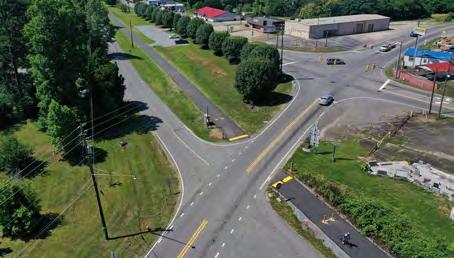


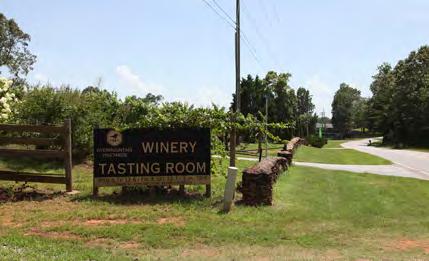
66 B:NCHWY108@ RUTHERFORDTONGOLFCOURSE
TYPE PROFILE There are
(11) trail type transitions
the preferred trail route,
miles.
Trail Type
transition location,
length,
trail type.
focus area
trail types approximate distance in miles TYPICAL GREENWAY 10 FT. PAVED ASPHALT TOWN SIDEPATH 10 FT. CONCRETE NCDOT SIDEPATH 8 FT. PAVED ASPHALT NATURAL SURFACE TRAIL 3-6 FT. NATURAL TREAD DUAL USE PATH 8' CRUSHED GRAVEL FINES 2 MILES 4 MILES 6 MILES 8 MILES 10 MILES 12 MILES 14 MILES 16 MILES 18 MILES 20 MILES 0.76 0.74 1.25 5.29 5.34 CONT. 0.72 0.44 0.45 0.24 INTERSECTIONOFDETERST.&HWY74A:NORTHERN TERMINUS: THERMALBELTRAILTRAILTRAILTRANSITIONS PURPLEMARTIN GREENWAY* COURTSTREETRUTHERFORDHOSPITALMILLERROAD(SOUTHOF)JJGUFFYROAD C:BRADLEYNATURE PRESERVE ALEXANDER’SFORD D:OVERMOUNTAIN VINEYARDS EXITSOVERMOUNTAIN VINEYARDS 1.25 1.03 A: NORTHERN TERMINUS: THERMAL BELT RAIL TRAIL B: NC HWY 108 @ RUTHERFORDTON GOLF COURSE C: BRADLEY NATURE PRESERVE D: OVERMOUNTAIN VINEYARDS *THIS GRAPHIC REPRESENTS THE PREFERRED ROUTE’S ALIGNMENT ALONG COURT ST. AND S. RIDGECREST STREET. A SECOND PREFERRED ALIGNMENT IS PROPOSED ALONG THE EXISTING PURPLE MARTIN GREENWAY, HARRIS, AND MONFREDO STREETS. FOCUS AREA 1 FOCUS AREA 2 FOCUS AREA 3 FOCUS AREA 4
TRAIL
eleven
proposed along
which extends approximately 38
The
Profile identifies the
along with associated
for each
Each
is also noted on the graphic below.

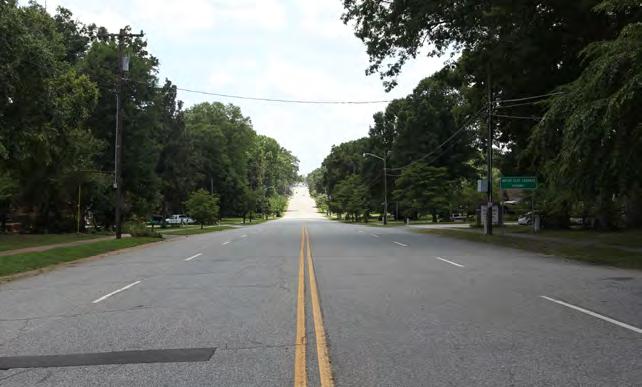

CHAPTER 5 67 Existing Trails EXISTING TRAILS ARE MARKED ORANGE EXHIBIT 13: TRAIL TYPE PROFILE approximate distance in miles trail types TYPICAL GREENWAY 10 FT. PAVED ASPHALT TOWN SIDEPATH 10 FT. CONCRETE NCDOT SIDEPATH 8 FT. PAVED ASPHALT NATURAL SURFACE TRAIL 3-6 FT. NATURAL TREAD DUAL USE PATH 8' CRUSHED GRAVEL FINES 22 MILES 24 MILES 26 MILES 28 MILES 30 MILES 32 MILES 34 MILES 36 MILES 38 MILES 20 MILES 40 MILES 1.83 0.81 17.81 CHEROKEE FOOTSHILLSSCENICHWYE:OCONEEST./ALABAMAAVE. INTERSECTION F:SOUTHERN TERMINUS:CADAPARK F: SOUTHERN TERMINUS: CADA PARK E: OCONEE ST./ALABAMA AVE. INTERSECTION
TRAIL SUPPORT SPECTRUM
Creating a destination-quality trail system requires a significant commitment from local governments, including

spend local funds, but instead must leverage their funds to obtain support from grant agencies sympathetic to the creation of trails and the OVNHT. This particular section of the OVNHT enjoys support from many partners. Working together, local trail organizations and governments can have a far greater influence in convincing funding agencies of the merits of the trail, than when acting alone.
The “Trail Support Spectrum” illustrates the steps local governments can take to support trail development in their jurisdictions.

TRAIL SUPPORT SPECTRUM
1 2 3 4 5
EXHIBIT 14: TRAIL SUPPORT SPECTRUM
ECONOMIC IMPACT ANALYSIS

Once completed, the OVNHT from Rutherfordton to Chesnee will greatly benefit surrounding communities’ economies, health and wellbeing, and quality of life. The trail is expected to attract between 23,700-39,600 users each year with a projected economic annual impact of $713,365-$1.1 million in visitor spending.

Visitor and economic impact estimates were calculated using data from trail-use and spending studies of the Blue Ridge National Heritage Area, Virginia Creeper Trail, and the State of North Carolina. A 60-mile-radius (1.5-hour driving distance) trade area and estimated 33% of North Carolinians who use trails, was used to determine a potential market population of 792,628. A 3% and 5% market penetration rate were then used to determine low and high annual user estimates. A conservative day-trip visitor spending estimate of $30 per day per visitor (Blue Ridge National Heritage Area Study) was then applied to annual user estimates to calculate the trail’s economic impact. The trail will also offer health benefits to the local population by increasing physical activity which will result in lower rates of obesity, diabetes, and premature deaths for an annual total health benefit of approximately $2.1 million (ITRE, 2019). Annual health benefits were calculated using trail studies of the American Tobacco Trail and Brevard Greenway and the World Health Organization’s Health Equity Assessment Toolkit (ITRE, 2019). Studies have also shown that amenities such as greenways and trails benefit quality of life, job retention, and attraction.

CHAPTER 5 69
MAP 17: ECONOMIC IMPACT MARKET EXHIBIT 15: ECONOMIC IMPACT ANALYSIS

70
APPENDIX


72 (A1) BUDGET SECTION 1- Thermal Belt Rail Trail to Mountain Creek Units (LF) Unit Cost Total Cost
Greenway 14542 $90 $ 1,308,780.00 Town Sidepath 8892 $100 $ 889,200.00 DOT Sidepath 3825 $120 $ 459,000.00 Natural Surface 5948 $10 $ 59,480.00 Road Crossings (Surface) 24 $8,000 $ 192,000.00 Major Bridges 1 $90,000 $ 90,000.00 Minor Bridges/Culverts 1 $45,000 $ 45,000.00 $ 3,043,460.00 SECTION 2- Mountain Creek to Hwy 74 Units Unit Cost Total Cost Natural Surface 22224 $10 $ 222,240.00 Dual Use 9345 $60 $ 560,700.00 Road Crossings (Surface) 5 $8,000 $ 40,000.00 Major Bridges 2 $90,000 $ 180,000.00 $ 1,002,940.00 SECTION 3- Hwy 74 to Green Creek UnitsUnit CostTotal Cost Dual Use 18569 $60 $ 1,114,140.00 Natural Surface 29441 $10 $ 294,410.00 Minor Bridges/Culverts 2 $45,000 $ 90,000.00 Road Crossings (Surface) 7 $8,000 $ 56,000.00 $ 1,498,550.00 SECTION 4- Green Creek to State Line Units Unit Cost Total Cost Natural Surface 40360 $10 $ 403,600.00 Road Crossings (Surface) 8 $8,000 $ 64,000.00 Minor Bridges/Culverts 2 $45,000 $ 90,000.00 $ 557,600.00 SECTION 5- State Line to Chesnee Units Unit Cost Total Cost
Surface 24211 $10 $ 242,110.00 DOT Sidepath 9665 $120 $ 1,159,800.00 Town Sidepath 4285 $100 $ 428,500.00 Road Crossings (Surface) 13 $8,000 $ 104,000.00 $ 1,934,410.00 Total 8,036,960.00 $ * Includes all Preferred and Historical-Preferred Routes Total Section Cost Total Section Cost Total Section Cost Total Section Cost
Typical
Natural

APPENDIX 73
Surface 40360 $10 $
Road Crossings (Surface) 8 $8,000 $
Bridges/Culverts 2 $45,000 $
$
State
Units Unit Cost Total Cost
Surface 24211 $10 $
DOT Sidepath 9665 $120 $
Town Sidepath 4285 $100 $
Road Crossings (Surface) 13 $8,000 $
$
Total 8,036,960.00 $ * Includes all Preferred and Historical-Preferred Routes * Does not include land acquisition, engineering, or design * Final trail type will depend on specific environmental conditions and whether trail is located within public ROW or within a private trail easement. * Does not include existing segments of OVNHT Total Section Cost
Natural
403,600.00
64,000.00 Minor
90,000.00
557,600.00 SECTION 5-
Line to Chesnee
Natural
242,110.00
1,159,800.00
428,500.00
104,000.00
1,934,410.00
(A2) LANDOWNER INVITATION
The Overmountain Victory Trail Association has partnered with the National Park Service and local government leaders to explore the opportunity to create a public walking and biking trail that will connect Rutherfordton, North Carolina to Chesnee, South Carolina.

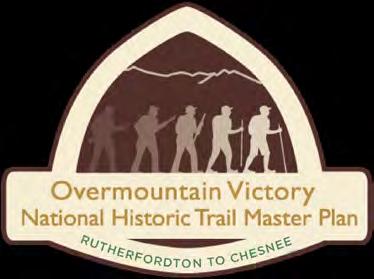
This trail will celebrate the march of the Overmountain Men who won a major Revolutionary War battle in 1780 at Kings Mountain, South Carolina. The patriot victory is considered a turning point in the war that resulted in American independence. The trail will help preserve this history.
The project planning team has been working to identify areas where the trail would be feasible. A broad study area, as shown on the enclosed map, was evaluated for potential routes. After months of analysis, your property has been identified as being located within or near the historic Overmountain corridor where the trail could potentially be constructed. Without the voluntary willingness of landowners, the trail route will either be relocated or not constructed.
Please visit the project website, www.OVTplan.com, to learn more and view the project video.
You are invited to discuss this project with representatives from the National Park Service and trail planners during one of two special landowner meetings:
Wednesday, October 2, 2019 at 6:00 pm Thursday, October 3, 2019 at 6:00 pm Cowpens National Battlefield Rutherford County Office Building 4001 Chesnee Hwy 289 North Main Street Gaffney, SC 29341 Rutherfordton, NC 28139
If you plan to attend the meeting, or if you cannot attend but would like to discuss the project and your potential interest in providing for the trail on your property, please let us know by using the contact information below. Thank you.

On behalf of,
Overmountain Victory Trail Planning Committee
RSVP Email: info@OVTplan.com Phone: 828.386.1866
Not interested at this time
Somewhat interested and welcome further discussions
Not interested at this
74
________________________________________
Ο
Ο
Ο
Ο
Ο
Ο
(A3) LANDOWNER INTEREST SURVEY Landowner Interest Survey Name
Address_______________________________________ Phone Number _________________________________ Email _________________________________________ Parcel Number(s) on Map____________________________ Please share your level of interest for providing for the public trail. (check below)
Very interested Landowner Name ________________________________________ Address_______________________________________ Phone Number _________________________________ Email _________________________________________ Parcel Number(s) on Map____________________________ Please share your level of trail. (check below)
Somewhat interested
Very interested
Bryan
Steve
Alan
Greg
Hazel
County Commissioners
A. King, Chairman Eddie Holland
Garrison, County Manager
Toney, Vice Chairman
Lovelace
S. Haynes Clerk to the Board Michael Benfield Richard Williams, County Attorney
Dear Landowner:
(A4) FUNDING SOURCES
NORTH CAROLINA

Partnership Funding Agency
Clean Water Management Trust Fund (CWMTF) (www.cwmtf.net)
Active Living/Built-Environment Implications
Land Acquisition: Fee Simple or Easement. Must protect floodplain areas. Greenway trails are allowed.
Maximum Amount Matching Funds Required Deadlines
Based on 6/2015 discussion with staff, a $750K multi-year application would be welcome.
Not specified but 20% is competitive. February 1st
NC Water Resources (NCWR) (www.ncwater.org)
River access areas or greenways along rivers N/A 50% January 1st and June 1st
Recreational Trails Program (RTP) All types of trails and greenways. $100,000.00 25% February 1st
Parks and Recreation Trust Fund (PARTF) All types of parks, trails, and recreation facilities $500,000.00 50% April
People for Bikes Community Grant Trails and Greenways $10,000.00 20%% May 24th
NCDOT Transportation Plan For Bike and Pedestrian Projects
SOUTH CAROLINA
Bike and Pedestrian Projects-both engineering and construction N/A (for major projects) 20% generallyN/A
Partnership Funding Agency Active Living/Built-Environment Implications
BUILD
Land & Water Conservation Fund (scprt.com/grants)
Maximum Amount Matching Funds Required Deadlines
Construction provided all easements are secure N/A (min. $1 million) $0 (for designated rural areas) May (Typical)
Land Acquisition: Fee Simple or Easement. Must be adjacent to existing LWCF land. $250,000.00 50%% May 2nd
Recreational Trails Program (RTP) All types of trails and greenways. $100,000.00 25% February 1st
Parks and Recreation Development Fund (scprt.com/grants)
Public recreation facilities or enhancements. Does not include land acquisition N/A (non-competitive reimbursable) 20%% 10th of each month
People for Bikes Community Grant Trails and Greenways $10,000.00 20%% May 24th
International Mountain Biking Association (imba.com/resources/grants)
Maintain and improve the sustainability of local trails and MTB community Approximately $10,000 N/A August 30th
APPENDIX 75
GENERAL ASSEMBLY OF NORTH CAROLINA SESSION 2019
SESSION LAW 2019-20 HOUSE BILL 532
AN ACT TO AUTHORIZE THE OVERMOUNTAIN VICTORY STATE TRAIL; TO AUTHORIZE THE WILDERNESS GATEWAY STATE TRAIL; AND TO MAKE VARIOUS CHANGES TO THE STATE PARKS ACT AND THE NORTH CAROLINA TRAILS SYSTEM ACT.
The General Assembly of North Carolina enacts:
AUTHORIZE THE OVERMOUNTAIN VICTORY STATE TRAIL
SECTION 1.(a) The General Assembly finds that the routes used by the patriot militias of North Carolina, South Carolina, Virginia, and the areas west of the Blue Ridge Mountains that later became the State of Tennessee in the military campaigns of the Revolutionary War leading to the Battle of Kings Mountain in 1780 are a vital part of the history and heritage of the State as well as the entire United States. The General Assembly also finds that this vital role is demonstrated by the creation of the Overmountain Victory National Historic Trail in 1980 by the federal government. The General Assembly further finds that the contributions of a significant existing network of federal, State, local, and private partn ers over the last four decades in the identification, preservation, and education of the public about the Overmountain Victory National Historic Trail have provided the State with a historical and recreational resource of statewide significance for historic reenactors, hikers, bikers, and other outdoor cultural and recreational activities, and that including such a trail in the State Trails System as a State trail would be beneficial to the people of North Carolina and further the development of North Carolina as "The Great Trails State."
SECTION 1.(b) The General Assembly authorizes the Department of Natural and Cultural Resources to add the route identified by the National Park Service as the Overmountain Victory National Historic Trail in the counties of Avery, Mitchell, McDowell, Burke, Rutherford, Polk, Caldwell, Wilkes, and Surry to the State Parks System as a State trail, as provided in G.S. 143B-135.54(b). Subject to the provisions of 16 U.S.C. § 1246, the Department shall support, promote, encourage, and facilitate the establishment of trail segments on State parklands and on lands of other federal, State, local, and private landowners. On segments of the Overmountain Victory State Trail that cross property controlled by agencies or owners other than the Department's Division of Parks and Recreation, the laws, rules, and policies of those agencies or owners shall govern the use of the property. The requirement of G.S. 143B-135.54(b) that additions be accompanied by adequate appropriations for land acquisition, development, and operations shall not apply to the authorization set forth in this section; provided, however, that the State may receive donations of appropriate land and may purchase other needed lands for the Overmountain Victory State Trail with existing funds in the Clean Water Management Trust Fund, the Parks and Recreation Trust Fund, the federal Land and Water Conservation Fund, and other available sources of funding.
AUTHORIZE THE WILDERNESS GATEWAY STATE TRAIL
SECTION 2.(a) The General Assembly authorizes the Department of Natural and Cultural Resources to add the Wilderness Gateway Trail to the State Parks System as a State trail,
as provided in G.S. 143B-135.54(b). The Department shall support, promote, encourage, and facilitate the establishment of trail segments on State parklands and on lands of other federal, State, local, and private landowners. On segments of the Wilderness Gateway State Trail that cross property controlled by agencies or owners other than the Department's Divisi on of Parks and Recreation, the laws, rules, and policies of those agencies or owners shall govern the use of the property. The requirement of G.S. 143B-135.54(b) that additions be accompanied by adequate appropriations for land acquisition, development, and operations shall not apply to the authorization set forth in this section; provided, however, that the State may receive donations of appropriate land and may purchase other needed lands for the Wilderness Gateway State Trail with existing funds in the Clean Water Management Trust Fund, the Parks and Recreation Trust Fund, the federal Land and Water Conservation Fund, and other available sources of funding.
SECTION 2.(b) The Division of Parks and Recreation of the Department of Natural and Cultural Resources shall study the feasibility of connecting the Town of Valdese, the City of Hickory, the Overmountain Victory State Trail, natural areas located within Burke and Catawba counties, as well as other communities and places of interest to the Wilderness G ateway State Trail. In conducting this study, the Division shall specifically consider improving access across and from Interstate 40 to the northeastern and western portions of South Mountains State Park. The Division shall report its findings and recommendations to the Environmental Review Commission and the Joint Legislative Oversight Committee on Agriculture and Natural and Economic Resources no later than December 1, 2019.
STATE PARKS ACT AND NORTH CAROLINA TRAILS SYSTEM ACT TECHNICAL, CLARIFYING, AND CONFORMING CHANGES
SECTION 3.(a) G.S. 143B-135.43 reads as rewritten: "§ 143B 135.43. Control of Mount Mitchell Park and other parks in the North Carolina State Parks System.
The Department shall have responsibility for: (1) the control and management of Mount Mitchell Park and of any other parks which have been or may be acquired by the State as part of the North Carolina State Parks System.System and (2) the planning and coordination of State trails, which are components of the State Parks System, authorized by the General Assembly pursuant to G.S. 143B-135.54(b)."
SECTION 3.(b) G.S. 143B-135.92 reads as rewritten: "§ 143B-135.92. Declaration of policy and purpose.
(a) In order to provide for the ever increasing outdoor recreation needs of an expanded population and in order to promote public access to, travel within, and enjoyment and appreciation of the outdoor, natural and remote areas of the State, trails should be established in natural, scenic areas of the State, and in and near urban areas.
(b) The purpose of this Part is to provide the means for attaining these objectives by instituting a State system of scenic and recreation trails, Trails System, coordinated with and complemented by existing and future local trail segments or systems, and by prescribing the methods by which, and standards according to which, components may be added to the State trails system.Trails System."
SECTION 3.(c) G.S. 143B-135.94 reads as rewritten: "§ 143B-135.94. Definitions.
(5) "State trails system" Trails System" means the trails system established in this Part or pursuant to the State Parks Act, Part 32 of this Article, and including all trails and trail segments, together with their rights-of-way, added by any of the procedures described in this Part or Part 32 of this Article.
(6) "Trail" means:

76 (A5) NC S.L. 2019-20 HB 532
*H532-v-4*
Page 2 Session Law 2019 20 House Bill 532
…."
a. Park trail. A trail designated and managed as a unit of the North Carolina State Parks System under Part 32 of this Article.
b. Designated trail. A trail designated by the Secretary pursuant to this Part as a component of the State trails system and that is managed by another governmental agency or by a corporation listed with the Secretary of State.
c. A State scenic trail, State recreation trail, or State connecting trail under G.S. 143B 135.96 when the intended primary use of the trail is to serve as a park trail or designated trail.
d. Any other trail that is open to the public and that the owner, lessee, occupant, or person otherwise in control of the land on which the trail is located allows to be used as a trail without compensation, including a trail that is not designated by the Secretary as a component of the State trails system.means a linear corridor on land or water, protected from motor vehicles, providing public access for recreation or transportation.
SECTION 3.(d) G.S. 143B-135.96 reads as rewritten: "§ 143B-135.96. Composition of State trails system.Trails System.
The State trails system Trails System shall be composed of designated:
(1) State scenic trails, which are defined as extended trails so located as to provide maximum potential for the appreciation of natural areas and for the conservation and enjoyment of the significant scenic, historic, natural, ecological, geological or cultural qualities of the areas through which such trails may pass.
(2) State recreation trails, which are defined as trails planned principally for recreational value and may include trails for foot travel, horseback, nonmotorized bicycles, nonmotorized water vehicles, and two wheel- and four-wheel drive motorized vehicles. More than one of the aforesaid types of travel may be permitted on a single trail in the discretion of the Secretary.
(3) Connecting or side trails, which will provide additional points of public access to State recreation or State scenic trails or which will provide connections between such trails.
State trails, which are components of the State Parks System, authorized by the General Assembly pursuant to G.S. 143B-135.54(b), and planned and coordinated by the Department."
SECTION 3.(e) G.S. 143B-135.104 reads as rewritten: "§ 143B-135.104. Location of trails.

The process of locating routes of designated trails to be added to the system shall be as follows:
For State scenic trails, the Secretary or a designee, after consulting with the Committee, shall recommend a route. For State recreation trails and for connecting or side trails, the Secretary or a designee, after consulting with the Committee, shall select the route. The Secretary may provide technical assistance to political subdivisions or private, nonprofit organizations that develop, construct, or maintain designated trails or other public trails that complement the State trails system.When a route shall traverse land within the jurisdiction of a governmental unit or political subdivision, the Department shall consult with such unit or such subdivision prior to its final determination of the location of the route. The selected route shall be co mpatible with preservation or enhancement of the environment it traverses. Reasonable effort shall be made to minimize any adverse effects upon adjacent landowners and users. Notice of the selected route shall be published by the Department in a newspaper of general circulation in the area in which the trail is located, Department, together with appropriate maps and descriptions to be
conspicuously posted at the appropriate courthouse. online and at the proposed trail location. Such publication shall be prior to the designation of the trail by the Secretary."
SECTION 3.(f) G.S. 143B-135.108 reads as rewritten: "§ 143B 135.108. Trails within parks; conflict of laws.laws; State trails on property of others.
Any component of the System that is or shall become a part of any State park, recreation area, wildlife management area, or similar area shall be subject to the provisions of this Part as well as any other laws under which the other areas are administered, and in the case of conflict between the provisions the more restrictive provisions shall apply. On segments of any State trail that cross property controlled by agencies or owners other than the Department s Division of Parks and Recreation, the laws, rules, and policies of those agencies or owners shall govern the use of the property."
SECTION 3.(g) G.S. 143B-135.116 reads as rewritten: "§ 143B-135.116. Incorporation in National Trails System.
Nothing in this Part shall preclude a component of the State Trails System from becom ing a part of the National Trails System. System, or a component of the National Trails System from becoming a part of the State Trails System. The Secretary shall coordinate the State Trails System with the National Trails System and is directed to encour age and assist any federal studies for inclusion of North Carolina trails in the National Trails System. The Department may enter into written cooperative agreements for joint federal State administration of a North Carolina component of the National Trails System, provided such agreements for administration of land uses are not less restrictive than those set forth in this Part."
TRANSFER AUTHORITY TO ADMINISTER THE LAND AND WATER CONSERVATION FUND FROM THE DEPARTMENT OF ENVIRONMENTAL QUALITY TO THE DEPARTMENT OF NATURAL AND CULTURAL RESOURCES
SECTION 4.(a) Subsections (a) and (d) of G.S. 143-323 are recodified as subsections (b) and (c) of a new statute, G.S. 143B-50.1, to be entitled "Additional powers and duties of the Department regarding recreation."
SECTION 4.(b) G.S. 143-320(3) is repealed.
SECTION 4.(c) G.S. 143B-50.1, as recodified by subsection (a) of this section, reads as rewritten:
"
§ 143B-50.1. Additional powers and duties of the Department regarding recreation.
(a) Definition. As used in this section, "recreation" means those interests that are diversionary in character and that aid in promoting entertainment, pleasure, relaxation, instruction, and other physical, mental, and cultural developments and experiences of a leisure nature, and includes all governmental, private nonprofit, and commercial recreation forms of the recreation field and includes parks, conservation, recreation travel, the use of natural resources, wilderness, and high density recreation types and the variety of recreation interests in areas and programs which are incorporated in this range.
(b) Recreation. The Department of Environmental Quality shall have the following powers and duties with respect to recreation:
(1) To study and appraise the recreation needs of the State and to assemble and disseminate information relative to recreation.
(2) To cooperate in the promotion and organization of local recreation systems for counties, municipalities, and other political subdivisions of the State, to aid them in the administration, finance, planning, personnel, coordination and cooperation of recreation organizations and programs.
(3) To aid in recruiting, training, and placing recreation workers, and to promote recreation institutes and conferences.
(4) To establish and promote recreation standards.
APPENDIX 77 House Bill 532 Session Law 2019 20 Page 3
Page 4 Session Law 2019 20 House Bill 532
(5) To cooperate with appropriate State, federal, and local agencies and private membership groups and commercial recreation interests in the promotion of recreation opportunities, and to represent the State in recreation conferences, study groups, and other matters of recreation concern.
(6) To accept gifts, devises, and endowments. The funds, if given as an endowment, shall be invested in securities designated by the donor, or if there is no such designation, in securities in which the State sinking fund may be invested. All such gifts and devises and all proceeds from such invested endowments shall be used for carrying out the purposes for which they were made.
(7) To advise agencies, departments, organizations and groups in the planning, application and use of federal and State funds which are assigned or administered by the State for recreation programs and services on land and water recreation areas and on which the State renders advisory or other recreation services or upon which the State exercises control.
(8) To act jointly, when advisable, with any other State, local or federal agency, institution, private individual or group in order to better carry out the Department's objectives and responsibilities.

(c) Federal Assistance. The Department, with the approval of the Governor, may apply for and accept grants from the federal government and its agencies and from any foundation, corporation, association, or individual, and may comply with the terms, condition s, and limitations of the grant, in order to accomplish any of the purposes of the Department. Grant funds shall be expended pursuant to the Executive Budget Act.State Budget Act. The Director of the Department's Division of Parks and Recreation shall be designated as having the authority and responsibility to accept and administer funding through the federal Land and Water Conservation Fund or any successor fund established for similar purposes, and the Secretary may designate additional personnel to assist the Director in the responsibilities imposed by this subsection."
EFFECTIVE DATE
SECTION 5. This act is effective when it becomes law.
In the General Assembly read three times and ratified this the 29th day of May, 2019.
s/ Philip E. Berger President Pro Tempore of the Senate
s/ Tim Moore Speaker of the House of Representatives
s/ Roy Cooper Governor
Approved 11:28 a.m. this 3rd day of June, 2019
78 (A5) NC S.L. 2019-20 HB 532 House Bill 532 Session Law 2019 20 Page 5
(A6) THE NATIONAL TRAILS SYSTEM ACT
THE NATIONAL TRAILS SYSTEM ACT
(P.L. 90 543, as amended through P.L. 116 -9 , Ma rch 12, 2019 ) (as found in United States Code , Vol. 16, Sections 1241 1251)
AN ACT
To establish a national trails system, and for other purposes.
Be it enacted by the Senate and House of Representatives of the United States of America in Congress assembled,

SHORT TITLE
SECTION 1. [16USC1241] This Act may be cited as the "National Trails System Act".
STATEMENT OF POLICY
SEC. 2. [16USC1241] (a) In order to provide for the ever increasing outdoor recreation needs of an expanding population and in order to promote the preservation of, public access to, travel within, and enjoyment and appreciation of the open air, outdoor areas and historic resources of the Nation, trails should be established (i) primarily, near the urban areas of the Nation, and (ii) secondarily, within scenic areas and along historic travel routes of the Nation which are often more remotely located.
(b) The purpose of this Act is to provide the means for attaining these objectives by instituting a national system of recreation, scenic and historic trails, by designating the Appalachian Trail and the Pacific Crest Trail as the initial components of that system, and by prescribing the methods by which, and standards according to which, additional components may be added to the system.
(c) The Congress recognizes the valuable contributions that volunteers and private, nonprofit trail groups have made to the development and maintenance of the Nation's trails. In recognition of these contributions, it is further the purpose of this Act to encourage and assist volunteer citizen involvement in the planning, development, maintenance, and management, where appropriate, of trails.
NATIONAL TRAILS SYSTEM
SEC. 3. [16USC1242] (a) The national system of trails shall be composed of the following:
(1) National recreation trails, established as provided in section 4 of this Act, which will provide a variety of outdoor recreation uses in or reasonably accessible to urban areas.
(2) National scenic trails, established as provided in section 5 of this Act, which will be extended trails so located as to provide for maximum outdoor recreation potential and for the conservation and enjoyment of the nationally significant scenic, historic, natural, or cultural qualities of the areas through which such trails may pass. National scenic trails may be located so as to represent desert, marsh, grassland, mountain, canyon, river, forest, and other areas, as well as landforms which exhibit significant characteristics of the physiographic regions of the Nation.
(3) National historic trails, established as provided in section 5 of this Act, which will be extended trails which follow as closely as possible and practicable the original trails or routes of travel of national historic significance. Designation of such trails or routes shall be continuous, but the established or developed trail, and the acquisition thereof, need not be continuous onsite. National historic trails shall have as their purpose the identification and protection of the historic route and its historic remnants and artifacts for public use and enjoyment. Only those selected land and water based components of a historic trail which are on federally owned lands and which meet the national historic trail criteria established in this Act are included as Federal protection components of a national historic trail. The appropriate Secretary may certify other lands as protected segments of an historic trail upon application from State or local governmental agencies or private interests involved if such segments meet the national historic trail criteria established in this Act and such criteria supplementary thereto as the appropriate Secretary may prescribe, and are administered by such agencies or interests without expense to the United States.
(4) Connecting or side trails, established as provided in section 6 of this Act, which will provide additional points of public access to national recreation, national scenic or national historic trails or which will provide connections between such trails.
The Secretary of the Interior and the Secretary of Agriculture, in consultation with appropriate governmental agencies and public and private organizations, shall establish a uniform marker for the national trails system.
(b) For purposes of this section, the term “extended trails” means trails or trail segments which total at least one hundred miles in length, except that historic trails of less than one hundred miles may be designated as extended trails. While it is desirable that extended trails be continuous, studies of such trails may conclude that it is feasible to propose one or more trail segments which, in the aggregate, constitute at least one hundred miles in length.
NATIONAL RECREATION TRAILS
SEC. 4. [16USC1243] (a) The Secretary of the Interior, or the Secretary of Agriculture where lands administered by him are involved, may establish and designate national recreation trails, with the consent of the Federal agency, State, or political subdivision having jurisdiction over the lands involved, upon finding that (i ) such trails are reasonably accessible to urban areas, and, or (ii) such trails meet the criteria established in this Act and such supplementary criteria as he may prescribe.
APPENDIX 79
1
2
(A6) THE NATIONAL TRAIL SYSTEM ACT
(b) As provided in this section, trails within park, forest, and other recreation areas administered by the Secretary of the Interior or the Secretary of Agriculture or in other federally administered areas may be established and designated as "National Recreation Trails" by the appropriate Secretary and, when no Federal land acquisition is involved
(i) trails in or reasonably accessible to urban areas may be designated as "National Recreation Trails" by the appropriate Secretary with the consent of the States, their political subdivisions, or other appropriate administering agencies;
(ii) trails within park, forest, and other recreation areas owned or administered by States may be designated as "National Recreation Trails" by the appropriate Secretary with the consent of the State; and

(iii) trails on privately owned lands may be designated “National Recreation Trails” by the appropriate Secretary with the written consent of the owner of the property involved.
NATIONAL SCENIC AND NATIONAL HISTORIC TRAILS
SEC. 5. [16USC1244] (a) National scenic and national historic trails shall be authorized and designated only by Act of Congress. There are hereby established the following National Scenic and National Historic Trails:
(1) The Appalachian National Scenic Trail, a trail of approximately two thousand miles extending generally along the Appalachian Mountains from Mount Katahdin, Maine, to Springer Mountain, Georgia. Insofar as practicable, the right of way for such trail shall comprise the trail depicted on the maps ident ified as "Nationwide System of Trails, Proposed Appalachian Trail, NST AT -101-May 1967", which shall be on file and available for public inspection in the office of the Director of the National Park Service. Where practicable, such rights-of-way shall include lands protected for it under agreements in effect as of the date of enactment of this Act, to which Federal agencies and States were parties. The Appalachian Trail shall b e administered primarily as a footpath by the Secretary of the Interior, in consultation with the Secretary of Agriculture.
(2) The Pacific Crest National Scenic Trail, a trail of approximately two thousand three hundred fifty miles, extending from the Mexican California border northward generally along the mountain ranges of the west coast States to the Canadian Washington border near Lake Ross, following the route as generally depicted on the map, identified as "Nationwide System of Trails, Proposed Pacific Crest Trail, NST PC-103-May 1967" which shall be on file and available for public inspection in the office of the Chief of the Forest Service. The Pacific Crest Trail shall be administered by the Secretary of Agriculture, in consultation with the Secretary of the Interior.
(3) The Oregon National Historic Trail, a route of approximately two thousand miles extending from near Independence, Missouri, to the vicinity of Portland, Oregon, following a route as depicted on maps identified as “Primary Route of the Oregon Trail 1841 1848”, in the Department of the Interior's Oregon Trail study report dated April 1977, and which shall be on file and available for public inspection in the office of the Director of the National Park Service. The trail shall be administered by the Secretary of the Interior. No land or interest in land outside the exterior boundaries of any federally administered
area may be acquired by the Federal Government for the trail except with the consent of the owner of the land or interest in land. The authority of the Federal Government to acquire fee title under this paragraph shall be limited to an average of not more than 1/4 mile on either side of the trail.
(4) The Mormon Pioneer National Historic Trail, a route of approximately one thousand three hundred miles extending from Nauvoo, Illinois, to Salt Lake City, Utah, following the primary historical route of the Mormon Trail as generally depicted on a map, identified as, “Mormon Trail Vicinity Map, figure 2” in the Department of the Interior Mormon Trail study report dated March 1977, and which shall be on file and available for public inspection in the office of the Director, National Park Service, Washington, D.C. The trail shall be administered by the Secretary of the Interior. No land or interest in land outside the exterior boundaries of any federally administered area may be acquired by the Federal Government for the trail except with the consent of the owner of the land or interest in land. The authority of the Federal Government to acquire fee title under this paragraph shall be limited to an average of not more than 1/4 mile on either side of the trail.
(5) The Continental Divide National Scenic Trail, a trail of approximately thirty one hundred miles, extending from t he Montana Canada border to the New Mexico Mexico border, following the approximate route depicted on the map, identified as “Proposed Continental Divide National Scenic Trail” in the Department of the Interior Continental Divide Trail study report dated March 1977 and which shall be on file and available for public inspection in the office of the Chief, Forest Service, Washington, D.C. The Continental Divide National Scenic Trail shall be administered by the Secretary of Agriculture in consultation with the Secretary of the Interior. Notwithstanding the provisions of section 7(c), the use of motorized vehicles on roads which will be designated segments of the Continental Divide National Scenic Trail shall be permitted in accordance with regulations prescribed by the appropriate Secretary. No land or interest in land outside the exterior boundaries of any federally administered area may be acquired by the Federal Government for the trail except with the consent of the owner of the land or interest in land. The authority of the Federal Government to acquire fee title under this paragraph shall be limited to an average of not more than 1/4 mile on either side of the trail.
(6) The Lewis and Clark National Historic Trail, a trail of approximately 4,900 miles, ext ending from the Ohio River in Pittsburgh, Pennsylvania, to the mouth of the Columbia River in Oregon, following the outbound and inbound routes of the Lewis and Clark Expedition depicted on the map entitled ‘Lewis and Clark National Historic Trail Aut horized Trail Including Proposed Eastern Legacy Extension’, dated April 2018, and numbered 648/143721. The map shall be on file and available for public inspection in the office of the Director, National Park Service, Washington, D.C. The trail shall be administered by the Secretary of the Interior. No land or interest in land outside the exterior boundaries of any federally administered area may be acquired by the Federal Government for the trail except with the consent of the owner of the land or interest in land. The authority of the Federal Government to acquire fee title under this paragraph shall be limited to an average of not more than 1/4 mile on either side of the trail.
(7) The Iditarod National Historic Trail, a route of approximately two thousand miles extending from Seward, Alaska, to Nome, Alaska, following the routes as depicted on maps identified as 'Seward Nome Trail', in the Department of the Interior's study report entitled 'The Iditarod Trail (Seward Nome Route) and other Alaskan Gold Rush Trails' dated September 1977. The map shall be on file and available for public inspection in the office of the Director, National Park Service, Washington, D.C. The trail shall be administered by the Secretary of the Interior. No land or interest in land outside the exterior boundaries of any federally administered area may be acquired by the Federal Government
80 3
4
for the trail except with the consent of the owner of the land or interest in land. The authority of the Federal Government to acquire fee title under this paragraph shall be limited to an average of not more than 1/4 mile on either side of the trail.
(8) The North Country National Scenic Trail, a trail of approximately 4,600miles, extending from the Appalachian Trail in Vermont to the vicinity of Lake Sakakawea in North Dakota, following the approximate route depicted on the map identified ‘North Country National Scenic Trail, Authorized Route’, dated February 2014, and numbered 649/116870. The map shall be on file and available for public inspection in the office of the Director, National Park Service, Washington, District of Columbia. The trail shall be administered by the Secretary of the Interior. No land or interest in land outside the exterior boundaries of any federally administer ed area may be acquired by the Federal Government for the trail except with the consent of the owner of the land or interest in land.
(9) The Overmountain Victory National Historic Trail, a system totaling approximately two hundred seventy two miles of trail with routes from the mustering point near Abingdon, Virginia, to Sycamore Shoals (near Elizabethton, Tennessee); from Sycamore Shoals to Quaker Meadows (near Morganton, North Carolina); from the mustering point in Surry County, North Carolina, to Quaker Meadows; and from Quaker Meadows to Kings Mountain, South Carolina, as depicted on the map identified as Map 3 Historic Features 1780 in the draft study report entitled 'Overmountain Victory Trail' dated December 1979. The map shall be on file and available for public inspection in the Office of the Director, National Park Service, Washington, District of Columbia. The trail shall be administered by the Secretary of the Interior.

(10) The Ice Age National Scenic Trail, a trail of approximately one thousand miles, extending from Door County, Wisconsin, to Interstate Park in Saint Croix County, Wisconsin, generally following the route described in "On the Trail of the Ice Age A Hiker's and Biker's Guide to Wisconsin's Ice Age National Scientific Res erve and Trail", by Henry S. Reuss, Member of Congress, dated 1980. The guide and maps shall be on file and available for public inspection in the Office of the Director, National Park Service, Washington, District of Columbia. Overall administration of the trail shall be the responsibility of the Secretary of the Interior pursuant to section 5(d) of this Act. The State of Wisconsin, in consultation with the Secretary of the Interior, may, subject to the approval of the Secretary, prepare a plan for the management of the trail which shall be deemed to meet the requirements of section 5(e) of this Act. Notwithstanding the provisions of section 7(c), snowmobile use may be permitted on segments of the Ice Age National Scenic Trail where deemed appropriate by the Secretary and the managing authority responsible for the segment. No land or interest in land outside the exterior boundaries of any federally administered area may be acquired by the Federal Government for the trail except with the consent of the owner of the land or interest in land.
(11) The Potomac Heritage National Scenic Trail, a corridor of approximately seven hundred and four miles following the route as generally depicted on the map identified as 'National Trails System, Proposed Potomac Heritage Trail' in 'The Potomac Heritage Trail', a report prepared by the Department of the Interior and dated December 1974, except that no designation of the trail shall be made in the State of West Virginia. The map shall be on file and available for public inspection in the office of the Director of the National Park Service, Washington, District of Columbia. The trail shall initially consist of only those segments of the corridor located within the exterior boundaries of federally administered areas. The trail shall be administered by the Secretary of the Interior. No land or interest in land outside the exterior boundaries of any federally administered area may be acquired by the Federal Government for the trail except with the consent of the owner of the land or interest in land.
(12) The Natchez Trace National Scenic Trail, a trail system of approximately six hundred and ninety-four miles extending from Nashville, Tennessee, to Natchez, Mississippi, as depicted on the map entitled “Concept Plan, Natchez Trace Trails Study” in “The Natchez Trace”, a report prepared by the Department of the Interior and dated August 1979. The map shall be on file and available for public inspection in the office of the Director of the National Park Service, Department of the Interior, Washington, District of Columbia. The trail shall be administered by the Secretary of the Interior.
(13) The Florida National Scenic Trail, a route of approximately thirteen hundred miles extending through the State of Florida as generally depicted in “The Florida Trail”, a national scenic trail study draft report prepared by the Department of the Interior and dated February 1980. The report shall be on file and available for public inspection in the office of the Chief of the Forest Service, Washington, District of Columbia. No lands or interests therein outside the exterior boundaries of any federally administered area may be acquired by the Federal Government for the Florida Trail except with the consent of the owner thereof. The Secretary of Agriculture may designate lands outside of federally administered areas as segments of the trail, only upon application from the States or local governmental agencies involved, if such segments meet the criteria established in this Act and are administered by such agencies without expense to the United States. The trail shall be administered by the Secretary of Agriculture.
(14) The Nez Perce National Historic Trail, a route of approximately eleven hundred and seventy miles extending from t he vicinity of Wallowa Lake, Oregon, to Bear Paw Mountain, Montana, as generally depicted in “Nez Perce (Nee Me Poo) Trail Study Report” prepared by the Department of Agriculture and dated March 1982. The report shall be on file and available for public inspection in the Office of the Chief of the Forest Service, Washington, District of Columbia. The trail shall be administered by the Secretary of Agriculture. So that significant route segments and sites recognized as associated with the Nez Perce Trail may be distinguished by suitable markers, the Secretary of Agriculture is authorized to accept the donation of suitable markers for placement at appropriate locations. Any such markers associated with the Nez Perce Trail which are to be located on lands administered by any other department or agency of the United States may be placed on such lands only with the concurrence of the head of such department or agency. No land or interest in land outside the exterior boundaries of any federally administered area may be acquired by the Federal Government for the trail except with the consent of the owner of the land or interest in land. The authority of the Federal Government to acquire fee title under this paragraph shall be limited to an average of not more than 1/4 mile on either side of the trail.
(15) The Santa Fe National Historic Trail, a trail of approximately 950 miles from a point near Old Franklin, Missouri, through Kansas, Oklahoma, and Colorado to Santa Fe, New Mexico, as generally depicted on a map entitled "The Santa Fe Trail" contained in the Final Report of the Secretary of the Interior pursuant to subsection (b) of this section, dated July 1976. The map shall be on file and available for public inspection in the office of the Director of the National Park Service, Washington, District of Columbia. The trail shall be administered by the Secretary of the Interior. No lands or interests therein outside the exterior boundaries of any federally administered area may be acquired by the Federal Government for the Santa Fe Trail except with the consent of the owner thereof. Before acquiring any easement or entering into any cooperative agreement with a private landowner with respect to the trail, the Secretary shall notify the landowner of the potential liability, if any, for injury to the public resulting from physical conditions which may be on the landowner's land. The United States shall not be held liable by reason of such notice or failure to provide such notice to the landowner. So that significant route segments and sites recognized as associated with the Santa Fe Trail may be distinguished by suitable
APPENDIX 81 5
6
(A6) THE NATIONAL TRAIL SYSTEM ACT
markers, the Secretary of the Interior is authorized to accept the donation of suitable markers for placement at appropriate locations.
(16)(A) The Trail of Tears National Historic Trail, a trail consisting of water routes and overland routes traveled by the Cherokee Nation during its removal from ancestral lands in the East to Oklahoma during 1838 and 1839, generally located within the corridor described through portions of Georgia, North Carolina, Alabama, Tennessee, Kentucky, Illinois, Missouri, Arkansas, and Oklahoma in the final report of the Secretary of the Interior prepared pursuant to subsection (b) of this section entitled "Trail of Tears" and dated June 1986. Maps depicting the corridor shall be on file and available for public inspection in the Office of the National Park Service, Department of the Interior. The trail shall be administered by the Secretary of the Interior. No lands or interests therein outside the exterior boundaries of any federally administered area may be acquired by the Federal Government for the Trail of Tears except with the consent of the owner thereof.
(B) In carrying out his responsibilities pursuant to sections 5(f) and 7(c) of this Act, the Secretary of the Interior shall give careful consideration to the establishment of appropriate interpretive sites for the Trail of Tears in the vicinity of Hopkinsville, Kentucky, Fort Smith, Arkansas, Trail of Tears State Park, Missouri, and Tahlequah, Oklahoma.
(C) In addition to the areas otherwise designated under this paragraph, the following routes and land components by which the Cherokee Nation was removed to Oklahoma are components of the Trail of Tears National Historic Trail, as generally described in the environmentally preferred alternative of the November 2007 Feasibility Study Amendment and Environmental Assessment for Trail of Tears National Historic Trail:
(i) The Benge and Bell routes.
(ii) The land components of the designated water routes in Alabama, Arkansas, Oklahoma, and Tennessee.
(iii) The routes from the collection forts in Alabama, Georgia, North Carolina, and Tennessee to the emigration depots.
(iv) The related campgrounds located along the routes and land components described in clauses (i) through (iii).

(D) The Secretary may accept donations for the Trail from private, nonprofit, or tribal organizations. No lands or interests in lands outside the exterior boundaries of any federally administered area may be acquired by the Federal Government for the Trail of Tears National Historic Trail except with the consent of the owner thereof.
(17) The Juan Bautista de Anza National Historic Trail, a trail comprising the overland route traveled by Captain Juan Bautista de Anza of Spain during the years 1775 and 1776 from Sonora, Mexico, to the vicinity of San Francisco, California, as generally described in the report of the Department of Interior prepared pursuant to the subsection (b) entitled 'Juan Bautista de Anza National Trail Study, Feasibility Study and Environmental Assessment' and dated August, 1986. A map generally depicting the trail shall be on file and available for public inspection in the Office of the Director of the National Park Service, Washington, District of Columbia. The trail shall be administered by the Secretary of Interior. No lands or interest therein outside the exterior boundaries of any federally administered area may be acquired by the Federal Government for the Juan Bautista de Anza National Historic Trail without the consent of the owner thereof. In implementing this paragraph, the Secretary shall encourage volunteer
trail groups to participate in the development and maintenance of the trail.
(18) The California National Historic Trail, a route of approximately five thousand seven hundred miles, including all routes and cutoffs, extending from Independence and Saint Joseph, Missouri, and Council Bluffs, Iowa, to various points in California and Oregon, as generally described in the report of the Department of the Interior prepared pursuant to subsection (b) of this section entitled "California and Pony Express Trails, Eligibility/Feasibility Study/Environmental Assessment" and dated September 1987. A map generally depicting the route shall be on file and available for public inspection in the Office of the National Park Service, Department of the Interior. The trail shall be administered by the Secretary of the Interior. No lands or interests therein outside the exterior boundaries of any federally administered area may be acquired by the United States for the California National Historic Trail except with the consent of the owner thereof.
(19) The Pony Express National Historic Trail, a route of approximately one thousand nine hundred miles, including the original route and subsequent route changes, extending from Saint Joseph, Missouri, to Sacramento, California, as generally described in the report of the Department of the Interior prepared pursuant to subsection (b) of this section entitled "California and Pony Express Trails, Eligibility/Feasibility Study/Environmental Assessment" and dated September 1987. A map generally depicting the route shall be on file and available for public inspection in the Office of the National Park Service, Department of the Interior. The trail shall be administered by the Secretary of the Interior. No lands or interests therein outside the exterior boundaries of any federally administered area may be acquired by the United States for the Pony Express National Historic Trail except with the consent of the owner thereof.
[Related language from P.L. 102 328, section 2: The Secretary of the Interior (hereinafter referred to as the Secretary) shall undertake a study of the land and water route used to carry mail from Sacramento to San Francisco, California, to determine the feasibility and suitability of designation of such route as a component of the Pony Express National Historic Trail designated by section 1 of this Act. Upon completion of the study, if the Secretary determines such a route is a feasible and suitable addition to the Pony Express National Historic Trail, the Secretary shall designate the route as a component of the Pony Express National Historic Trail. The Secretary shall publish notice of such designation in the Federal Register and shall submit the study along with his findings to the Committee on Interior and Insular Affairs of the United States House of Representatives and the Committee on Energy and Natural Resources of the United States Senate.]
(20) The Selma to Montgomery National Historic Trail, consisting of 54 miles of city streets and United States Highway 80 from Brown Chapel A.M.E. Church in Selma to the State Capitol Building in Montgomery, Alabama, traveled by voting rights advocates during March 1965 to dramatize the need for voting rights legislation, as generally described in the report to the Secretary of the Interior prepared pursuant to subsection (b) of this section entitled "Selma to Montgomery" and dated April, 1993. Maps depicting the route shall be on file and available for public inspection in the Office of the National Park Service, Department of the Interior. The trail shall be administered in accordance with this Act, including section 7(h). The Secretary of the Interior, acting through the National Park Service, which shall be the lead Federal agency, shall cooperate with other Federal, State and local authorities to preserve historic sites
along the route, including (but not limited to) the Edmund Pettus Bridge and the Brown Chapel A.M.E. Church.
(21) El Camino Real de tierra adentro –
82 7
8
(22)
(A) El Camino Real de Tierra Adentro (the Royal Road of the Interior) National Historic Trail, a 404 mile long trail from Rio Grande near El Paso, Texas to San Juan Pueblo, New Mexico, as generally depicted on the maps entitled “United States Route: El Camino Real de Tierra Adentro,” contained in the report prepared pursuant to subsection (b) entitled “National Historic Trail Feasibility Study and Environmental Assessment: El Camino Real de Tierra Adentro, Texas New Mexico,” dated March 1997.
(B) MAP - A map generally depicting the trail shall be on file and available for public inspection in the Office of the National Park Service, Department of the Interior.
(C) ADMINISTRATION - The Trail shall be administered by the Secretary of the Interior.
(D) LAND ACQUISTION - No lands or interests therein outside the exterior boundaries of any federally administered area may be acquired by the Federal Gover nment for El Camino Real de Tierra Adentro except with the consent of the owner thereof.
(E) VOLUNTEER GROUPS; CONSULTATION - The Secretary of the Interior shall (i) encourage volunteer groups to participate in the development and maintenance of the trail; and (ii) consult with other affected Federal, State, local governmental, and tribal agencies in the administration of the trail.
(F) COORDINATION OF ACTIVITIES The Secretary of the Interior may coordinate with United States and Mexican public and non governmental organizations, academic institutions, and in consultation with the Secretary of State, the government of Mexico and its political subdivisions, for the purpose of exchanging trail information and research, fostering trail preservation and education programs, providing technical assistance, and working to establish an international historic trail with complementary preservation and education programs in each nation.
Ala Kahakai National Historic Trail
(A) IN GENERAL - The Ala Kahakai National Historic Trail (the Trail by the Sea), a 175 mile long trail extending from ‘Upola Point on the north tip of Hawaii Island down the west coast of the Island around Ka Lae to the east boundary of Hawaii Volcanoes National Park at the ancient shoreline temple known as “Waha’ula,” as generally depicted on the map entitled “Ala Kahakai Trail,” contained in the report prepared pursuant to subsection (b) entitled “Ala Kahakai National Trail Study and Environmental Impact Statement,” dated January, 1998.
(B) MAP - A map generally depicting the trail shall be on file and available for public inspection in the Office of the National Park Service, Department of the Interior.

(C) ADMINISTRATION - The trail shall be administered by the Secretary of the Interior.
(D) LAND ACQUISTION - No land or interest in land outside the exterior boundaries of any federally administered area may be acquired by the United States for the trail except with the consent of the owner of the land or interest in land.
(E) PUBLIC PARTICIPATION; CONSULTATION - The Secretary of the Interior shall(i) encourage communities and owners of land along the trail, native Hawaiians, and volunteer trail groups to participate in the planning, development, and maintenance of the trail; and (ii) consult with affected Federal, State, and local agencies, native Hawaiian groups, and landowners in the administration of the trail.
(23) Old Spanish National Historic Trail
(A) IN GENERAL – The Old Spanish National Historic Trail, an approximately 2,700 mile long trail extending from Santa Fe, New Mexico, to Los Angeles, California, that served as a major trade route between 1829 and 1848, as generally depicted on the maps numbered 1 through 9, as contained in the report entitled ‘Old Spanish Trail National Historic Trail Feasibility Study,’ dated July 2001, including the Armijo Route, Northern Route, North Branch, and Mojave Road.
(B) MAP – A map generally depicting the trail shall be on file and available for public inspection in the appropriate offices of the Department of the Interior.
(C ) ADMINISTRATION – The trail shall be administered by the Secretary of the Interior (referred to in this paragraph as the ‘Secretary’).
(D) LAND ACQUISITION – The United States shall not acquire for the trail any land or interest in land outside the exterior boundary of any federally managed area without the consent of the owner of the land or interest in land.
(E) CONSULTATION – The Secretary shall consult with other Federal, State, local, and tribal agencies in the administration of the trail.
(F) ADDITIONAL ROUTES – The Secretary may designate additional routes to the trail if(i) the additional routes were included in the Old Spanish Trail National Historic Trail Feasibility Study, but were not recommended for designation as a national historic trail; and (ii) the Secretary determines that the additional routes were used for trade and commerce between 1829 and 1848.
(24) El Camino Real De Los Tejas National Historic Trail
(A) IN GENERAL - El Camino Real de los Tejas (the Royal Road to the Tejas) National Historic Trail, a combination of historic routes (including the Old San Antonio Road) totaling approximately 2,580 miles, extending from the Rio Grande near Eagle Pass and Laredo, Texas, to Natchitoches, Louisiana, as generally depicted on the map entitled `El Camino Real de los Tejas' contained in the report entitled `National Historic Trail Feasibility Study and Environmental Assessment: El Camino Real de los Tejas, Texas Louisiana', dated July 1998.
(B) MAP - A map generally depicting the trail shall be on file and available for public inspection in the appropriate offices of the National Park Service.
APPENDIX 83 9
10
(A6) THE NATIONAL TRAIL SYSTEM ACT
(C) ADMINISTRATION
(i) The Secretary of the Interior (referred to in this paragraph as `the Secretary') shall administer the trail.
(ii) The Secretary shall administer those portions of the trail on non Federal land only with the consent of the owner of such land and when such trail portion qualifies for certification as an officially established component of the trail, consistent with section 3(a)(3). An owner's approval of a certification agreement shall satisfy the consent requirement. A certification agreement may be terminated at any time.
(iii) The designation of the trail does not authorize any person to enter private property without the consent of the owner.
(D) CONSULTATION - The Secretary shall consult with appropriate State and local agencies in the planning and development of the trail.
(E) COORDINATION OF ACTIVITIES - The Secretary may coordinate with United States and Mexican public and nongovernmental organizations, academic institutions, and, in consultation with the Secretary of State, the Government of Mexico and its political subdivisions, for the purpose of exchanging trail information and research, fostering trail preservation and educational programs, providing technical assistance, and working to establish an international historic trail with complementary preservation and education programs in each nation.
(F) LAND ACQUISITION- The United States shall not acquire for the trail any land or interest in land outside the exterior boundary of any federally administered area without the consent of the owner of the land or interest in land.
(25) Captain John Smith Chesapeake National Historic Trail
(A) IN GENERAL- The Captain John Smith Chesapeake National Historic Trail, a series of water routes extending approximately 3,000 miles along the Chesapeake Bay and the tributaries of the Chesapeake Bay in the States of Virginia, Maryland, and Delaware, and in the District of Columbia, that traces the 1607 1609 voyages of Captain John Smith to chart the land and waterways of the Chesapeake Bay, as generally depicted on the map entitled Captain John Smith Chesapeake National Historic Trail Map MD, VA, DE, and DC, numbered P 16/8000 (CAJO), and dated May 2006.
(B) MAP- The map referred to in subparagraph (A) shall be on file and available for public inspection in the appropriate offices of the National Park Service.
(C) ADMINISTRATION- The trail shall be administered by the Secretary of the Interior
-
(i) in coordination with
(I) the Chesapeake Bay Gateways and Watertrails Network authorized under the Chesapeake Bay Initiative Act of 1998 (16 U.S.C. 461 note; 112 Stat. 2961); and
(II) the Chesapeake Bay Program authorized under section 117 of the Federal Water Pollution Control Act (33 U.S.C. 1267); and (ii) in consultation with
(I) other Federal, State, tribal, regional, and local agencies; and (II) the private sector.
(D) LAND ACQUISITION- The United States shall not acquire for the trail any land or interest in land outside the exterior boundary of any federally managed area without the consent of the owner of the land or interest in land.
(26) Star Spangled Banner National Historic Trail(A) IN GENERAL- The Star Spangled Banner National Historic Trail, a trail consisting of water and overland routes totaling approximately 290 miles, extending from Tangier Island, Virginia, through southern Maryland, the District of Columbia, and northern Virginia, in the Chesapeake Bay, Patuxent River, Potomac River, and north to the Patapsco River, and Baltimore, Maryland, commemorating the Chesapeake Campaign of the War of 1812 (including the British invasion of Washington, District of Columbia, and its associated feints, and the Battle of Baltimore in summer 1814), as generally depicted on the map titled `Star Spangled Banner National Historic Trail', numbered T02/80,000, and dated June 2007.
(B) MAP- The map referred to in subparagraph (A) shall be maintained on file and available for public inspection in the appropriate offices of the National Park Service.
(C) ADMINISTRATION- Subject to subparagraph (E)(ii), the trail shall be administered by the Secretary of the Interior.
(D) LAND ACQUISITION- No land or interest in land outside the exterior boundaries of any federally administered area may be acquired by the United States for the trail except with the consent of the owner of the land or interest in land.
(E) PUBLIC PARTICIPATION- The Secretary of the Interior shall (i) encourage communities, owners of land along the trail, and volunteer trail groups to participate in the planning, development, and maintenance of the trail; and (ii) consult with other affected landowners and Federal, State, and local agencies in the administration of the trail.
(F) INTERPRETATION AND ASSISTANCE- Subject to the availability of appropriations, the Secretary of the Interior may provide, to State and local governments and nonprofit organizations, interpretive programs and services and technical assistance for use in (i) carrying out preservation and development of the trail; and (ii) providing education relating to the War of 1812 along the trail.
(27) ARIZONA NATIONAL SCENIC TRAIL-
(A) IN GENERAL- The Arizona National Scenic Trail, extending approximately 807 miles across the State of Arizona from the U.S. Mexico international border to the Arizona Utah border, as generally depicted on the map entitled `Arizona National Scenic Trail' and dated December 5, 2007, to be administered by the Secretary of Agriculture, in consultation with the Secretary of the Interior and appropriate State, tribal, and local governmental agencies.

84 11
12
(B) AVAILABILITY OF MAP- The map shall be on file and available for public inspection in appropriate offices of the Forest Service.
(28) NEW ENGLAND NATIONAL SCENIC TRAIL- The New England National Scenic Trail, a continuous trail extending approximately 220 miles from the border of New Hampshire in the town of Royalston, Massachusetts to Long Island Sound in the town of Guilford, Connecticut, as generally depicted on the map titled `New England National Scenic Trail Proposed Route', numbered T06/80,000, and dated October 2007. The map shall be on file and available for public inspection in the appropriate offices of the National Park Service. The Secretary of the Interior, in consultation with appropriate Federal, State, tribal, regional, and local agencies, and other organizations, shall administer the trail after considering the recommendations of the report titled the `Metacomet Monadnock Mattabesset Trail System National Scenic Trail Feasibility Study and Environmental Assessment', prepared by the National Park Service, and dated Spring 2006. The United States shall not acquire for the trail any land or interest in land without the consent of the owner.
(b) Management- The Secretary of the Interior (referred to in this section as the `Secretary') shall consider the actions outlined in the Trail Management Blueprint described in the report titled the `Metacomet Monadnock Mattabesett Trail System National Scenic Trail Feasibility Study and Environmental Assessment', prepared by the National Park Service, and dated Spring 2006, as the framework for management and administration of the New England National Scenic Trail. Additional or more detailed plans for administration, management, protection, access, maintenance, or development of the trail may be developed consistent with the Trail Management Blueprint, and as approved by the Secretary.
(c) Cooperative Agreements- The Secretary is authorized to enter into cooperative agreements with the Commonwealth of Massachusetts (and its political subdivisions), the State of Connecticut (and its political subdivisions), and other regional, local, and private organizations deemed necessary and desirable to accomplish cooperative trail administrative, management, and protection objectives consistent with the Trail Management Blueprint. An agreement under this subsection may include provisions for limited financial assistance to encourage participation in the planning, acquisition, protection, operation, development, or maintenance of the trail.
(d) Additional Trail Segments- Pursuant to section 6 of the National Trails System Act (16 U.S.C. 1245), the Secretary is encouraged to work with the State of New Hampshire and appropriate local and private organizations to include that portion of the Metacomet Monadnock Trail in New Hampshire (which lies between Royalston, Massachusetts and Jaffrey, New Hampshire) as a component of the New England National Scenic Trail. Inclusion of this segment, as well as other potential side or connecting trails, is contingent upon written application to the Secretary by appropriate State and local jurisdictions and a finding by the Secretary that trail management and administration is consistent with the Trail Management Blueprint.
(29) WASHINGTON ROCHAMBEAU REVOLUTIONARY ROUTE NATIONAL HISTORIC TRAIL-
(A) IN GENERAL - The Washington Rochambeau Revolutionary Route National Historic Trail, a corridor of approximately 600 miles following the route taken by the
armies of General George Washington and Count Rochambeau between Newport, Rhode Island, and Yorktown, Virginia, in 1781 and 1782, as generally depicted on the map entitled `WASHINGTON ROCHAMBEAU REVOLUTIONARY ROUTE NATIONAL HISTORIC TRAIL', numbered T01/80,001, and dated June 2007.
(B) MAP - The map referred to in subparagraph (A) shall be on file and available for public inspection in the appropriate offices of the National Park Service.
(C) ADMINISTRATION- The trail shall be administered by the Secretary of the Interior, in consultation with (i) other Federal, State, tribal, regional, and local agencies; and (ii) the private sector.
(D) LAND ACQUISITION- The United States shall not acquire for the trail any land or int erest in land outside the exterior boundary of any federally managed area without the consent of the owner of the land or interest in land.
(30) PACIFIC NORTHWEST NATIONAL SCENIC TRAIL-
(A) IN GENERAL- The Pacific Northwest National Scenic Trail, a trail of approximately 1,200 miles, extending from the Continental Divide in Glacier National Park, Montana, to the Pacific Ocean Coast in Olympic National Park, Washington, following the route depicted on the map entitled `Pacific Northwest National Scenic Trail: Proposed Trail', numbered T12/80,000, and dated February 2008 (referred to in this paragraph as the `map').
(B) AVAILABILITY OF MAP- The map shall be on file and available for public inspection in the appropriate offices of the Forest Service.

(C) ADMINISTRATION- The Pacific Northwest National Scenic Trail shall be administered by the Secretary of Agriculture.
(D) LAND ACQUISITION- The United States shall not acquire for the Pacific Northwest National Scenic Trail any land or interest in land outside the exterior boundary of any federally managed area without the consent of the owner of the land or interest in land.
(b) The Secretary of the Interior, through the agency most likely to administer such trail, and the Secretary of Agriculture where lands administered by him are involved, shall make such additional studies as are herein or may hereafter be authorized by the Congress for the purpose of determining the feasibility and desirability of designating other trails as national scenic or national historic trails. Such studies shall be made in consultation with the heads of other Federal agencies administering lands through which such additional proposed trails would pass and in cooperation with interested interstate, State, and local governmental agencies, public and private organizations, and landowners and land users concerned. The feasibility of designating a trail shall be determined on the basis of an evaluation of whether or not it is physically possible to develop a trail along a route being studied, and whether the development of a trail would be financially feasible. The studies listed in subsection (c) of this section shall be completed and submitted to the Congress, with recommendations as to the suitability of trail designation, not later than three complete fiscal years from the date of enactment of their addition to this subsection, or from
APPENDIX 85 13
14
(A6) THE NATIONAL TRAIL SYSTEM ACT
the date of enactment of this sentence, whichever is later. Such studies, when submitted, shall be printed as a House or Senate document, and shall include, but not be limited to:
(1) the proposed route of such trail (including maps and illustrations);
(2) the areas adjacent to such trails, to be utilized for scenic, historic, natural, cultural, or developmental purposes;
(3) the characteristics which, in the judgment of the appropriate Secretary, make the proposed trail worthy of designation as a national scenic or national historic trail; and in the case of national historic trails the report shall include the recommendation of the Secretary of the Interior's National Park System Advisory Board as to the national historic significance based on the criteria developed under the Historic Sites Act of 1935 (49 Stat. 666; 16 U.S.C. 461);
(4) the current status of land ownership and current and potential use along the designated route;
(5) the estimated cost of acquisition of lands or interest in lands, if any;
(6) the plans for developing and maintaining the trail and the cost thereof;
(7) the proposed Federal administering agency (which, in the case of a national scenic trail wholly or substantially within a national forest, shall be the Department of Agriculture);
(8) the extent to which a State or its political subdivisions and public and private organizations might reasonably be expected to participate in acquiring the necessary lands and in the administration thereof;
(9) the relative uses of the lands involved, including: the number of anticipated visitor days for the entire length of, as well as for segments of, such trail; the number of months which such trail, or segments thereof, will be open for recreation purposes; the economic and social benefits which might accrue from alternate land uses; and the estimated man years of civilian employment and expenditures expected for the purposes of maintenance, supervision, and regulation of such trail;
(10) the anticipated impact of public outdoor recreation use on the preser vation of a proposed national historic trail and its related historic and archeological features and settings, including the measures proposed to ensure evaluation and preservation of the values that contribute to their national historic significance; and
(11) To qualify for designation as a national historic trail, a trail must meet all three of the following criteria:
(A) It must be a trail or route established by historic use and must be historically significant as a result of that use. The route need not currently exist as a discernible trail to qualify, but its location must be sufficiently known to permit evaluation of public recreation and historical interest potential. A designated trail should generally accurately follow the historic route, but may deviate somewhat on occasion of necessity to avoid difficult routing through subsequent development, or to provide some route variations offering a more pleasurable recreational experience. Such deviations shall be so noted on site. Trail segments no longer possible to travel by trail due to subsequent development
as motorized transportation routes may be designated and marked onsite as segments which link to the historic trail.
(B) It must be of national significance with respect to any of several broad facets of American history, such as trade and commerce, exploration, migration and settlement, or military campaigns. To qualify as nationally significant, historic use of the trail must have had a far reaching effect on broad patterns of American culture. Trails significant in the history of native Americans may be included.
(C) It must have significant potential for public recreational use or historical interest based on historic interpretation and appreciation. The potential for such use is generally greater along roadless segments developed as historic trails and at historic sites associated with the trail. The presence of recreation potential not related to historic appreciation is not sufficient justification for designation under this category.
(c) The following routes shall be studied in accordance with the objectives outlined in subsection (b) of this section.
(1) Continental Divide Trail, a three thousand-one-hundred mile trail extending from near the Mexican border in southwestern New Mexico northward generally along the Continental Divide to the Canadian border in Glacier National Park.
(2) Potomac Heritage Trail, an eight hundred-and-twenty-five-mile trail extending generally from the mouth of the Potomac River to its sources in Pennsylvania and West Virginia including the one-hundred- and- seventy mile Chesapeake and Ohio Canal towpath.
(3) Old Cattle Trails of the Southwest from the vicinity of San Antonio, Texas, approximately eight hundred miles through Oklahoma via Baxter Springs and Chetopa, Kansas, to Fort Scott, Kansas, including the Chisholm Trail, from the vicinity of San Antonio or Cuero, Texas, approximately eight hundred miles north through Oklahoma to Abilene, Kansas.
(4) Lewis and Clark Trail, from Wood River, Illinois, to the Pacific Ocean in Oregon, following both the outbound and inbound routes of the Lewis and Clark Expedition.
(5) Natchez Trace, from Nashville, Tennessee, approximately six hundred miles to Natchez, Mississippi.
(6) North Country Trail, from the Appalachian Trail in Vermont, approximately three thousand two hundred miles through the States of New York, Pennsylvania, Ohio, Michigan, Wisconsin, and Minnesota, to the Lewis and Clark Trail in North Dakota.
(7) Kittanning Trail from Shirleysburg in Huntingdon County to Kittanning, Armstrong County, Pennsylvania.
(8) Oregon Trail, from Independence, Miss ouri, approximately two thousand miles to near Fort Vancouver, Washington.
(9) Santa Fe Trail, from Independence, Missouri, approximately eight hundred miles to Santa Fe,

86 15
16
New Mexico.
(10) Long Trail extending two hundred and fifty five miles from the Massachusetts border northward through Vermont to the Canadian border.

(11) Mormon Trail, extending from Nauvoo, Illinois, to Salt Lake City, Utah, through the States of Iowa, Nebraska, and Wyoming.
(12) Gold Rush Trails in Alaska.
(13) Mormon Battalion Trail, extending two thousand miles from Mount Pisgah, Iowa, through Kansas, Colorado, New Mexico, and Arizona to Los Angeles, California.
(14) El Camino Real from St. Augustine to San Mateo, Florida, approximately 20 miles along the southern boundary of the St. Johns River from Fort Caroline National Memorial to the St. August National Park Monument.
(15) Bartram Trail, extending through the States of Georgia, North Carolina, South Carolina, Alabama, Florida, Louisiana, Mississippi, and Tennessee.
(16) Daniel Boone Trail, extending from the vicinity of Statesville, North Carolina, to Fort Boonesborough State Park, Kentucky.
(17) Desert Trail, extending from the Canadian border through parts of Idaho, Washington, Oregon, Nevada, California, and Arizona, to the Mexican border.
(18) Dominguez Escalante Trail, extending approximately two thousand miles along the route of the 1776 expedition led by Father Francisco Atanasio Dominguez and Father Silvestre Velez de Escalante, originating in Santa Fe, New Mexico; proceeding northwest along the San Juan, Dolores, Gunnison, and White Rivers in Colorado, thence westerly to Utah Lake; thence southward to Arizona and returning to Santa Fe.
(19) Florida Trail, extending north from Everglade National Park, including the Big Cypress Swamp, the Kissimmee Prairie, the Withlacoochee State Forest, Ocala National Forest, Osceola National Forest, and Black Water River State Forest, said completed trail to be approximately one thousand three hundred miles along, of which over four hundred miles of trail have already been built.
(20) Indian Nations Trail, extending from the Red River in Oklahoma approximately two hundred miles northward through the former Indian nations to the Oklahoma Kansas boundary line.
(21) Nez Perce Trail extending from the vicinity of Wallowa Lake, Oregon, to Bear Paw Mountain, Montana.
(22) Pacific Northwest Trail, extending approximately one thousand miles from the Continental Divide in Glacier National Park, Montana, to the Pacific Ocean beach of Olympic National Park, Washington, by way of
(A) Flathead National Forest and Kootenai National Forest in the State of Montana;
(B) Kaniksu National Forest in the State of Idaho; and
(C) Colville National Forest, Okanogan National Forest, Pasayten Wilderness Area, Ross Lake National Recreation Area, North Cascades National Park, Mount Baker, the Skagit River, Deception Pass, Whidbey Island, Olympic National Forest, and Olympic National Park in the State of Washington.
(23) Overmountain Victory Trail, extending from the vicinity of Elizabethton, Tennessee, to Kings Mountain National Military Park, South Carolina.
(24) Juan Bautista de Anza Trail, following the overland route taken by Juan Bautista de Anza in connection with his travels from the United Mexican States to San Francisco, California.
(25) Trail of Tears, including the associated forts and specifically, Fort Mitchell, Alabama, and historic properties, extending from the vicinity of Murphy, North Carolina, through Georgia, Alabama, Tennessee, Kentucky, Illinois, Missouri, and Arkansas, to the vicinity of Tahlequah, Oklahoma.
(26) Illinois Trail, extending from the Lewis and Clark Trail at Wood River, Illinois to the Chicago Portage National Historic Site, generally following the Illinois River and the Illinois and Michigan Canal.
(27) Jedediah Smith Trail, to include the routes of the explorations led by Jedediah Smith –
(A) during the period 1826 1827, extending from the Idaho Wyoming border, through the Great Salt Lake, Sevier, Virgin, and Colorado River Valleys, and the Mojave Desert, to the San Gabriel Mission, California; thence through the Tehachapi Mountains, San Joaquin and Stanislaus River Valleys, Ebbetts Pass, Walker River Valley, Bald Mount, Mount Grafton, and Great Salt Lake to Bear Lake, Utah; and
(B) during 1828, extending from the Sacramento and Trinity River valleys along the Pacific coastline, through the Smith and Willamette River Valleys to the Fort Vancouver National Historic Site, Washington, on the Columbia River.
(28) General Crook Trail, extending from Prescott, Arizona, across the Mogollon Rim to Fort Apache.
(29) Beale Wagon Road, within the Kaibab and Cononino National Forests in Arizona; Provided, such study may be prepared in conjunction with ongoing planning processes for these National Forests to be completed before 1990.
(30) Pony Express Trail, extending from Saint Joseph, Missouri, through Kansas, Nebraska, Colorado, Wyoming, Utah, Nevada, to Sacramento, California, as indicated on a map labeled "Potent ial Pony Express Trail", dated October 1983 and the California Trail extending from the vicinity of Omaha, Nebraska, and Saint Joseph, Missouri, to various points in California, as indicated on a map labeled "Potential California Trail" and dated August 1, 1983.
Notwithstanding subsection (b) of this section, the study under this paragraph shall be completed and submitted to the Congress no later than the end of two complete fiscal years beginning after
APPENDIX 87 17
18
(A6) THE NATIONAL TRAIL SYSTEM ACT
the date of the enactment of this paragraph. Such study shall be separated into two portions, one relating to the Pony Express Trail and one relating to the California Trail.
(31) De Soto Trail, the approximate route taken by the expedition of the Spanish explorer Hernado de Soto in 1539, extending through portions of the States of Florida, Georgia, South Carolina, North Carolina, Tennessee, Alabama, Mississippi, to the area of Little Rock, Arkansas, on to Texas and Louisiana, and any other States which may have been crossed by the expedition. The study under this paragraph shall be prepared in accordance with subsection (b) of this section, except that it shall be completed and submitted to the Congress with recommendations as to the trail's suitability for designation not later than one calendar year after the date of enactment of this paragraph.
(32) Coronado Trail, the approximate route taken by the expedition of the Spanish explorer Francisco Vasquez de Coronado between 1540 and 1542, extending through portions of the States of Arizona, New Mexico, Texas, Oklahoma, and Kansas. The study under this paragraph shall be prepared in accordance with subsection (b) of this section. In conducting the study under this paragraph, the Secretary shall provide for (A) the review of all original Spanish docu mentation on the Coronado Trail, (B) the continuing search for new primary documentation on the trail, and (C) the examination of all information on the archeological sites along the trail.
(33) The route from Selma to Montgomery, Alabama traveled by peop le in a march dramatizing the need for voting rights legislation, in March 1965, includes Sylvan South Street, Water Avenue, the Edmund Pettus Bridge, and Highway 80. The study under this paragraph shall be prepared in accordance with subsection (b) of this section, except that it shall be completed and submitted to the Congress with recommendations as to the trail's suitability for designation not later than 1 year after the enactment of this paragraph.
(34) American Discovery Trail, extending from Pt. Reyes, California, across the United States through Nevada, Utah, Colorado, Kansas, Nebraska, Missouri, Iowa, Indiana, Illinois, Ohio, West Virginia, Maryland, and the District of Columbia, to Cape Henlopen State Park, Delaware; to include in the central United States a northern route through Colorado, Nebraska, Iowa, Illinois, and Indiana and a southern route through Colorado, Kansas, Missouri, Illinois, and Indiana.
(35) Ala Kahakai Trail in the State of Hawaii, an ancient Hawaiian trail on the island of Hawaii extending from the northern tip of the Island of Hawaii approximately 175 miles along the western and southern coasts to the northern boundary of Hawaii Volcanoes National Park.
(36) (A) El Camino Real de Tierra Adentro, the approximately 1,800 mile route extending from Mexico City, Mexico, across the international border at El Paso, Texas, to Santa Fe, New Mexico.
(B) The study shall (i) examine changing routes within the general corridor; (ii) examine major connecting branch routes; and (iii) give due consideration to alternative name designations.
(C) The Secretary of the Interior is authorized to work in cooperation with the Government of Mexico (including, but not limited to providing technical assistance) to determine the suitability and feasibility of establishing an international historic route

along the El Camino Real de Tierra Adentro.
(37) (A) El Camino Real Para Los Texas, the approximate series of routes from Saltillo, Monclova, and Guerrero, Mexico across Texas through San Antonio and Nacogdoches, to the vicinity of Los Adaes, Louisiana, together with the evolving routes later known as the San Antonio Road.
(B) The study shall (i) examine the changing roads within the historic corridor; (ii) examine the major connecting branch routes; (iii) determine the individual or combined suitability and feasibility of routes for potential national historic trail designation; (iv) consider the preservation heritage plan developed by the Texas Department of Transportation entitled "A Texas Legacy: The Old San Antonio Road and the Caminos Reales", dated January, 1991; and (v) make recommendations concerning the suitability and feasibility of establishing an international historical park where the trail crosses the United States Mexico border at Maverick County, Texas, and Guerrero, Mexico.
(C) The Secretary of the Interior is authorized to work in cooperation with the government of Mexico (including, but not limited to providing technical assistance) to determine the suitability and feasibility of establishing an international historic trail along the El Camino Real Para Los Texas.
(D) The study shall be undertaken in consultation with the Louisiana Department of Transportation and Development and the Texas Department of Transportation.
(E) The study shall consider alternative name designations for the trail.
(F) The study shall be completed no later than two years after the date funds are made available for the study.
(38) The Old Spanish Trail, beginning in Santa Fe, New Mexico, proceeding through Colorado and Utah, and ending in Los Angeles, California, and the Northern Branch of the Old Spanish Trail, beginning near Espanola, New Mexico, proceeding through Colorado, and ending near Crescent Junction, Utah.
(39) The Great Western Scenic Trail, a system of trails to accommodate a variety of travel users in a corridor of approximately 3,100 miles in length extending from the Arizona Mexico border to the Idaho Montana Canada border, following the approximate route depicted on the map identified as 'Great Western Trail Corridor, 1988,' which shall be on file and available for public inspection in the Office of the Chief of the Forest Service, United States Department of Agriculture. The trail study shall be conducted by the Secretary of Agriculture, in consultation with the Secretary of the Interior, in accordance with subsection (b) and shall include –
(A) the current status of land ownership and current and potential use along the designatedroute;
88 19
20
(B) the estimated cost of acquisition of lands or interests in lands, if any; and
(C) an examination of the appropriateness of motorized trail use along the trail.
(40) Star Spangled Banner National Historic Trail –

(A) IN GENERAL – The Star Spangled Banner National Historic Trail,tracing the War of 1812 route from the arrival of the British fleet in the Patuxent River in Calvert County and St. Mary’s County, Maryland, the landing of the British forces at Benedict, the sinking of the Chesapeake Flotilla at Pig Point, the American defeat at the Battle of Bladensburg, the siege of the Nation’s Capital, Washington, District of Columbia (including the burning of the United States Capitol and the White House), the British naval dispersions in the upper Chesapeake Bay leading to the Battle of Caulk’s Field in Kent County, Maryland, the route of the American troops from Washington through Georgetown, the Maryland counties of Montgomery, Howard, and Baltimore, and the City of Baltimore Maryland, to the Battle of North Point, and the ultimate victory of the Americans at Fort McHenry on September 14, 1814.
(B) AFFECTED AREAS – The trail crosses eight counties within the boundaries of the State of Maryland, the City of Baltimore, Maryland, and Washington, District of Columbia.
(C ) COORDINATION WITH OTHER CONGRESSIONALLY MANDATED ACTIVITIES – The study under this paragraph shall be undertaken in coordination with the study authorized under section 603 of the Omnibus Parks and Public Lands Management Act of 1996 (16 U.S.C. 1a 5 note; 110 Stat. 4172) and the Chesapeake Bay Gateways and Watertrails Network authorized under the Chesapeake Bay Initiative Act of 1998 (16 U.S.C. 461 note; 112 Stat. 2961). Such coordination shall extend to any research needed to complete the studies and any findings and implementation actions that result from the studies and shall use available resources to the greatest extent possible to avoid unnecessary duplication of effort.
(D) DEADLINE FOR STUDY – Not later than 2 years after funds are made available fore the study under this paragraph, the study shall be completed and transmitted with final recommendations to the Committee on Resources in the House of Representatives and the Committee on Energy and Natural Resources in the Senate.
(41) Metacomet-Monadnock-Mattabesett Trail – The Metacomet-Monadnock-Mattabesett Trail, a system of trails and potential trails extending southward approximately 180 miles through Massachusetts on the Metacomet Monadnock Trail, across central Connecticut on the Metacomet Trail, and ending at Long Island Sound.
(42) The Long Walk, a series of routes which the Navajo and Mescalero Apache Indian tribes were forced to walk beginning in the fall of 1863 as a result of their removal by the United States Government from their ancestral lands, generally located within a corridor extending through portions of Canyon de Chelley, Arizona, and Albuquerque, Canyon Blanco, Anton Chico, Canyon Piedra Pintado, and Fort Sumner, New Mexico.
(43) (A) The Captain John Smith Chesapeake National Historic Watertrail, a series of routes extending approximately 3,000 miles along the Chesapeake Bay and the tributaries of the Chesapeake Bay in the States of Virginia, Maryland, Pennsylvania, and Delaware and the District of Columbia that traces Captain John Smith's voyages charting the land and waterways of the Chesapeake Bay and the tributaries of the Chesapeake Bay.
(B) The study shall be conducted in consultation with Federal, State, regional, and local agencies and representatives of the private sector, including the entities responsible for administering (i) the Chesapeake Bay Gateways and Watertrails Network authorized under the Chesapeake Bay Initiative Act of 1998 (16 U.S.C. 461 note; title V of Public Law 105 312); and (ii) the Chesapeake Bay Program authorized under section 117 of the Federal Water Pollution Control Act (33 U.S.C. 1267).
(C) The study shall include an extensive analysis of the potential impacts the designation of the trail as a national historic watertrail is likely to have on land and water, including docks and piers, along the proposed route or bordering the study route that is privately owned at the time the study is conducted.
(44)
Chisholm Trail
(A) IN GENERAL- The Chisholm Trail (also known as the `Abilene Trail'), from the vicinity of San Antonio, Texas, segments from the vicinity of Cuero, Texas, to Ft. Worth, Texas, Duncan, Oklahoma, alternate segments used through Oklahoma, to Enid, Oklahoma, Caldwell, Kansas, Wichita, Kansas, Abilene, Kansas, and commonly used segments running to alternative Kansas destinations.
(B) REQUIREMENT - In conducting the study required under this paragraph, the Secretary of the Interior shall identify the point at which the trail originated south of San Antonio, Texas.
(45) Great Western Trail
(A) IN GENERAL- The Great Western Trail (also known as the `Dodge City Trail'), from the vicinity of San Antonio, Texas, north by northwest through the vicinities of Kerrville and Menard, Texas, north by northeast through the vicinities of Coleman and Albany, Texas, north through the vicinity of Vernon, Texas, to Doan's Crossing, Texas, northward through or near the vicinities of Altus, Lone Wolf, Canute, Vici, and May, Oklahoma, north through Kansas to Dodge City, and north through Nebraska to Ogallala.
(B) REQUIREMENT - In conducting the study required under this paragraph, the Secretary of the Interior shall identify the point at which the trail originated south of San Antonio, Texas.
(46) Pike National Historic Trail. – The Pike National Historic Trail, a series of routes extending approximately 3,664 miles, which follows the route taken by Lt. Zebulon Montgomery Pike during the 1806 – 1807 Pike expedition that began in Fort Bellefontaine, Missouri, extended through portions of the States of Kansas, Nebraska, Colorado, New Mexico, and Texas, and ended in Natchitoches, Louisiana
APPENDIX 89 21
22
(A6) THE NATIONAL TRAIL SYSTEM ACT
(d) The Secretary charged with the administration of each respective trail shall, within one year of the date of the addition of any national scenic or national historic trail to the system, and within sixty days of the enactment of this sentence for the Appalachian and Pacific Crest National Scenic Trails, establish an advisory council for each such trail, each of which councils shall expire ten years from the date of its establishment, except that the Advisory Council established for the Iditarod Historic Trail shall expire twenty years from the date of its establishment. If the appropriate Secretary is unable to establish such an advisory council because of the lack of adequate public interest, the Secretary shall so advise the appropriate committees of the Congress. The appropriate Secretary shall consult with such council from time to time with respect to matters relating to the trail, including the selection of rights of way, standards for the erection and maintenance of markers along the trail, and the administration of the trail. The members of each advisory council, which shall not exceed thirty five in number, shall serve for a term of two years and without compensation as such, but the Secretary may pay, upon vouchers signed by the chairman of the council, the expenses reasonably incurred by the council and its members in carrying out their responsibilities under this section. Members of each council shall be appointed by the appropriate Secretary as follows:
(1) the head of each Federal department or independent agency administering lands through which the trail route passes, or his designee;
(2) a member appointed to represent each State through which the trail passes, and such appointments shall be made from recommendations of the Governors of such States;
(3) one or more members appointed to represent private organizations, including corporate and individual landowners and land users, which in the opinion of the Secretary, have an established and recognized interest in the trail, and such appointments shall be made from recommendations of the heads of such organizations: Provided, That the Appalachian Trail Conference shall be represented by a sufficient number of persons to represent the various sections of the country through which the Appalachian Trail passes; and
(4) the Secretary shall designate one member to be chairman and shall fill vacancies in the same manner as the original appointment.
(e) Within two complete fiscal years of the date of enactment of legislation designating a national scenic trail, except for the Continental Divide National Scenic Trail and the North Country National Scenic Trail, as part of the system, and within two complete fiscal years of the date of enactment of this subsection for the Pacific Crest and Appalachian Trails, the responsible Secretary shall, after full consultation with affected Federal land managing agencies, the Governors of the affected States, the relevant advisory council established pursuant to section 5(d), and the Appalachian Trail Conference in the case of the Appalachian Trail, submit to the Committee on Interior and Insular Affairs of the House of Representatives and the Committee on Energy and Natural Resources of the Senate, a comprehensive plan for the acquisition, management, development, and use of the trail, including but not limited to, the following items:
(1) specific objectives and practices to be observed in the management of the trail, including the identification of all significant natural, historical, and cultural resources to be preserved (along with high potential historic sites and high potential route segments in the case of national historic
trails), details of any anticipated cooperative agreements to be consummated with other entities, and an identified carrying capacity of the trail and a plan for its implementation;
(2) an acquisition or protection plan, by fiscal year for all lands to be acquired by fee title or lesser interest, along with detailed explanation of anticipated necessary cooperative agreements for any lands not to be acquired; and
(3) general and site specific development plans including anticipated costs.
(f) Within two complete fiscal years of the date of enactment of legislation designating a national historic trail or the Continental Divide National Scenic Trail or the North Country National Scenic Trail as part of the system, the responsible Secretary shall, after full consultation with affected Federal land managing agencies, the Governors of the affected States, and the relevant Advisory Cou ncil established pursuant to section 5(d) of this Act, submit to the Committee on Interior and Insular Affairs of the House of Representatives and the Committee on Energy and Natural Resources of the Senate, a comprehensive plan for the management, and use of the trail, including but not limited to, the following items:
(1) specific objectives and practices to be observed in the management of the trail, including the identification of all significant natural, historical, and cultural resources to be preserved, details of any anticipated cooperative agreements to be consummated with State and local government agencies or private interests, and for national scenic or national historic trails an identified carrying capacity of the trail and a plan for its implementation;
(2) the process to be followed by the appropriate Secretary to implement the marking requirements established in section 7(c) of this Act;
(3) a protection plan for any high potential historic sites or high potential route segments; and

(4) general and site specific development plans, including anticipated costs.
(g) Revision of Feasibility and Suitability Studies of Existing National Historic Trails(1) DEFINITIONS- In this subsection:
(A) ROUTE- The term `route' includes a trail segment commonly known as a cutoff.
(B) SHARED ROUTE- The term `shared route' means a route that was a segment of more than 1 historic trail, including a route shared with an existing national historic trail.
(2) REQUIREMENTS FOR REVISION-
(A) IN GENERAL- T he Secretary of the Interior shall revise the feasibility and suitability studies for certain national trails for consideration of possible additions to the trails.
(B) STUDY REQUIREMENTS AND OBJECTIVES- The study requirements and objectives specified in subsection (b) shall apply to a study required by this subsection.
90 23
24
(C) COMPLETION AND SUBMISSION OF STUDY- A study listed in this subsection shall be completed and submitted to Congress not later than 3 complete fiscal years from the date funds are made available for the study.
(3) OREGON NATIONAL HISTORIC TRAIL-
(A) STUDY REQUIRED- The Secretary of the Interior shall undertake a study of the routes of the Oregon Trail listed in subparagraph (B) and generally depicted on the map entitled `Western Emigrant Trails 1830/1870' and dated 1991/1993, and of such other routes of the Oregon Trail that the Secretary considers appropriate, to determine the feasibility and suitability of designation of 1 or more of the routes as components of the Oregon National Historic Trail.
(B) COVERED ROUTES- The routes to be studied under subparagraph (A) shall include the following:
(i) Whitman Mission route.
(ii) Upper Columbia River. (iii) Cowlitz River route. (iv) Meek cutoff.
(v) Free Emigrant Road. (vi) North Alternate Oregon Trail. (vii) Goodale's cutoff. (viii) North Side alternate route.
(ix) Cutoff to Barlow road.
(x) Naches Pass Trail.
(4) PONY EXPRESS NATIONAL HISTORIC TRAIL - The Secretary of the Interior shall undertake a study of the approximately 20 mile southern alternative route of the Pony Express Trail from Wathena, Kansas, to Troy, Kansas, and such other routes of the Pony Express Trail that the Secretary considers appropriate, to determine the feasibility and suitability of designation of 1 or more of the routes as components of the Pony Express National Historic Trail.
(5) CALIFORNIA NATIONAL HISTORIC TRAIL-
(A) STUDY REQUIRED- The Secretary of the Interior shall undertake a study of the Missouri Valley, central, and western routes of the California Trail listed in subparagraph (B) and generally depicted on the map entitled `Western Emigrant Trails 1830/1870' and dated 1991/1993, and of such other and shared Missouri Valley, central, and western routes that the Secretary considers appropriate, to determine the feasibility and suitability of designation of 1 or more of the routes as components of the California National Historic Trail.
(B) COVERED ROUTES- The routes to be studied under subparagraph (A) shall include the following:
(i) MISSOURI VALLEY ROUTES(I) Blue Mills Independence Road. (II) Westport Landing Road. (III) Westport Lawrence Road. (IV) Fort Leavenworth Blue River route. (V) Road to Amazonia. (VI) Union Ferry Route.
(VII) Old Wyoming Nebraska City cutoff. (VIII) Lower Plattsmouth Route. (IX) Lower Bellevue Route. (X) Woodbury cutoff. (XI) Blue Ridge cutoff. (XII) Westport Road. (XIII) Gum Springs Fort Leavenworth route. (XIV) Atchison/Independence Creek routes. (XV) Fort Leavenworth Kansas River route. (XVI) Nebraska City cutoff routes. (XVII) Minersville Nebraska City Road. (XVIII) Upper Plattsmouth route. (XIX) Upper Bellevue route.
(ii) CENTRAL ROUTES(I) Cherokee Trail, including splits. (II) Weber Canyon route of Hastings cutoff. (III) Bishop Creek cutoff. (IV) McAuley cutoff. (V) Diamond Springs cutoff. (VI) Secret Pass. (VII) Greenhorn cutoff. (VIII) Central Overland Trail.
(iii) WESTERN ROUTES(I) Bidwell Bartleson route. (II) Georgetown/Dagget Pass Trail. (III) Big Trees Road. (IV) Grizzly Flat cutoff. (V) Nevada City Road. (VI) Yreka Trail. (VII) Henness Pass route. (VIII) Johnson cutoff. (IX) Luther Pass Trail. (X) Volcano Road. (XI) Sacramento Coloma Wagon Road. (XII) Burnett cutoff. (XIII) Placer County Road to Auburn.
(6) MORMON PIONEER NATIONAL HISTORIC TRAIL -

(A) STUDY REQUIRED- The Secretary of the Interior shall undertake a study of the routes of the Mormon Pioneer Trail listed in subparagraph (B) and generally depicted in the map entitled `Western Emigrant Trails 1830/1870' and dated 1991/1993, and of such other routes of the Mormon Pioneer Trail that the Secretary considers appropriate, to determine the feasibility and suitability of designation of 1 or more of the routes as components of the Mormon Pioneer National Historic Trail.
(B) COVERED ROUTES- The routes to b e studied under subparagraph (A) shall include the following:
APPENDIX 91 25
26
(A6) THE NATIONAL TRAIL SYSTEM ACT
(i) 1846 Subsequent routes A and B (Lucas and Clarke Counties, Iowa).
(ii) 1856 57 Handcart route (Iowa City to Council Bluffs).
(iii) Keokuk route (Iowa).
(iv) 1847 Alternative Elkhorn and Loup River Crossings in Nebraska.
(v) Fort Leavenworth Road; Ox Bow route and alternates in Kansas and Missouri (Oregon and California Trail routes used by Mormon emigrants).
(vi) 1850 Golden Pass Road in Utah.
(7) SHARED CALIFORNIA AND OREGON TRAIL ROUTES-
(A) STUDY REQUIRED- The Secretary of the Interior shall undertake a study of the shared routes of the California Trail and Oregon Trail listed in subparagraph (B) and generally depicted on the map entitled `Western Emigrant Trails 1830/1870' and dated 1991/1993, and of such other shared routes that the Secretary considers appropriate, to determine the feasibility and suitability of designation of 1 or more of the routes as shared components of the California National Historic Trail and the Oregon National Historic Trail.
(B) COVERED ROUTES- The routes to be studied under subparagraph (A) shall include the following:
(i) St. Joe Road.
(ii) Council Bluffs Road.
(iii) Sublette cutoff.

(iv) Applegate route.
(v) Old Fort Kearny Road (Oxbow Trail).
(vi) Childs cutoff.
(vii) Raft River to Applegate.
CONNECTING AND SIDE TRAILS
SEC. 6. [16USC1245] Connecting or side trails within park, forest, and other recreation areas administered by the Secretary of the Interior or Secretary of Agriculture may be established, designated, and marked by the appropriate Secretary as components of a national recreation, national scenic or national historic trail. When no Federal land acquisition is involved, connecting or side trails may be located across lands administered by interstate, State, or local governmental agencies with their consent, or, where the appropriate Secretary deems necessary or desirable, on privately owned lands with the consent of the landowners. Applications for approval and designation of connecting and side trails on non-Federal lands shall be submitted to the appropriate Secretary.
ADMINISTRATION AND DEVELOPMENT
SEC. 7. [16USC1246] (a) (1) (A) The Secretary charged with the overall administration of a trail pursuant to section 5(a) shall, in administering and managing the trail, consult with the heads of all other affected State and Federal agencies. Nothing contained in this Act shall be deemed to transfer among Federal agencies any management responsibilities established under any other law for federally administered lands which are components of the National Trails System. Any transfer of management
responsibilities may be carried out between the Secretary of the Interior and the Secretary of Agriculture only as provided under subparagraph (B).
(B) The Secretary charged with the overall administration of any trail pursuant to section 5(a) may transfer management of any specified trail segment of such trail to the other appropriate Secretary pursuant to a joint memorandum of agreement containing such terms and conditions as the Secretaries consider most appropriate to accomplish the purposes of this Act. During any period in which management responsibilities for any trail segment are transferred under such an agreement, the management of any such segment shall be subject to the laws, rules, and regulations of the Secretary provided with the management authority under the agreement except to such extent as the agreement may otherwise expressly provide.
(2) Pursuant to section 5(a), the appropriate Secretary shall select the rights of way for national scenic and national historic trails and shall publish notice thereof of the availability of appropriate maps or descriptions in the Federal Register; Provided, That in selecting the rights of way full consideration shall be given to minimizing the adverse effects upon the adjacent landowner or user and his operation. Development and management of each segment of the National Trails System shall be designed to harmonize with and complement any established multiple use plans for the specific area in order to insure continued maximum benefits from the land. The location and width of such rights of way across Federal lands under the jurisdiction of another Federal agency shall be by agreement between the head of that agency and the appropriate Secretary. In selecting rights of way for trail purposes, the Secretary shall obtain the advice and assistance of the States, local governments, private organizations, and landowners and land users concerned.
(b) After publication of notice of the availability of appropriate maps or descriptions in the Federal Register, the Secretary charged with the administration of a national scenic or national historic trail may relocate segments of a national scenic or national historic trail right of way with the concurrence of the head of the Federal agency having jurisdiction over the lands involved, upon a determination that: (I) Such a relocation is necessary to preserve the purposes for which the trail was established, or (ii) the relocation is necessary to promote a sound land management program in accordance with established multiple use principles: Provided, That a substantial relocation of the rights of way for such trail shall be by Act of Congress.
(c) National scenic or national historic trails may contain campsites, shelters, and related-public-use facilities. Other uses along the trail, which will not substantially interfere with the nature and purposes of the trail, may be permitted by the Secretary charged with the administration of the trail. Reasonable efforts shall be made to provide sufficient access opportunities to such trails and, to the extent practicable, efforts shall be made to avoid activities incompatible with the purposes for which such trails were established. The use of motorized vehicles by the general public along any national scenic trail shall be prohibited and nothing in this Act shall be construed as authorizing the use of motorized vehicles within the natural and historical areas of the national park system, the national wildlife refuge system, the national wilderness preservation system where they are presently prohibited or on other Federal lands where trails are designated as being closed to such use by the appropriate Secretary: Provided, That the Secretary charged with the administration of such trail shall establish regulations which shall authorize the use of motorized vehicles when, in his judgment, such vehicles are necessary to meet emergencies or to enable adjacent landowners or land users to have reasonable access to their lands or timber rights: Provided further, That private lands included in the national recreation, national scenic, or national historic trails by cooperative agreement of a landowner shall not preclude such owner from using
92 27
28
motorized vehicles on or across such trails or adjacent lands from time to time in accordance with regulations to be established by the appropriate Secretary. Where a national historic trail follows existing public roads, developed rights of way or waterways, and similar features of man's nonhistorically related development, approximating the original location of a historic route, such segments may be marked to facilitate retracement of the historic route, and where a national historic trail parallels an existing public road, such road may be marked to commemorate the historic route. Other uses along the historic trails and the Continental Divide National Scenic Trail, which will not substantially interfere with the nature and purposes of the trail, and which, at the time of designation, are allowed by administrative regulations, including the use of motorized vehicles, shall be permitted by the Secretary charged with administration of the trail. The Secretary of the Interior and the Secretary of Agriculture, in consultation with appropriate governmental agencies and public and private organizations, shall establish a uniform marker, including thereon an appropriate and distinctive symbol for each national recreation, national scenic, and national historic trail. Where the trails cross lands administered by Federal agencies such markers shall be erected at appropriate points along the trails and maintained by the Federal agency administering the trail in accordance with standards established by the appropriate Secretary and where the trails cross non-Federal lands, in accordance with written cooperative agreements, the appropriate Secretary shall provide such uniform markers to cooperating agencies and shall require such agencies to erect and maintain them in accordance with the standards established. The appropriate Secretary may also provide for trail interpretation sites, which shall be located at historic sites along the route of any national scenic or national historic trail, in order to present information to the public about the trail, at the lowest possible cost, with emphasis on the portion of the trail passing through the State in which the site is located. Wherever possible, the sites shall be maintained by a State agency under a cooperative agreement between the appropriate Secretary and the State agency.
(d) Within the exterior boundaries of areas under their administration that are included in the right-of-way selected for a national recreation, national scenic, or national historic trail, the heads of Federal agencies may use lands for trail purposes and may acquire lands or interests in lands by written cooperative agreement, donation, purchase with donated or appropriated funds or exchange.
(e) Where the lands included in a national scenic or national historic trail right-of-way are outside of the exterior boundaries of federally administered areas, the Secretary charged with the administration of such trail shall encourage the States or local governments involved (1) to enter into written cooperative agreements with landowners, private organizations, and individuals to provide the necessary trail right of way, or (2) to acquire such lands or interests therein to be utilized as segments of the national scenic or national historic trail: Provided, That if the State or local governments fail to enter into such written cooperative agreements or to acquire such lands or interests therein after notice of the selection of the right of way is published, the appropriate Secretary, may (i) enter into such agreements with landowners, States, local governments, private organizations, and individuals for the use of lands for trail purposes, or (ii) acquire private lands or interests therein by donation, purchase with donated or appropriated funds or exchange in accordance with the provisions of subsection (f) of this section: Provided further, That the appropriate Secretary may acquire lands or interests therein from local governments or governmental corporations with the consent of such entities. The lands involved in such rights of way should be acquired in fee, if other methods of public control are not sufficient to assure their use for the purpose for which they are acquired: Provided, That if the Secretary charged with the administration of such trail permanently relocates the right of way and disposes of all title or interest in the land, the original owner, or his heirs or assigns, shall be offered, by notice given at the former owner's last known address, the right of first refusal at the fair market price.
(f) (1) The Secretary of the Interior, in the exercise of his exchange authority, may accept title to any

non-Federal property within the right-of-way and in exchange therefor he may convey to the grantor of such property any federally owned property under his jurisdiction which is located in the State wherein such property is located and which he classifies as suitable for exchange or other disposal. The values of the properties so exchanged either shall be approximately equal, or if they are not approximately equal the values shall be equalized by the payment of cash to the grantor or to the Secretary as the circumstances require. The Secretary of Agriculture, in the exercise of his exchange authority, may utilize authorities and procedures available to him in connection with exchanges of national forest lands.
(2) In acquiring lands or interests therein for a National Scenic or Historic Trail, the appropriate Secretary may, with consent of a landowner, acquire whole tracts notwithstanding that parts of such tracts may lie outside the area of trail acquisition. In furtherance of the purposes of this act, lands so acquired outside the area of trail acquisition may be exchanged for any non Federal lands or interests therein within the trail right of way, or disposed of in accordance with such procedures or regulations as the appropriate Secretary shall prescribe, including: (i) provisions for conveyance of such acquired lands or interests therein at not less than fair market value to the highest bidder, and (ii) provisions for allowing the last owners of record a right to purchase said acquired lands or interests therein upon payment or agreement to pay an amount equal to the highest bid price. For lands designated for exchange or disposal, the appropriate Secretary may convey these lands with any reservations or covenants deemed desirable to further the purposes of this Act. The proceeds from any disposal shall be credited to the appropriation bearing the costs of land acquisition for the affected trail.
(g) The appropriate Secretary may utilize condemnation proceedings without the consent of the owner to acquire private lands or interests, therein pursuant to this section only in cases where, in his judgment, all reasonable efforts to acquire such lands or interest therein by negotiation have failed, and in such cases he shall acquire only such title as, in his judgment, is reasonably necessary to provide passage across such lands: Provided, That condemnation proceedings may not be utilized to acquire fee title or lesser interests to more than an average of one hundred and twenty five acres per mile. Money appropriated for Federal purposes from the land and water conservation fund shall, without prejudice to appropriations from other sources, be available to Federal departments for the acquisition of lands or interests in lands for the purposes of this Act. For national historic trails, direct Federal acquisition for trail purposes shall be limited to those areas indicated by the study report or by the comprehensive plan as high potential route segments or high potential historic sites. Except for designated protected components of the trail, no land or site located along a designated national historic trail or along the Continental Divide National Scenic Trail shall be subject to the provisions of section 4(f) of the Department of Transportation Act (49 U.S.C. 1653(f)) unless such land or site is deemed to be of historical significance under appropriate historical site criteria such as those for the National Register of Historic Places.
(h) (1) The Secretary charged with the administration of a national recreation, national scenic, or national historic trail shall provide for the development and maintenance of such trails within federally administered areas, and shall cooperate with and encourage the States to operate, develop, and maintain portions of such trails which are located outside the boundaries of federally administered areas. When deemed to be in the public interest, such Secretary may enter written cooperative agreements with the States or their political subdivisions, landowners, private organizations, or individuals to operate, develop, and maintain any portion of such a trail either within or outside a federally administered area. Such agreements may include provisions for limited financial assistance to encourage participation in the acquisition, protection, operation, development, or maintenance of such trails, provisions providing volunteer in the park or
APPENDIX 93 29
30
(A6) THE NATIONAL TRAIL SYSTEM ACT
volunteer in the forest status (in accordance with the Volunteers in the Parks Act of 1969 and the Volunteers in the Forests Act of 1972) to individuals, private organizations, or landowners participating in such activities, or provisions of both types. The appropriate Secretary shall also initiate consultations with affected States and their political subdivisions to encourage –
(A) the development and implementation by such entities of appropriate measures to protect private landowners from trespass resulting from trail use and from unreasonable personal liability and property damage caused by trail use, and

(B) the development and implementation by such entities of provisions for land practices compatible with the purposes of this Act, for property within or adjacent to trail rights of way. After consulting with States and their political subdivisions under the preceding sentence, the Secretary may provide assistance to such entities under appropriate cooperative agreements in the manner provided by this subsection.
(2) Whenever the Secretary of the Interior makes any conveyance of land under any of the public land laws, he may reserve a right of way for trails to the extent he deems necessary to carry out the purposes of this Act.
(i) The appropriate Secretary, with the concurrence of the heads of any other Federal agencies administering lands through which a national recreation, national scenic, or national historic trail passes, and after consultation with the States, local governments, and organizations concerned, may issue regulations, which may be revised from time to time, governing the use, protection, management, development, and administration of trails of the national trails system. In order to maintain good conduct on and along the trails located within federally administered areas and to provide for the proper government and protection of such trails, the Secretary of the Interior and the Secretary of Agriculture shall prescribe and publish such uniform regulations as they deem necessary and any person who violates such regulations shall be guilty of a mis demeanor, and may be punished by a fine of not more $500 or by imprisonment not exceeding six months, or by both such fine and imprisonment. The Secretary responsible for the administration of any segment of any component of the National Trails System (as determined in a manner consistent with subsection (a)(1) of this section) may also utilize authorities related to units of the national park system or the national forest system, as the case may be, in carrying out his administrative responsibilities for such component.
(j) Potential trail uses allowed on designated components of the national trails system may include, but are not limited to, the following: bicycling, cross country skiing, day hiking, equestrian activities, jogging or similar fitness activities, trail biking, overnight and long distance backpacking, snowmobiling, and surface water and underwater activities. Vehicles which may be permitted on certain trails may include, but need not be limited to, motorcycles, bicycles, four wheel drive or all terrain off road vehicles. In addition, trail access for handicapped individuals may be provided. The provisions of this subsection shall not supersede any other provisions of this Act or other Federal laws, or any State or local laws.
(k) For the conservation purpose of preserving or enhancing the recreational, scenic, natural, or historical values of components of the national trails system, and environs thereof as determined by the appropriate Secretary, landowners are authorized to donate or otherwise convey qualified real property interests to qualified organizations consistent with section 170(h)(3) of the Internal Revenue Code of 1954, including, but not limited to, right of way, open space, scenic, or conservation easements, without regard to any limitation on the nature of the estate or interest otherwise transferable within the jurisdiction where the land is located. The conveyance of any such interest in land in accordance with this subsection shall be
deemed to further a Federal conservation policy and yield a significant public benefit for purposes of section 6 of Public Law 96-541.
STATE AND METROPOLITAN AREA TRAILS
SEC. 8. [16USC1247] (a) The Secretary of the Interior is directed to encourage States to consider, in their comprehensive statewide outdoor recreation plans and proposals for financial assistance for State and local projects submitted pursuant to the Land and Water Conservation Fund Act, needs and opportunities for establishing park, forest, and other recreation and historic trails on lands owned or administered by States, and recreation and historic trails on lands in or near urban areas The Secretary is also directed to encourage States to consider, in their comprehensive statewide historic preservation plans and proposals for financial assistance for State, local, and private projects submitted pursuant to the Act of October 15, 1966 (80 Stat. 915), as amended, needs and opportunities for establishing historic trails. He is further directed in accordance with the authority contained in the Act of May 28, 1963 (77 Stat. 49), to encourage States, political subdivisions, and private interests, including nonprofit organizations, to establish such trails.
(b) The Secretary of Housing and Urban Development is directed, in administering the program of comprehensive urban planning and assistance under section 701 of the Housing Act of 1954, to encourage the planning of recreation trails in connection with the recreation and transportation planning for metropolitan and other urban areas. He is further directed, in administering the urban open space program under title VII of the Housing Act of 1961, to encourage such recreation trails.
(c) The Secretary of Agriculture is directed, in accordance with authority vested in him, to encourage States and local agencies and private interests to establish such trails.
(d) The Secretary of Transportation, the Chairman of the Interstate Commerce Commission, and the Secretary of the Interior, in administering the Railroad Revitalization and Regulatory Reform Act of 1976, shall encourage State and local agencies and private interests to establish appropriate trails using the provisions of such programs. Consistent with the purposes of that Act, and in furtherance of the national policy to preserve established railroad rights-of-way for future reactivation of rail service, to protect rail transportation corridors, and to encourage energy efficient transportation use, in the case of interim use of any established railroad rights of way pursuant to donation, transfer, lease, sale, or otherwise in a manner consistent with the National Trails System Act, if such interim use is subject to restoration or reconstruction for railroad purposes, such interim use shall not be treated, for purposes of any law or rule of law, as an abandonment of the use of such rights-of-way for railroad purposes. If a State, political subdivision, or qualified private organization is prepared to assume full responsibility for management of such rights of way and for any legal liability arising out of such transfer or use, and for the payment of any and all taxes that may be levied or assessed against such rights-of-way, then the Commission shall impose such terms and conditions as a requirement of any transfer or conveyance for interim use in a manner consistent with this Act, and shall not permit abandonment or discontinuance inconsistent or disruptive of such use.
(e) Such trails may be designated and suitably marked as parts of the nationwide system of trails by the States, their political subdivisions, or other appropriate administering agencies with the approval of the Secretary of the Interior.
94 31
32
RIGHTS OF WAY AND OTHER PROPERTIES
SEC. 9. [16USC1248] (a) The Secretary of the Interior or the Secretary of Agriculture as the case may be, may grant easements and rights of way upon, over, under, across, or along any component of the national trails system in accordance with the laws applicable to the national park system and the national forest system, respectively: Provided, That any conditions contained in such easements and rights of way shall be related to the policy and purposes of this Act.
(b) The Department of Defense, the Department of Transportation, the Interstate Commerce Commission, the Federal Communications Commission, the Federal Power Commission, and other Federal agencies having jurisdiction or control over or information concerning the use, abandonment, or disposition of roadways, utility rights of way, or other properties which may be suitable for the purpose of improving or expanding the national trails system shall cooperate with the Secretary of the Interior and the Secretary of Agriculture in order to assure, to the extent practicable, that any such properties having values suitable for trail purposes may be made available for such use.
(c) Commencing upon the date of enactment of this subsection, any and all right, title, interest, and estate of the United States in all rights of way of the type described in the Act of March 8, 1922 (43 U.S.C. 912), shall remain in the United States upon the abandonment or forfeiture of such rights of way, or portions thereof, except to the extent that any such right of way, or portion thereof, is embraced within a public highway no later than one year after a determination of abandonment or forfeiture, as provided under such Act.
(d) (1) All rights-of-way, or portions thereof, retained by the United States pursuant to subsection (c) which are located within the boundaries of a conservation system unit or a National Forest shall be added to and incorporated within such unit or National Forest and managed in accordance with applicable provisions of law, including this Act.
(2) All such retained rights of way, or portions thereof, which are located outside the boundaries of a conservation system unit or a National Forest but adjacent to or contiguous with any portion of the public lands shall be managed pursuant to the Federal Land Policy and Management Act of 1976 and other applicable law, including this section.
(3) All such retained rights of way, or portions thereof, which are located outside the boundaries of a conservation system unit or National Forest which the Secretary of the Interior determines suitable for use as a public recreational trail or other recreational purposes shall be managed by the Secretary for such uses, as well as for such other uses as the Secretary determines to be appropriate pursuant to applicable laws, as long as such uses do not preclude trail use.
(e) (1) The Secretary of the Interior is authorized where appropriate to release and quitclaim to a unit of government or to another entity meeting the requirements of this subsection any and all right, title, and interest in the surface estate of any portion of any right-of-way to the extent any such right, title, and interest was retained by the United States pursuant to subsection (c), if such portion is not located within the boundaries of any conservation system unit or National Forest. Such release and quitclaim shall be made only in response to an application therefor by a unit of State or local government or another entity which the Secretary of the Interior determines to be legally and financially qualified to manage the relevant portion for public recreational purposes.
Upon receipt of such an application, the Secretary shall publish a notice concerning such application in a newspaper of general circulation in the area where the relevant portion is located. Such release and quitclaim shall be on the following conditions:
(A) If such unit or entity attempts to sell, convey, or otherwise transfer such right, title, or interest or attempts to permit the use of any part of such portion for any purpose incompatible with its use for public recreation, then any and all right, title, and interest released and quitclaimed by the Secretary pursuant to this subsection shall revert to the United States.
(B) Such unit or entity shall assume full responsibility and hold the United States harmless for any legal liability which might arise with respect to the transfer, possession, use, release, or quitclaim of such right of way.
(C) Notwithstanding any other provision of law, the United States shall be under no duty to inspect such portion prior to such release and quitclaim, and shall incur no legal liability with respect to any hazard or any unsafe condition existing on such portion at the time of such release and quitclaim.
(2) The Secretary is authorized to sell any portion of a right-of-way retained by the United States pursuant to subsection (c) located outside the boundaries of a conservation system unit or National Forest if any such portion is
(A) not adjacent to or contiguous with any portion of the public lands; or

(B) determined by the Secretary, pursuant to the disposal criteria established by section 203 of the Federal Land Policy and Management Act of 1976, to be suitable for sale.
Prior to conducting any such sale, the Secretary shall take appropriate steps to afford a unit of State or local government or any other entity an opportunity to seek to obtain such portion pursuant to paragraph (1) of this subsection.
(3) All proceeds from sales of such retained rights of way shall be deposited into the Treasury of the United States and credited to the Land and Water Conservation Fund as provided in section 2 of the Land and Water Conservation Fund Act of 1965.
(4) The Secretary of the Interior shall annually report to the Congress the total proceeds from sales under paragraph (2) during the preceding fiscal year. Such report shall be included in the President's annual budget submitted to the Congress.
(f) As used in this section
(1) The term "conservation system unit" has the same meaning given such term in the Alaska National Interest Lands Conservation Act (Public Law 96 487; 94 Stat. 2371 et seq.), except that such term shall also include units outside Alaska.
(2) The term "public lands" has the same meaning given such term in the Federal Land Policy and Management Act of 1976.
APPENDIX 95 33
34
(A6) THE NATIONAL TRAIL SYSTEM ACT
AUTHORIZATION OF APPROPRIATIONS
SEC. 10. [16USC1249] (a) (1) There are hereby authorized to be appropriated for the acquisition of lands or interests in lands not more than $5,000,000 for the Appalachian National Scenic Trail and not more than $500,000 for the Pacific Crest National Scenic Trail. From the appropriations authorized for fiscal year 1979 and succeeding fiscal years pursuant to the Land and Water Conservation Fund Act (78 Stat. 897), as amended, not more than the following amounts may be expended for the acquisition of lands and interests in lands authorized to be acquired pursuant to the provisions of this Act: for the Appalachian National Scenic Trail, not to exceed $30,000,000 for fiscal year 1979, $30,000,000 for fiscal year 1980, and $30,000,000 for fiscal year 1981, except that the difference between the foregoing amounts and the actual appropriations in any one fiscal year shall be available for appropriation in subsequent fiscal years.
(2) It is the express intent of the Congress that the Secretary should substantially complete the land acquisition program necessary to insure the protection of the Appalachian Trail within three complete fiscal years following the date of enactment of this sentence.
(b) For the purposes of Public Law 95 42 (91 Stat. 211), the lands and interests therein acquired pursuant to this section shall be deemed to qualify for funding under the provisions of section 1, clause 2, of said Act.
(c) Authorization of Appropriations-
(1) IN GENERAL- Except as otherwise provided in this Act, there are authorized to be appropriated such sums as are necessary to implement the provisions of this Act relating to the trails designated by section 5(a).
(2) NATCHEZ TRACE NATIONAL SCENIC TRAIL-

(A) IN GENERAL- With respect to the Natchez Trace National Scenic Trail (referred to in this paragraph as the `trail') designated by section 5(a)(12)— (i) not more than $500,000 shall be appropriated for the acquisition of land or interests in land for the trail; and (ii) not more than $2,000,000 shall be appropriated for the development of the trail.
(B) PARTICIPATION BY VOLUNTEER TRAIL GROUPS- The administering agency for the trail shall encourage volunteer trail groups to participate in the development of the trail
VOLUNTEER TRAILS ASSISTANCE
SEC. 11. [16USC1250] (a) (1) In addition to the cooperative agreement and other authorities contained in this Act, the Secretary of the Interior, the Secretary of Agriculture, and the head of any Federal agency administering Federal lands, are authorized to encourage volunteers and volunteer organizations to plan, develop, maintain, and manage, where appropriate, trails
throughout the Nation.
(2) Wherever appropriate in furtherance of the purposes of this Act, the Secretaries are authorized and encouraged to utilize the Volunteers in the Parks Act of 1969, the Volunteers in the Forests Act of 1972, and section 6 of the Land and Water Conservation Fund Act of 1965 (relating to the development of Statewide Comprehensive Outdoor Recreation Plans).
(b) Each Secretary or the head of any Federal land managing agency, may assist volunteers and volunteers organizations in planning, developing, maintaining, and managing trails. Volunteer work may include, but need not be limited to—
(1) planning, developing, maintaining, or managing (A) trails which are components of the national trails system, or (B) trails which, if so developed and maintained, could qualify for designation as components of the national trails system; or
(2) operating programs to organize and supervise volunteer trail building efforts with respect to the trails referred to in paragraph (1), conducting trail related research projects, or providing education and training to volunteers on methods of trails planning, construction, and maintenance.
(c) The appropriate Secretary or the head of any Federal land managing agency may utilize and to make available Federal facilities, equipment, tools, and technical assistance to volunteers and volunteer organizations, subject to such limitations and restrictions as the appropriate Secretary or the head of any Federal land managing agency deems necessary or desirable.
DEFINITIONS
SEC. 12. [16USC1251] As used in this Act:
(1) The term "high potential historic sites" means those historic sites related to the route, or sites in close proximity thereto, which provide opportunity to interpret the historic significance of the trail during the period of its major use. Criteria for consideration as high potential sites include historic significance, presence of visible historic remnants, scenic quality, and relative freedom from intrusion.
(2) The term "high potential route segments" means those segments of a trail which would afford high quality recreation experience in a portion of the route having greater than average scenic values or affording an opportunity to vicariously share the experience of the original users of a historic route.
(3) The term "State" means each of the several States of the United States, the District of Columbia, the Commonwealth of Puerto Rico, the Virgin Islands, Guam, American Samoa, the Trust Territory of the Pacific Islands, the Northern Mariana Islands, and any other territory or possession of the United States.
(4) The term "without expense to the United States" means that no funds may be expended by
96 35
36
Federal agencies for the development of trail related facilities or for the acquisition of lands or interest in lands outside the exterior boundaries of Federal areas. For the purposes of the preceding sentence, amounts made available to any State or political subdivision under the Land and Water Conservation Fund Act of 1965 or any other provision of law shall not be treated as an expense to the United States.
END

APPENDIX 97 37







































































































































































































































































